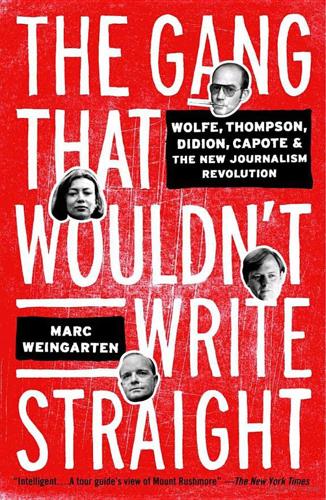
The Gang That Wouldn't Write Straight: Wolfe, Thompson, Didion, Capote, and the New Journalism Revolution
by
Marc Weingarten
Published 12 Dec 2006
But I felt that advertisers were buying a responsive audience and I could provide it for them.” Without Breslin’s moral conscience and Wolfe’s keen satirical eye, New York’s New Journalism was now being adulterated in the service of sensationalism. In the skillful hands of regulars such as Gail Sheehy or Julie Baumgold, New Journalism was a powerful tool, but it had to be wielded carefully. Given the freewheeling artistic license Felker permitted, the temptation to embellish the facts could be tempting. The first rule of New Journalism as laid down by Tom Wolfe, who published his anthology The New Journalism in 1973, was that whenever the style roamed freely, the facts had to be unassailable.
…
I’ve never seen any man or woman as ambitious as her.” (Felker and Sheehy were married in 1984.) For traditional journalists who disparaged New Journalism and regarded its biggest stars with skepticism and a twinge of jealousy, Sheehy’s gaffe was the beginning of the end of New Journalism. “New Journalism is rising,” the Wall Street Journal wrote, “but its believability is declining.” It was hard to dispute that, in the absence of a published disclosure or some explanation of Sheehy’s methods, “Redpants and Sugar-man” was New Journalism run amok. Sheehy wasn’t the only New York writer whose methods were called into question during the post-Breslin era.
…
“A willowy co-ed”: Tom Wolfe, “600 at NYU Stage Lusty Rent Strike,”New York Herald Tribune, April 13, 1962. “usual non-fiction narrator”: Wolfe and Johnson, eds., Tom Wolfe, “The New Journalism,”The New Journalism, 17. “Is that Joan Morse”: Wolfe, “The Saturday Route,”The Kandy-Kolored Tangerine-Flake Streamline Baby (New York: Farrar, Straus and Giroux, 1965), 223. “When I reached New York in the sixties”: Wolfe and Johnson, eds., Tom Wolfe, “The New Journalism,”The New Journalism, 30. “When great fame”: Tom Wolfe, The Pump House Gang (New York: Farrar, Straus and Giroux, 1968; Bantam edition, 1978), 8. “Here you are, boy, put your name right there”: Tom Wolfe, “The Marvelous Mouth,”Esquire, October 1963.
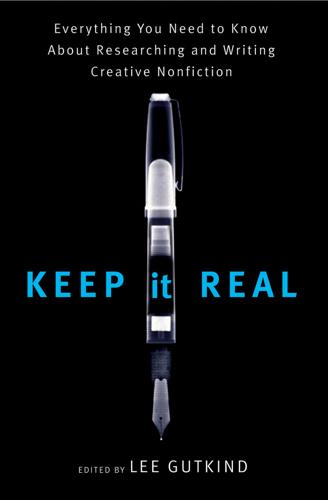
Keep It Real: Everything You Need to Know About Researching and Writing Creative Nonfiction
by
Lee Gutkind
Published 1 Jan 2008
I often refer to this combination as the parallel narratives of creative nonfiction; there is almost always a “public” and a “private” story. At one point in history this kind of writing gained popularity as the New Journalism, in large part because of Wolfe, who published a book of that title in 1973. In it, he declared that the New Journalism “would wipe out the novel as literature’s main event.” Gay Talese, in the introduction to Fame and Obscurity, his landmark collection of profiles of public figures including Frank Sinatra, Joe DiMaggio, and Peter O’Toole, describes the New Journalism thus: “Though often reading like fiction, [it] is not fiction. It is, or should be, as reliable as the most reliable reportage, although it seeks a larger truth than is possible through the mere compilation of verifiable facts, the use of direct quotations, and adherence to the rigid organizational style of the older form.”
…
Subjectivity In traditional journalism, reporters are supposed to be objective, to maintain the style of an omniscient, invisible presence. This objectivity is an essential component of journalistic integrity. But writers like Tom Wolfe or Joan Didion, proponents of New Journalism, rejected this notion; instead they and other writers accepted as necessary the presence, personality, and perceptions of the author. New Journalism and its literary descendants acknowledged and even celebrated the writer’s presence. The author/narrator interacts with other characters, comments upon events, and self-reflectively explores his or her personality in response to the developing story.
…
A few years later Norman Mailer’s nonfiction meditation on an antiwar rally at the Pentagon became The Armies of the Night, a work that won a Pulitzer Prize. Its subtitle, History as a Novel, the Novel as History, spoke to the crossing of two great currents as journalism met creative writing. A new genre, often referred to as New Journalism, began to emerge in American letters. Another starting point would be to look back into the mirror of literary history. Quickly we can locate a long tradition of creative nonfiction writings that lead in a direct line to the New Journalists of the twentieth century. We can find fascinating writing in Daniel Defoe’s The Storm, his researched account of the great hurricane that struck Britain in 1703.
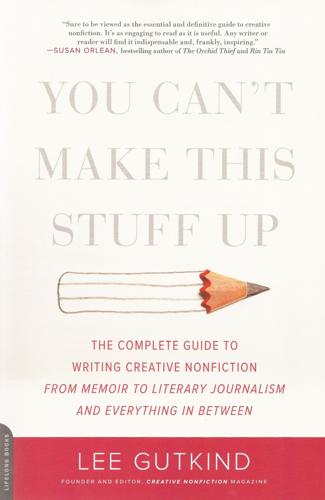
You Can't Make This Stuff Up: The Complete Guide to Writing Creative Nonfiction--From Memoir to Literary Journalism and Everything in Between
by
Lee Gutkind
Published 13 Aug 2012
And although most creative nonfiction contains a journalistic element (depending, of course, on how you define journalism), the assumption that all creative nonfiction was also journalism was inaccurate. Prior to the use of the term “creative nonfiction,” this kind of writing had gained popularity as the “new journalism,” due in large part to Tom Wolfe, who published a book by that title in 1973. But that term led to debate about the use of the word “new.” A.J. Liebling, George Orwell, James Baldwin, and Lillian Ross, to name only a few masters of the literature of reality, were publishing their work a half century before Tom Wolfe—so what was new about the “new journalism”? Recently the word “narrative”—as in “narrative journalism” and “narrative nonfiction”—has gained popularity. Everyone has personal stories or narratives: politicians, movie stars, businessmen and women.
…
See also Frame Narrative historians, recreation and Narrative journalism Narrative line Narrative nonfiction Narrator, trustworthiness of Nasar, Sylvia Nasdijj Nash, John National Book Award National Book Critics Awards National Endowment for the Arts Navel gazing New journalism The New Journalism (Wolfe) New Republic (magazine) Newsday (newspaper) Newspapers, reading Newsweek (magazine) The New Yorker (magazine) creative nonfiction in DeLillo article in Malcolm and McPhee and New York Herald Tribune (newspaper) New York (magazine) New York Observer (newspaper) New York Post (newspaper) New York Times Book Review (periodical) New York Times Magazine New York Times (newspaper) creative nonfiction in hoaxes and recreation and The Next American Essay (D’Agata) Nick Adams Stories (Hemingway) Nickel and Dimed (Ehrenreich) Nixon (film) Norton Note-taking Novels Nuland, Sherwin Nutmeg (Nathaniel) Obama, Barack Objectivity, creative nonfiction and Ohio University O magazine O’Malley, Walter The Omnivore’s Dilemma (Pollan) On Death and Dying (Kübler-Ross) One Children’s Place (Gutkind) One-on-one interviews On Looking (Purpura) On the Road (Kerouac) Opening paragraphs Opening Skinner’s Box (Slater) Oranges (McPhee) The Orchid Thief (Orlean) Orlean, Susan Orwell, George Other Press O’Toole, Peter Outlines Out of Africa (Dinesen) Page, P.
…
Poets and journalists are often in sync, seeking “larger truths.” FLEXIBILITY, FREEDOM, AND THE LARGER TRUTH Gay Talese, in the introduction to Fame and Obscurity (1970), his landmark collection of profiles of public figures including Frank Sinatra, Joe DiMaggio, and Peter O’Toole, described his work specifically and the new journalism generally, in this way: “Though often reading like fiction, it is not fiction. It is, or should be, as reliable as the most reliable reportage, although it seeks a larger truth [my italics] than is possible through the mere compilation of verifiable facts, the use of direct quotations, and adherence to the rigid organizational style of the older form.”
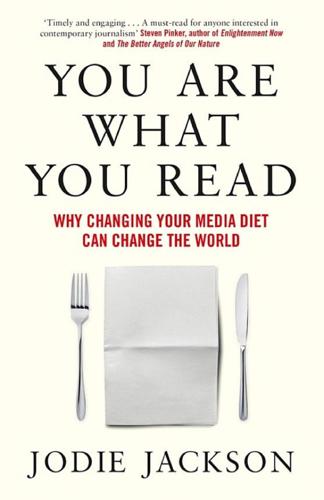
You Are What You Read
by
Jodie Jackson
Published 3 Apr 2019
Motivation and Emotion, 14(2), 1990, pp. 131–49. 3 Newhagen, J., ‘TV News Images that induce anger, fear and disgust: effects on approach-avoidance and memory’, Journal of Broadcasting and Electronic Media, 42(8), 1998, p. 267. 4 Pew Research Center for the People & the Press, 2010, quoted in Transition.fcc.gov, 2018, available at: https://transition.fcc.gov/osp/inc-report/INoC-20-News-Consumption.pdf 5 Haskins, J., ‘The Trouble with Bad News’, Newspaper Research Journal, 2(2), 1981, pp. 3–16, p. 11. 6 Horvit, B., ‘Combat, Political Violence Top International Categories’, Newspaper Research Journal, 24(2), 2003, pp. 22–35, p. 33. 7 Heath, L. and Gilbert, K., ‘Mass media and fear of crime’, American Behavioral Scientist, 39, 1996, pp. 379–86, p. 371. 8 Johnson, R., ‘Bad News Revisited: The Portrayal of Violence, Conflict, and Suffering on Television News’, Peace and Conflict: Journal of Peace Psychology, 2(3), 1996, pp. 201–16. 9 Wiles, A. and Wiles, A., Public perceptions of crime in England and Wales – Office for National Statistics, ons.gov.uk, 2018, available at: https://www.ons.gov.uk/peoplepopulationandcommunity/crimeandjustice/articles/publicperceptionsofcrimeinenglandandwales/yearendingmarch2016 10 Otieno, C., Spada, H. and Renkl, A., ‘Effects of News Frames on Perceived Risk, Emotions, and Learning’, Plos ONE, 8(11), 2013. 11 Jackson, J., ‘Publishing the Positive: Exploring the Motivations for and the Consequences of Reading Solutions-Focused Journalism’, MA thesis, University of East London, 2016, available at: https://www.constructivejournalism.org/wp-content/uploads/2016/11/Publishing-the-Positive_MA-thesis-research-2016_Jodie-Jackson.pdf 12 Johnston, W. and Davey, G., ‘The psychological impact of negative TV news bulletins: The catastrophizing of personal worries’, British Journal of Psychology, 88(1), 1997, pp. 85–91. 13 Mogg, K., Mathews, A. and Eysenck, M., ‘Attentional bias to threat in clinical anxiety states’, Cognition & Emotion, 6(2), 1992, pp. 149–59. 14 Jackson, ‘Publishing the Positive’. 15 Maier, S. and Seligman, M., ‘Learned helplessness: Theory and evidence’, Journal of Experimental Psychology: General, 105(1), 1976, pp. 3–46. 16 DeVellis, R., DeVellis, B. and McCauley, C., ‘Vicarious acquisition of learned helplessness’, Journal of Personality and Social Psychology, 36(8), 1978, pp. 894–99. 17 Levine, G., ‘“Learned Helplessness” and the Evening News’, Journal of Communication, 27(4), 1977, pp. 100–5. 18 Seligman, M., ‘Depression and learned helplessness’, in Friedman, R.J. and Katz, M. M. (eds), The Psychology of Depression: Contemporary Theory and Research, Winston, Washington, DC, 1974, pp. 83–113. 19 Veitch, R. and Griffitt, W., ‘Good News–Bad News: Affective and Interpersonal Effects’, Journal of Applied Social Psychology, 6(1), 1976, pp. 69–75. 20 Drew, D. and Reeves, B., ‘Children and Television News’, Journalism Quarterly, 57(1), 1980, pp. 45–114. 21 Leiner, M., Peinado, J., Villanos, M., Lopez, I., Uribe, R. and Pathak, I., ‘Mental and Emotional Health of Children Exposed to News Media of Threats and Acts of Terrorism: The Cumulative and Pervasive Effects’, Frontiers in Pediatrics, 4, 2016. 22 Unz, D., Schwab, F. and Winterhoff-Spurk, P., ‘TV News – The Daily Horror?’
…
Gender Differences in Processing Broadcast News’, Communication Research, 33(5), 2006, pp. 346–69. 12 One World Media, 2018 One World Media Award Winners, available at: https://www.oneworldmedia.org.uk/awards/winners/ 13 Robinson, M., in Patterson, T., The Vanishing Voter, Vintage, New York, 2003 p. 69. 14 Ibid., p. 70. 15 Drew, D. and Reeves, B., ‘Children and Television News’, Journalism Quarterly, 57(1), 1980, pp. 45–114. 16 Zuckerman, M., ‘The Psychophysiology of Sensation Seeking’, Journal of Personality, 58(1), 1990, pp. 313–45. 17 Johnson, ‘Bad News Revisited’. 18 Bourdieu, P., On Television and Journalism, Pluto Press, London, 1998. 19 Ibid. 20 Voices of Democracy, Theodore Roosevelt, ‘The Man with the Muck-Rake’, 2018, available at: http://voicesofdemocracy.umd.edu/theodore-roosevelt-the-man-with-the-muck-rake-speech-text/ 21 Ibid. 22 Slattery, K., Doremus, M. and Marcus, L., ‘Shifts in Public Affairs Reporting on the Network Evening News: A Move Toward the Sensational’, Journal of Broadcasting & Electronic Media, 45(2), 2001, pp. 290–302. 23 Emery, M., Emery, E. and Roberts, N., The Press and America, Allyn & Bacon, Boston, 2000, p. 350. 24 Meyer, R., ‘How Many Stories Do Newspapers Publish Per Day?’
…
Notes 1 Independent, ‘Website reports only good news for a day, loses two-thirds of its readers’, available at: https://www.independent.co.uk/news/world/europe/website-reports-only-good-news-for-a-day-loses-two-thirds-of-its-readers-9905916.html 2 Thussu, D., News as Entertainment, Sage, Thousand Oaks, CA, 2007. 3 Jackson, J., ‘Publishing the Positive: Exploring the Motivations for and the Consequences of Reading Solutions-Focused Journalism’, MA thesis, University of East London, 2016, p. 30, available at: https://www.constructivejournalism.org/wp-content/uploads/2016/11/Publishing-the-Positive_MA-thesis-research-2016_Jodie-Jackson.pdf 4 Scott, C., ‘5 key research findings about young online audiences from BBC World Service’, Journalism.co.uk, available at: https://www.journalism.co.uk/news/five-key-research-findings-about-young-online-audiences-from-bbc-world-service/s2/a588021/ 5 BBC News, ‘Four good things that happened in 2016’, 2018, available at: http://www.bbc.co.uk/news/world-38330452 6 Story-based Inquiry: A Manual for Investigative Journalists, Unesdoc.unesco.org, 2018, available at: http://unesdoc.unesco.org/images/0019/001930/193078e.pdf#193103 7 Jackson, ‘Publishing the Positive’. 8 Berger, J. and Milkman, K., ‘What Makes Online Content Viral?’, Journal of Marketing Research, 49(2), 2012, pp. 192–205. 9 Gyldensted, C., Innovating News Journalism Through Positive Psychology, unpublished MA thesis, Pennsylvania State University, 2011. 10 Fredrickson, B., Positivity, Crown Publishers, New York, 2009. 11 Jackson, ‘Publishing the Positive’. 12 Fredrickson, Positivity, p. 163. 13 Ibid. 14 Jackson, p. 29. 15 Cunningham, M., ‘Weather, mood, and helping behavior: Quasi experiments with the sunshine samaritan’, Journal of Personality and Social Psychology, 37(11), 1947–56; Berkowitz, L. and Connor, W., ‘Success, Failure and Social Responsibility’, Journal of Personality and Social Psychology, 4(6), 1979, 664–69. 16 Jackson, ‘Publishing the Positive’. 17 Ibid. 18 Ibid. 19 Ibid.
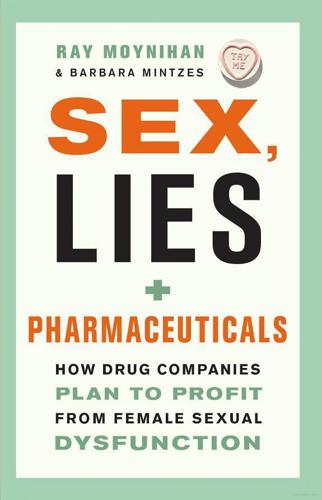
Sex, Lies, and Pharmaceuticals: How Drug Companies Plan to Profit From Female Sexual Dysfunction
by
Ray Moynihan
and
Barbara Mintzes
Published 1 Oct 2010
Such is the norm, as many medical journals rely heavily on drug company advertisements to fund them. As it happens, despite the glossy back cover featuring Pfizer’s ads, this new journal is relatively free of advertising compared with most. The Journal of Sexual Medicine would quickly become a place where much of the emerging science of FSD would be published, including studies funded by industry. It wasn’t just the researchers getting their articles in print who were celebrating. Drug company executives welcomed the new journal so effusively that the journal’s editors decided to note the industry’s endorsements on the journal website.29 Of two endorsements on the website in 2009, both came not from independent doctors or professional associations, but rather from drug company employees.
…
This is in fact a rate of self-citation many times higher than that of some of its competitor journals. The reasons, he speculated, were that his new journal had quickly become a ‘flagship’ for the field, and the material it published was highly important.32 Perhaps just a symptom of healthy competition between medical journals, this petty conflict also helps to show the rough and tumble out on the frontier of this new field of medical science. The creation of the new Journal of Sexual Medicine is certainly another pillar in the temple of the science of sexual disorders. It’s also become the official journal of the International Society for Sexual Medicine, or ISSM, another professional association happy to accept industry sponsorship of its activities.
…
A journal’s ‘impact factor’ comes in the form of a simple number, and is derived from how often articles from that journal are cited in other articles—including articles from the same journal. This practice is called ‘self-citation’. As the editor of the Archives of Sexual Behavior, a competing journal, has unkindly pointed out, the new Journal of Sexual Medicine has an impressive ‘impact factor’, but it also has a very high rate of self-citation. ‘For the narcissistically inclined, “Self Citations” is not a bad way to be noticed,’ wrote the editor, starting a minor skirmish in the world of sex journals.31 An associate editor of the Journal of Sexual Medicine hit back quickly, defending the high rate of self-citation in his journal and rejecting any suggestion that there was a policy encouraging self-citation among authors.
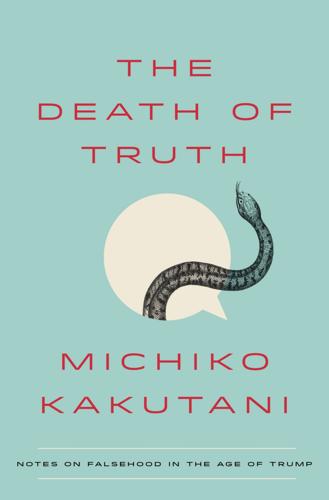
The Death of Truth: Notes on Falsehood in the Age of Trump
by
Michiko Kakutani
Published 17 Jul 2018
In a controversial 1989 essay, Tom Wolfe lamented these developments, mourning what he saw as the demise of old-fashioned realism in American fiction, and he urged novelists to “head out into this wild, bizarre, unpredictable, Hog-stomping Baroque country of ours and reclaim it as literary property.” He tried this himself in novels like The Bonfire of the Vanities and A Man in Full, using his skills as a reporter to help flesh out a spectrum of subcultures with Balzacian detail. But while Wolfe had been an influential advocate in the 1970s of the New Journalism (which put a new emphasis on the voice and point of view of the reporter), his new manifesto didn’t win that many converts in the literary world. Instead, writers as disparate as Louise Erdrich, David Mitchell, Don DeLillo, Julian Barnes, Chuck Palahniuk, Gillian Flynn, and Lauren Groff would play with devices (like multiple points of view, unreliable narrators, and intertwining story lines) pioneered decades ago by innovators like Faulkner, Woolf, Ford Madox Ford, and Nabokov to try to capture the new Rashomon-like reality in which subjectivity rules and, in the infamous words of former president Bill Clinton, truth “depends on what the meaning of the word ‘is’ is.”
…
The fixes, the scandals, the insanities, the treacheries, the idiocies, the lies, the pieties, the noise…” Roth’s sense that actuality was exceeding fiction writers’ imagination (and throwing up real-life figures like Richard Nixon and Roy Cohn who were the envy of any novelist) would be echoed more than half a century later by writers of satire and spy thrillers in the Trump era. And his observation that novelists were having difficulty dealing imaginatively with a world they felt to be confounding helps explain why journalism—particularly what Tom Wolfe called the New Journalism—began eclipsing fiction in capturing what life was like in the 1960s, as the Esquire anthology aptly titled Smiling Through the Apocalypse (featuring classic magazine pieces by such writers as Norman Mailer, Michael Herr, and Gay Talese) attested. * * * — Politicians had always spun reality, but television—and later the internet—gave them new platforms on which to prevaricate.
…
Stanley, Jason, How Propaganda Works (Princeton, N.J.: Princeton University Press, 2015). Timberg, Carl, Karla Adam and Michael Kranish, “Bannon Oversaw Cambridge Analytica’s Collection of Facebook Data, According to Former Employee,” Washington Post, Mar. 20, 2018. Wolfe, Tom, ed., The New Journalism (New York: Picador Books, 1975). Wolff, Michael, Fire and Fury: Inside the Trump White House (New York: Henry Holt & Co., 2018). Wood, Gordon S., The Radicalism of the American Revolution (New York: Vintage, 1993). Wylie, Christopher, “Why I Broke the Facebook Data Story—and What Should Happen Now,” Guardian, Apr. 7, 2018.
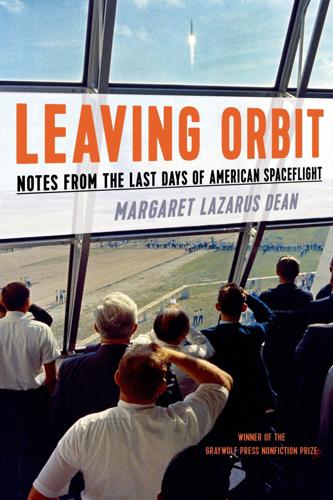
Leaving Orbit: Notes From the Last Days of American Spaceflight
by
Margaret Lazarus Dean
Published 18 May 2015
I laugh too, but I’m a bit shocked. These are the most basic facts, the ones I would have thought everyone would know. “Let’s get back to the structure of these chapters,” I say. “We’ve been talking about the New Journalism and Tom Wolfe’s idea that we should write in scenes wherever possible. What are some places in The Right Stuff where he chose not to do that?” But as we go on discussing Tom Wolfe and Norman Mailer and the New Journalism and the way in the sixties everyone thought they were reinventing everything, the optimism embodied in redefining literature once and for all, the optimism of sending human beings to space, two things become clear to me: my students did not grow up with the same idea of the sixties that I did.
…
Norman Mailer’s book is about witnessing the launch of Apollo 11—Life magazine had commissioned him to go to the Cape to write about the launch in exchange for a sum of money rumored to be somewhere between extraordinary and obscene. I hadn’t known, before I came across it, that Norman Mailer had written a book about Apollo 11—I knew him for having written the best-selling novel The Naked and the Dead, for cofounding the Village Voice and helping to spearhead New Journalism, for winning both the Pulitzer Prize and the National Book Award for The Armies of the Night, for running for mayor of New York and finishing fourth out of a field of five in the Democratic primary, and for stabbing his second wife, nearly to death, at a dinner party. But here, it seems, he had also written a book about spaceflight.
…
Thompson, James Agee, Tom Wolfe, Norman Mailer—important writers who were working in that moment in the sixties when literary journalism converged with a thread of creative writing and the genre we now call creative nonfiction was born. On the syllabus for tomorrow are selections from Tom Wolfe, who is rightfully credited with being one of the founding fathers of creative nonfiction by helping to define the New Journalism. I open the file and flip through pages covered with my notes from previous semesters. I stop on a random page from The Right Stuff. The passion that now animated NASA spread out even into the surrounding community of Cocoa Beach. The grisliest down-home alligator-poaching crackers manning the gasoline pumps on Route A1A would say to the tourists, as the No-Knock flowed, “Well, that Atlas vehicle’s given us more fits than a June bug on a porch bulb, but we got real confidence in that Redstone, and I think we’re gonna make it.”
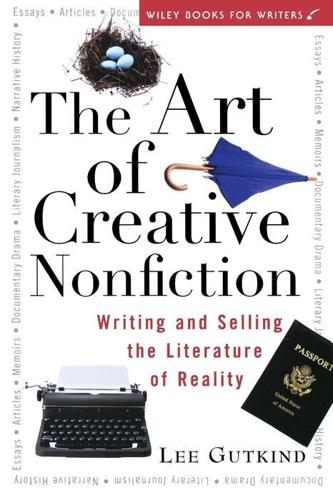
Art of Creative Nonfiction: Writing and Selling the Literature of Reality
by
Lee Gutkind
and
Purba
Published 1 Jan 1997
Page 8 The Creative Part Much of what is generically referred to as literary journalism can be classified as creative nonfiction. In the early 1960s, author and social commentator Tom Wolfe (The Right Stuff, The Electric Kool Aid Acid Test) coined a term that lasted for more than a decade-the "new journalism ." Wolfe's new journalism faded, but over the past five years creative nonfiction clearly has evolved as the accepted way of describing what is becoming the most important and popular genre in the literary world today. The best magazines-The New Yorker, Harper's, Vanity Fair, Esquire- publish more creative nonfiction than fiction and poetry combined.
…
Entries like I walked with an anguished and ecstatic heart and Monica looked celestial, panicked gain no accommodation under the obligatory smile. It imprisons our fairer history. Like our disposable horror at each day's headlines, it excuses us falsely from all we are and do. Page 210 Page 211 Lee Gutkind Lee Gutkind, founder and editor of the popular new journal Creative Nonfiction, has performed as a clown for Ringling Brothers, scrubbed with heart and liver transplant surgeons, traveled with a crew of National League baseball umpires, wandered the country on a motorcycle, and experienced psychotherapy with a distressed family-all as research for eight books and numerous profiles and essays.
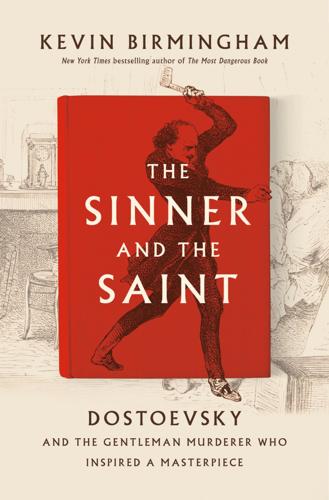
The Sinner and the Saint: Dostoevsky and the Gentleman Murderer Who Inspired a Masterpiece
by
Kevin Birmingham
Published 16 Nov 2021
Throughout all of this, Dostoevsky and his brother were trying to start a new journal, and he encouraged Mikhail to borrow nine thousand rubles from their aunt (“letting a really brilliant enterprise go under is nearly a crime”). The idea was to extend the work that Vremya had begun. Dostoevsky wanted to call it Pravda (Truth), which he thought captured the faith and naïveté that their readers valued. The brothers were indeed naïve enough not to anticipate the authorities’ swift rejection of such a presumptuous title, so Mikhail named their new journal Epokha—Epoch. They tried learning from past mistakes. They found a government official to serve as a nominal editor in chief in order to help shield them from powerful rivals like Katkov.
…
Staff meetings were in the afternoon and normally involved scouring periodicals and arguing during tea breaks. They circulated their mission statement widely. “We live in an epoch in the highest degree remarkable and critical,” it began. “Russia is in the midst of a great transformation,” the combination of European and Russian culture, the “fusion of enlightenment” with “the people’s life.” Their new journal would help Russians navigate this transformation. It was a monthly, and they called it Vremya (Time). Dostoevsky wrote the statement, but his name did not appear below it. His name was not on Vremya’s masthead, either, because ex-convicts were not allowed to edit journals. The first issue (January 1861) included an excerpt from Casanova’s memoirs, an overview of 1860’s biggest political events, and Dostoevsky’s encomium to the Russian character.
…
They embarked upon the now-familiar work of creating and printing advertisements (“We need to repeat them, to wear people out with advertisements”) and finding contributions, including a story from Turgenev, “Phantoms,” and another from Suslova, “One’s Own Way.” It is “no worse than her earlier ones,” Dostoevsky told Mikhail. Dostoevsky began working on a novella to help boost the new journal’s subscriptions, but he was struggling. “The whole story is junk,” he wrote to Mikhail in February. His seizures continued, and the onset of another illness made matters worse. He wasn’t quite sure what was wrong with him. “Hemorrhoids have attacked my bladder,” he told Mikhail. A doctor later informed him that his prostate was inflamed and that he might have an abscess.
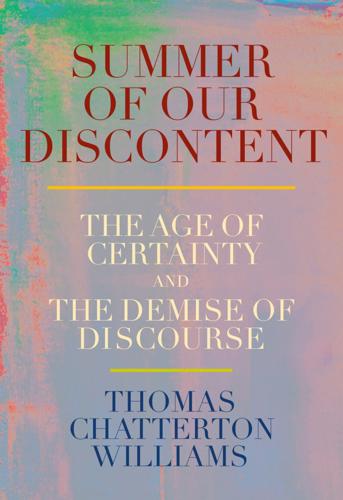
Summer of Our Discontent: The Age of Certainty and the Demise of Discourse
by
Thomas Chatterton Williams
Published 4 Aug 2025
ep_prh_7.3a_152578891_c0_r0 Contents Dedication Epigraph Preface Prologue 1. The First “Black” President and the Failure (or Fear) of Post-racialism 2. Donald Trump and the State of Exception 3. The Plague 4. The Death of George Floyd and the Cult of “Antiracism” 5. The New New Journalism: Media in the Age of “Moral Clarity” 6. “Fiery but Mostly Peaceful Protests” 7. We Are All Americans Now: “Antiracism” Goes Global in the Age of Social Media 8. “Cancel Culture” and Its Discontents 9. The Spectacle of January 6 Afterword Acknowledgments A Note About the Author _152578891_ For Valentine: Merci pour tout—toujours.
…
The decision to remove the fencing follows the installation of massive stainless steel walls that function like hinged airplane hangar doors, which will allow the building to withstand most thrown projectiles.” Aimee Plante, “Federal Courthouse in Downtown Portland Removes Fence Erected During 2020 Protests,” KOIN, June 19, 2024. *23 Before his white antifa killer was hunted down days later in a motel and shot to death by federal agents. Chapter Five The New New Journalism: Media in the Age of “Moral Clarity” The late French critic and philosopher René Girard’s mimetic theory, and his notion of the scapegoat as an enduring mechanism of social control, has found much renewed interest in recent years among writers, scholars, and cultural observers attempting to make sense of the sheer energy and viciousness that have been unleashed on uncountable targets in the era of social media.
…
In a town hall meeting in 2019, he explained, “We built our newsroom to cover one story, and we did it truly well. Now we have to regroup, and shift resources and emphasis to take on a different story.”[*19] In other words, once the Pandora’s box of monetizable TDS had been cracked open, the crusading new journalism that eschewed the antiquated ideal of objectivity, and explicitly sought to reduce all aspects of American politics and society to questions of social justice, racial injury, and disparity, was a convenient fit for the broader demands of a new business model within an evolving media landscape.
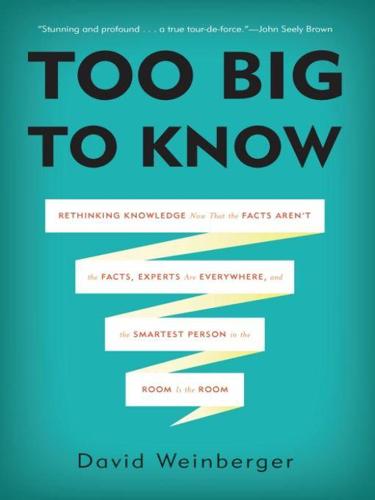
Too Big to Know: Rethinking Knowledge Now That the Facts Aren't the Facts, Experts Are Everywhere, and the Smartest Person in the Room Is the Room
by
David Weinberger
Published 14 Jul 2011
id=mZ48 AAAAYAAJ), and cited by John Beatty in his review of “Fair and Balanced: A History of Journalistic Objectivity,” Journalism and Mass Communication Quarterly: Association for Education in Journalism and Mass Communications 83, no. 1 (April 2006), http://vlex.com/vid/fair-balanced-journalistic-objectivity-61539404.The historian Sheila McIntyre links the concern for fairness and accuracy back to the role of ministers in the seventeenth century as reporters and distributors of news; see Sheila McIntyre, “‘I Heare It So Variously Reported’: News-Letters, Newspapers, and the Ministerial Network in New England, 1670–1730,” New England Quarterly 71, no. 4 (December 1998), pp. 593–614, http://www.jstor.org/stable/366604. 27 The obvious source for the New Journalism is The New Journalism, edited by Tom Wolfe and Edward Warren Johnson (Harper & Row, 1973). 28 Jay Rosen, “Questions and Answers About PressThink,” http://journalism.nyu.edu/pubzone/weblogs/pressthink/2004/04/29/q_and_a.html. 29 Malcom Gladwell, “Small Change: Why the Revolution Will Not Be Tweeted,” New Yorker, October 4, 2010, http://www.newyorker.com/reporting/2010/10/04/101004fa_fact_gladwell.
…
As we have lost faith in objectivity (a process that began before the Net arrived), transparency has begun to do much of the work formerly accomplished by it. Transparency comes in at least two flavors. Transparency about the reporter’s standpoint has been a topic in journalism at least since the “New Journalism” of the 1970s and the “gonzo journalism” practiced by Hunter S. Thompson.27 For example, Jay Rosen’s blog not only takes explicit stands, it has a prominent link to “Q & A about the blog’s POV” that lays out his point of view about journalism and tells us that politically he’s a “standard Upper West Side Liberal Jewish babyboomer.”28 The ease with which readers can look up information about an author can make their standpoints transparent even if they don’t want them to be.
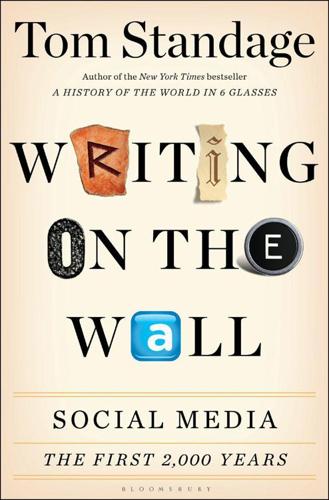
Writing on the Wall: Social Media - the First 2,000 Years
by
Tom Standage
Published 14 Oct 2013
Further inspiration came in a letter from a correspondent in Paris, who informed Oldenburg of a plan to publish a printed journal of “all what passeth in Europe in matters of knowledge both philosophical and political,” including book reviews, obituaries of notable people, news from libraries and universities, accounts of new scientific discoveries and artistic achievements, and noteworthy legal rulings. Given his excellent connections, Oldenburg had been asked to contribute to this new journal as its correspondent in England, in return for receiving a copy of each issue. This astonishingly ambitious publication was the Journal des Sçavans (the “Journal for Learned People”), the first issue of which appeared in January 1665. It inspired Oldenburg to do something similar, but focused specifically on scientific endeavors.
…
People who could not attend Royal Society meetings would be able to read about what had happened, build upon the results of others, and then send in their own papers to be read out at the meetings and published in the journal. As well as broadening participation in the society’s distributed community, the new journal would provide a permanent record of the society’s activities and, as a consequence, of the progress of scientific knowledge. Crucially, from the point of view of participants in the discussion that took place within its pages, the journal would also act as a neutral public forum in which scientists could claim priority for their work.
…
Although the journal was published with the approval of the Royal Society, the perpetually cash-strapped Oldenburg was allowed to run it as a private commercial venture, and he hoped it would provide him with a steady income. But after just five issues an outbreak of the plague in London in July 1665 held up the printing and distribution of the new journal. The Great Fire of London the following year caused further difficulties, because unsold copies had been stored in Saint Paul’s Cathedral for safety, along with many books, and all were destroyed when it burned down. Oldenburg also became embroiled in a seemingly endless series of disputes with printers about pricing and distribution, and was repeatedly forced to reduce his share of the sales revenue in order to keep the journal afloat.
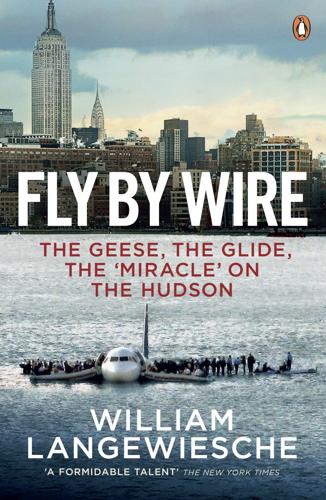
Fly by Wire: The Geese, the Glide, the Miracle on the Hudson
by
William Langewiesche
Published 10 Nov 2009
His strong, evocative prose is used to devastating effect on a range of issues. Before embarking on a writing career he worked as a pilot for fifteen years from the age of eighteen. He has been termed one of the leading writers of The New New Journalism, a group of writers who have secured a place at the centre of contemporary American literature, as Tom Wolfe and The New Journalism did in the sixties. ALSO BY WILLIAM LANGEWIESCHE Cutting for Sign Sahara Unveiled Aloft American Ground The Outlaw Sea The Atomic Bazaar FLY BY WIRE The Geese, The Glide, The ‘Miracle’ on the Hudson WILLIAM LANGEWIESCHE PENGUIN BOOKS PENGUIN BOOKS Published by the Penguin Group Penguin Books Ltd, 80 Strand, London WC2R 0RL, England Penguin Group (USA) Inc., 375 Hudson Street, New York, New York 10014, USA Penguin Group (Canada), 90 Eglinton Avenue East, Suite 700, Toronto, Ontario, Canada M4P 2Y3 (a division of Pearson Penguin Canada Inc.)

Gonzo: The Life of Hunter S. Thompson
by
Corey Seymour
,
Johnny Depp
and
Jann S. Wenner
Published 31 Oct 2007
I called Hunter up from out of the blue, and he sent me some tapes he had recorded at that crazy party, which was really generous of him. JANN WENNER Hunter appreciated New Journalism and read its practitioners. He felt part of that fraternity of Wolfe, Talese, and Halberstam, whom he was very fond of, and Eszterhas as well. He knew he was different from them, but he also knew that he was one of the writers of that era who formed the fraternity. Of them all, he was the most unique: He was the wild man, and he was the genius. WILLIAM KENNEDY He liked the idea of being part of the New Journalism—and Tom Wolfe did include him in his book that codified that genre—but Hunter wanted more; he wanted to transcend it, and he did.
…
He used to mark up pages of favorite books, underlining phrases that impressed him. On page sixty-two of The Web and the Rock he found “fear and loathing” and made it his. I asked him why he didn’t give Wolfe credit. Essentially he said it was too much of a hassle, that people would think he meant Tom Wolfe, his New Journalism contemporary. Not many of his friends knew this. His Aspen buddy Dan Dibble did. Maybe a couple of others. JOE EDWARDS After Hunter’s run for sheriff, he joined some law enforcement organizations and started getting all sorts of literature sent to him. One was this thing about a district attorneys’ convention about drug enforcement that was going to be held in Las Vegas.
…
Joe was jealous, but Hunter never seemed to feel that at all. He never did anything but treat Joe in the most magnanimous and generous fashion, as he treated everybody. Likewise, Joe was deeply respectful of Hunter’s talent and charm. Tom Wolfe had a great deal of respect for Hunter and wrote wonderful things about him in his New Journalism anthology. I introduced them to each other for the first time when they were both writing for Rolling Stone. In fact, the first installment of the Rolling Stone version of “The Right Stuff” opens with a lede passage that’s an homage to Hunter’s style. TOM WOLFE Hunter had been very kind to me when I was writing The Electric Kool-Aid Acid Test.
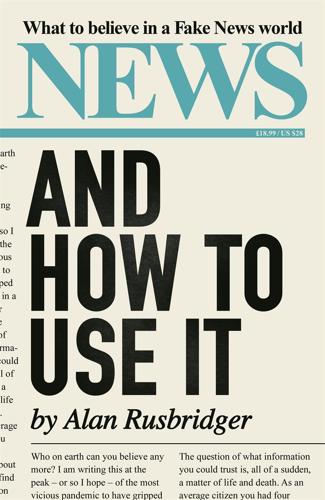
News and How to Use It: What to Believe in a Fake News World
by
Alan Rusbridger
Published 26 Nov 2020
Media Matters for America, 1 July 2014. <https://www.mediamatters.org/new-york-times/how-iraq-war-still-haunts-new-york-times> Bollinger, Lee C. Uninhibited, Robust, and Wide-Open: A Free Press for a New Century. First edition. Oxford and New York: Oxford University Press, 2010. Boynton, Robert S. The New New Journalism: Conversations with America’s Best Nonfiction Writers on Their Craft. New York: Vintage, 2005. Brainard, Curtis. ‘Wanted: Climate Front-Pager’. Columbia Journalism Review, 7 July 2010. <https://www.cjr.org/the_observatory/wanted_climate_frontpager.php> Brendon, Piers. The Life and Death of the Press Barons.
…
<https://www.theguardian.com/books/2016/may/23/all-be-murdered-beds-shocking-history-crime-reporting-britain-duncan-campbell-review> Murgia, Madhumita. ‘How data brokers sell your identity’. TEDxExeter, April 2017. <https://www.ted.com/talks/madhumita_murgia_how_data_brokers_sell_your_identity> Murphy, James E. ‘The New Journalism: A Critical Perspective. Journalism Monographs, No. 34’. Association for Education in Journalism, May 1974. The New York Times. ‘1992 Pulitzer Prize Winners and Their Works in Journalism and the Arts’. 8 April 1992. <https://www.nytimes.com/1992/04/08/nyregion/1992-pulitzer-prize-winners-and-their-works-in-journalism-and-the-arts.html> The New York Times.
…
<https://us6.campaign-archive.com/?u=8afce7db3efb3457925a48c26&id=5f04d706fb> Wojdynski, Bartosz W. ‘The Deceptiveness of Sponsored News Articles: How Readers Recognize and Perceive Native Advertising’. American Behavioral Scientist, Vol. 60 Issue 12, 2016. <https://doi.org/10.1177/0002764216660140> Wolfe, Tom. The New Journalism. Reprints edition. London: Picador, 1990. Wolff, Michael. Fire and Fury: Inside the Trump White House. First edition. New York: Henry Holt and Co., 2018. Wynne, Brian. ‘Creating Public Alienation: Expert Cultures of Risk and Ethics on GMOs’. Science as Culture, Vol. 10 No. 4, 2001. <https://www.tandfonline.com/doi/abs/10.1080/09505430120093586> Acknowledgements Several friends, colleagues and former colleagues helped shape and contribute to this book in numerous ways.
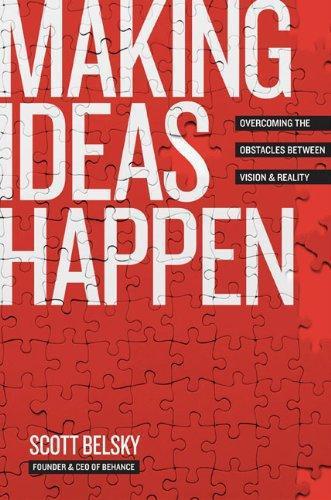
Making Ideas Happen: Overcoming the Obstacles Between Vision and Reality
by
Scott Belsky
Published 31 Mar 2010
Aside from Currey’s own story of perspiration yielding a positive outcome, the interview excerpts and articles cataloged on Daily Routines offer insight into how developing a consistent daily regimen for execution can help us make ideas happen. It was on Daily Routines that I discovered this interview with Michael Lewis, author of the best-selling books Moneyball and Liar’s Poker, from Robert Boynton’s The New New Journalism: Conversations with America’s Best Nonfiction Writers on Their Craft. HOW DO YOU BEGIN WRITING? Fitfully. I’ll write something, but it won’t be the beginning or the middle or the end—I’m just getting an idea out on the page. Then, as the words accumulate, I start thinking about how they need to be organized.
…
Miramax mistakes, taking advantage of Mizrahi, Isaac momentary injustice Monet, Claude Moneyball (Lewis) Moore, Geoffrey MTV multitasking MySpace Music N nagging (Darwinian prioritization) Nair, Archan Naked Communications National September 11 Memorial Museum Netflix networks New New Journalism, The: Conversations with America’s Best Nonfiction Writers on Their Craft (Boynton) New Work City New York Times Nickell, Jake Nietzsche, Friedrich Nike 99% Conference NoahBrier.com Nokia Norman, Donald note taking O O’Callahan, Jay organization competitive advantage of impact and structure and work routines P Palm V Palmer, Benjamin Panasonic partnerships passion Patagonia Patterson, James Peace Corps Pentagram personal advisory boards perspective perspiration Edison on “Phylotaxis” Piano, Renzo Pine Street Pissarro, Camille play Poetics of Music in the Form of Six Lessons (Stravinsky) Pop!
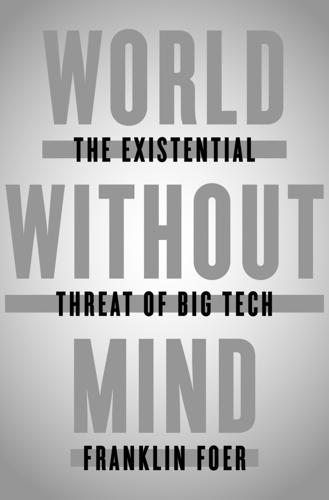
World Without Mind: The Existential Threat of Big Tech
by
Franklin Foer
Published 31 Aug 2017
Over the years, Kay would lavishly credit Brand for pointing toward the future: “For us at PARC, he was the guy who was giving us the early warning system about what computers were going to be.” Having absorbed Brand into their work, the PARC engineers let him hang out in their lab. He would describe what he saw in a seminal article that he wrote for Rolling Stone in 1972. The article was a vivid, energetic piece of New Journalism: “The most bzz-bzz-busy scene I’ve been around since Merry Prankster Acid Tests.” Brand depicted the computer scientists exactly as he wanted to see them—as the great emancipators of technology: “Those magnificent men with their flying machines, scouting a leading edge of technology which has an odd softness to it; outlaw country, where rules are not decree or routine so much as the starker demands of what’s possible.”
…
CHAPTER FIVE: KEEPERS OF THE BIG GATE IN THE SKY “Seven years of declining revenues will give you new ideas”: Staci D. Kramer, “Don Graham on the Sale of The Washington Post, Jeff Bezos, and the Pace of Newsroom Innovation,” NiemanLab, August 6, 2013. White had struck up a correspondence with an editor: David Manning White, “The ‘Gate Keeper’: A Case Study in the Selection of News,” Journalism Quarterly 27 (December 1950): 383–90. “So long as there is interposed between the ordinary citizen and the facts”: Walter Lippmann, Liberty and the News (Harcourt, Brace and Howe, 1920), 7. “The newspaper’s duty is to its readers and to the public at large”: John B. Judis, The Paradox of American Democracy (Pantheon, 2000), 23.
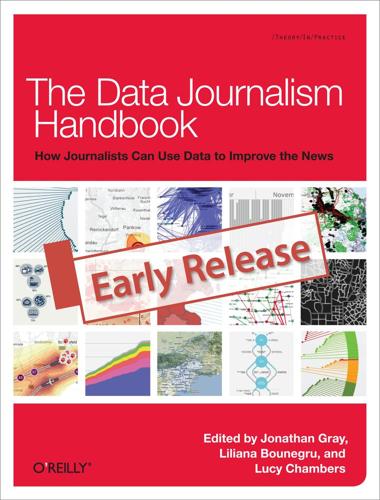
The Data Journalism Handbook
by
Jonathan Gray
,
Lucy Chambers
and
Liliana Bounegru
Published 9 May 2012
In the early 1970s the term precision journalism was coined to describe this type of news-gathering: “the application of social and behavioral science research methods to the practice of journalism” (from The New Precision Journalism by Philip Meyer; http://bit.ly/precision-journalism). Precision journalism was envisioned to be practiced in mainstream media institutions by professionals trained in journalism and social sciences. It was born in response to “new journalism,” a form of journalism in which fiction techniques were applied to reporting. Meyer suggests that scientific techniques of data collection and analysis, rather than literary techniques, are what is needed for journalism to accomplish its search for objectivity and truth. Precision journalism can be understood as a reaction to some of journalism’s commonly cited inadequacies and weaknesses: dependence on press releases (later described as “churnalism”), bias towards authoritative sources, and so on.
…
There are lots of others out there too, including: Chartsbin, a tool for creating clickable world maps iCharts, which specializes in small chart widgets Geocommons, which shares data and boundary data to create global and local maps Oh, and there’s also piktochart.com, which provides templates for those text/numbers visualizations that are popular at the moment. — Simon Rogers, the Guardian How We Serve Data at Verdens Gang News journalism is about bringing new information to the reader as quickly as possible. The fastest way may be a video, a photo, a text, a graph, a table, or a combination of these. Concerning visualizations, the purpose should be the same: quick information. New data tools enable journalists to find stories they couldn’t otherwise find, and present stories in new ways.
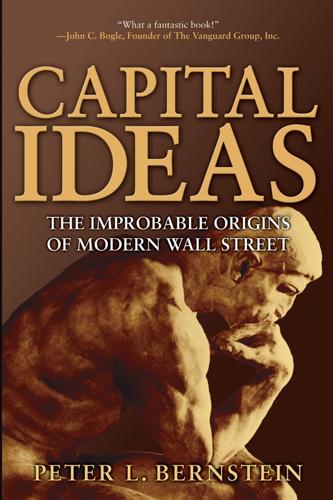
Capital Ideas: The Improbable Origins of Modern Wall Street
by
Peter L. Bernstein
Published 19 Jun 2005
He had drafted a major paper on the subject titled “The Theory of Rational Option Pricing.” While Merton was considering where to send his paper for publication, a colleague at the Sloan School, Paul McAvoy, had recently become editor of a new journal to be published by the Bell Laboratories, the research arm of the American Telephone Company. McAvoy expressed interest in Merton’s work, even though Merton warned him that it was “pretty thick” and would probably run to about forty pages in print. McAvoy, eager to get his new journal off the ground, said, “We’ll publish any size paper. We’ll also pay you $500 for the manuscript.” This was irresistible bait for a young assistant professor still earning a starting salary of $11,500.24 Merton was reluctant to have his article appear ahead of Black and Scholes’s main paper, because his paper drew on and commented on theirs.
…
The Commission, sponsored and supervised by an advisory council consisting of members of the Econometric Society, remained in Colorado Springs until it moved to Chicago in 1939; under Nobel laureate James Tobin’s direction, it later moved to Yale. The Commission was home to Nobel laureate Harry Markowitz in the 1950s and is still home to many other famous scholars. Plans were also made to establish the new journal, to be called Econometrica. That journal is now nearly sixty years old and commands wide respect among economists, statisticians, and mathematicians. The first issue of Econometrica, which appeared in January 1933, contained an introductory article by the famous Harvard economist and the first president of the Econometric Society, Joseph Schumpeter, as well as a timely paper by Irving Fisher titled “The Debt-Deflation Theory of Great Depressions.”
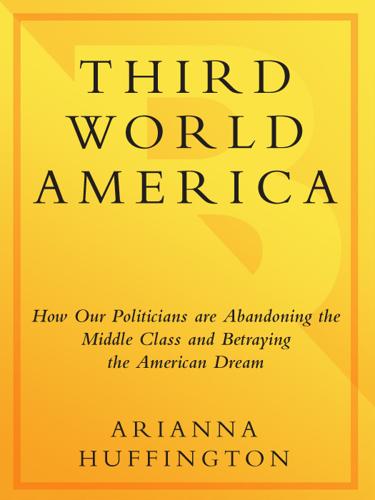
Third World America: How Our Politicians Are Abandoning the Middle Class and Betraying the American Dream
by
Arianna Huffington
Published 7 Sep 2010
In the last chapter of Michael Herr’s Dispatches, he speaks of conventional journalism’s inability to “reveal” the Vietnam War: “The press got all the facts (more or less).…20 But it never found a way to report meaningfully about death, which of course was really what it was all about.” And Tom Wolfe, in “The Birth of ‘The New Journalism’: Eyewitness Report,” discusses conventional journalism’s inability to capture the turbulence of the 1960s: “You can’t imagine what a positive word ‘understatement’ was among both journalists and literati.…21 The trouble was that by the early 1960s understatement had become an absolute pall.” Well, it’s happening again—we are failing to capture the turbulence of our times with narratives that allow the public, and force our leaders, to connect with the pain and suffering that should be fueling the fight to change direction while there’s still time.
…
Workers Across Household Income Groups at the End of the Great Recession,” Feb. 2010, www.clms.neu.edu. 18 These numbers, according to: Robert Frank, “High Unemployment? Not for the Affluent,” 12 Feb. 2010, www.wsj.com. 19 “These are the kinds …”: Bob Herbert, “The Worst of the Pain,” 9 Feb. 2010, www.nytimes.com. 20 In the last chapter of: Michael Herr, Dispatches, 5th ed. (New York: Knopf, 2009), 201. 21 And Tom Wolfe: Tom Wolfe, “The Birth of ‘The New Journalism’: Eyewitness Report by Tom Wolfe,” New York magazine, 14 Feb. 1972, 38. 22 So, in 1845, he wrote: Benjamin Disraeli, Sybil, or the Two Nations (London: Macmillan, 1895), 74. 23 Forty years ago, top executives: Kenneth Dodge, “Make CEOs Help the Little Guy,” Pittsburgh Post-Gazette, 7 Feb. 2010, www.post-gazette.com. 24 Between 2007 and 2008, more than: Derek Douglas and Almas Sayeed, “An Ever Increasing Divide,” Center for American Progress, 1 Sep. 2006, www.americanprogress.org. 25 In 2005, households: Ibid. 26 In 2007, the top 10 percent: Henry Blodget, “The Rich Get Richer and the Poor Get … Fired,” 13 Aug. 2010, www.businessinsider.com. 27 Between 2000 and 2008, the poverty rate: “The Suburbanization of Poverty: Trends in Metropolitan America, 2000 to 2008,” 20 Jan. 2010, www.brookings.edu. 28 Almost one hundred million Americans: Matt Miller, “The Upside of Downward Mobility,” 29 Dec. 2010, www.money.cnn.com. 29 The percentage of Americans: Economic Mobility Project, “Getting Ahead or Losing Ground: Economic Mobility in America,” Feb. 2010, www.economicmobility.org. 30 If you were born: Ibid. 31 In a study of economic mobility: Isabel Sawhill and John E.

Microsoft Office Outlook 2010 QuickSteps
by
Malestrom
From 2 For faster connections, there’s speed dialing. Of course, you first need to enter the numbers. the context menu that appears, click the Call arrow to display the Call submenu. 5 9. Click Speed Dial and choose a number. The New Call dialog box appears. 6 TIP 10. Proceed as described earlier in “Phone a Contact.” Click the Create New Journal Entry When Starting A New Call check box in the New Call dialog box if you want Outlook to time the call while you type notes. When click Save & Close. See a Map for a Contact’s Address If you have an Internet connection, you can use Outlook 2010 to obtain a map and get directions to an address you have recorded in your list of contacts.
…
The results of the timer appear in the Duration field in even-minute increments. Click Pause Timer to stop the timer. You can add time to the existing time in the Duration field by clicking Start Timer again; reset the timer by clicking the Duration down arrow and clicking 0 Minutes. 5 7. Click Save & Close. The new journal entry appears in your Figure 7-3: Creating a journal entry allows you to track the time you spend on important activities. 6 journal. Change a Journal Entry The Timer feature works great for items that need to be timed for billing purposes, such as consultation meetings Journal entries, like most anything else you might record in Outlook, may need to be changed.

The Great Wave: The Era of Radical Disruption and the Rise of the Outsider
by
Michiko Kakutani
Published 20 Feb 2024
There is “no novelist,” Wolfe wrote, “who will be remembered as the novelist who captured the Sixties in America, or even in New York, in the sense that Thackeray was the chronicler of London in the 1840’s and Balzac was the chronicler of Paris and all of France after the fall of the Empire.” It was a state of affairs, he added with a touch of glee, that opened the way for the sort of narrative nonfiction that became known as “the New Journalism,” which borrowed storytelling methods from the old-fashioned novel (careful scene construction, lots of overheard dialogue, and pictorial descriptions with plenty of “status details”) and which was practiced by the likes of himself, Joan Didion, Norman Mailer, and Gay Talese. In a 1961 essay, Philip Roth wrote that there had been a “voluntary withdrawal of interest by the writer of fiction from some of the grander social and political phenomena of our times.”
…
Thompson, Helen, Disorder: Hard Times in the 21st Century (New York: Oxford University Press, 2022). Tooze, Adam, Crashed: How a Decade of Financial Crises Changed the World (New York: Penguin Books, 2018). Wilson, Colin, The Outsider (New York: Jeremy P. Tarcher/Putnam, 1982). Wolfe, Tom, ed., The New Journalism (New York: Picador Books, 1975). Wu, Tim, The Master Switch: The Rise and Fall of Information Empires (New York: Vintage Books, 2010). By Michiko Kakutani The Great Wave: The Era of Radical Disruption and the Rise of the Outsider The Death of Truth: Notes on Falsehood in the Age of Trump Ex Libris: 100+ Books to Read and Reread The Poet at the Piano: Portraits of Writers, Filmmakers, Playwrights, and Other Artists at Work PHOTOGRAPHS The Tale of the Mandarin Duck: A Modern Fable (by Bette Midler) About the Author Michiko Kakutani is a Pulitzer Prize–winning literary critic and the former chief book critic of The New York Times.
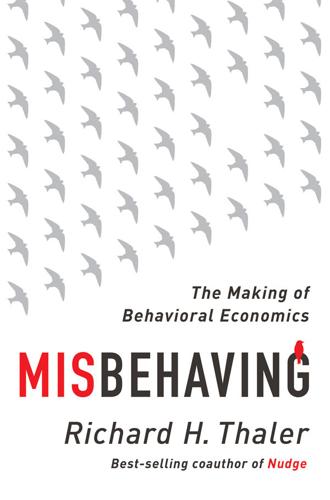
Misbehaving: The Making of Behavioral Economics
by
Richard H. Thaler
Published 10 May 2015
Each rejection came with a set of referee reports, with often scathing comments that I would try to incorporate in the next revision. Still, I did not seem to be making any progress. At some point I had to get this paper published, if for no other reason than that I needed to move on. Luckily, two open-minded economists were starting a new journal called the Journal of Economic Behavior and Organization. I guessed that they were anxious to get submissions, so I sent the paper to them and they published it in the inaugural issue. I had my first behavioral economics publication, albeit in a journal no one had ever heard of. If I were going to stay in academia and get tenure at a research-focused university like Cornell, I would have to start publishing regularly in top journals.
…
At exactly the right time and place in my life, an opportunity to compile and document such a list of anomalies fell into my lap, and I had the good sense to seize the chance. Sometime after returning to Ithaca from my year in Vancouver, I was at a conference sitting next to the economist Hal Varian, then a well-known theorist who later went on to become the chief economist at Google. Hal was telling me about a new journal that the American Economic Association was starting called the Journal of Economic Perspectives. Hal was an advisory editor. The editorial board was thinking about commissioning regular features for the journal. The clever Barry Nalebuff would write one on economics-based brainteasers and puzzles.
…
That meant that these columns were taking time away from what most academics would consider to be “real research,” meaning discovering new facts, developing new theories, and publishing papers in refereed journals.* The potential payoff, however, was huge. The AEA at one point conducted a survey of its members to see what they thought of the new journal. They asked members whether they read it and specifically whether they read the features. Half the members of the AEA who responded to the survey reported that they read the “Anomalies” feature “regularly,” whatever that means. To put this in perspective, the average article written in a specialized academic journal is probably lucky to find 100 readers.
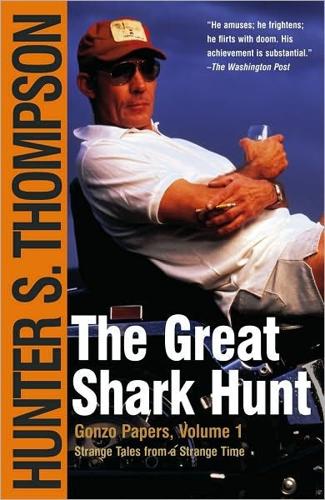
The Great Shark Hunt: Strange Tales From a Strange Time
by
Hunter S. Thompson
Published 6 Nov 2003
Truth outstripping fiction in work of Mailer, Thompson, Wolfe, etc. From The Journal of Popular Culture, Summer 1975: "Gonzo," James Green, pp. 204-20. "The Freaking New Journalism," Kent Jacobson, pp. 183-96 Discusses Kentucky Derby article. ''There Shall Be No Night," Elizabeth Landreth, pp. 197-203. Discusses Thompson's views of Las Vegas as seen in Fear & Loathing in Las Vegas. "We've Been Had By the New Journalism: A Put Down," Robert J. VanDellen, p. 219. Discusses Kentucky Derby article. "Fear and Loathing at Rolling Stone," Sandy Rovner, Washington Post, May 30, 1975, B, p. 3. Short article on Thompson's departure from Rolling Stone.
…
I have all of 1972 to fuck around with Nixon, so why hassle it here? Anyway, the main point I want to make about Fear & Loathing is that although it's not what I meant it to be, it's still so complex in its failure that I feel I can take the risk of defending it as a first, gimped effort in a direction that what Tom Wolfe calls "The New Journalism" has been flirting with for almost a decade. Wolfe's problem is that he's too crusty to participate in his stories. The people he feels comfortable with are dull as stale dogshit, and the people who seem to fascinate him as a writer are so weird that they make him nervous. The only thing new and unusual about Wolfe's journalism is that he's an abnormally good reporter; he has a fine sense of echo and at least a peripheral understanding of what John Keats was talking about when he said that thing about Truth & Beauty.
…
"Nonstudent Left," Nation, September, 27, 1965 (v. 201), pp. 154-58 Study of Berkeley campus, Free Speech Movement and California's response; the non-student population, its ethos and effects. "Collect Telegram from a Mad Dog," Spider Magazine, October 13, 1965, Poem. Hell's Angels: A Strange and Terrible Saga, New York: Random House, 1966. "Life Styles: the Cyclist," Esquire, January 1967 (v. 67), pp. 57-63. Excerpt from Hell's Angels. "Hell's Angels," The New Journalism, Tom Wolfe, New York: Harper & Row, 1973, pp. 340-55. Excerpt from Hell's Angels, with notes by Tom Wolfe. "The 'Hashbury' Is the Capital of the Hippies," New York Times Magazine, May 14, 1967, pp. 28-29+. "The only way to write honestly about the scene is to be a part of it." (p. 124). "Why Boys Will Be Girls," Pageant, August 1967, pp. 94-101.
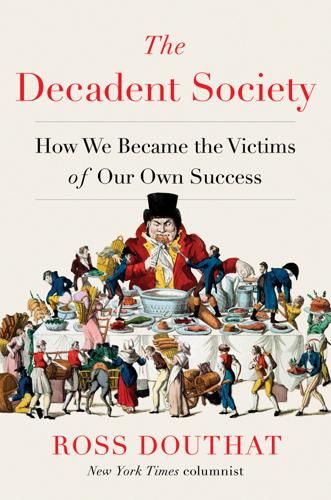
The Decadent Society: How We Became the Victims of Our Own Success
by
Ross Douthat
Published 25 Feb 2020
The boomer utopianism that now feels rote, dated, and commercialized was a genuine revolution when it first emerged, and it had to feel like a revolution because it was attacking something that still felt confident, rooted, possibly enduring. Sit down with the first season of Mad Men or an equivalent primary source and then watch the 1970 Woodstock documentary and marvel at the antinomy. Read a sheaf of New Yorkers from the heyday of William Shawn, E. B. White, and James Thurber, and then read your way through the New Journalism—starting with Tom Wolfe’s savaging of Shawn, and then on through Garry Wills, Joan Didion, and Hunter S. Thompson—and you’ll see a conflict between two potencies, two strong cultural approaches, with the younger one not just tearing at weak points but also feeding off the older order’s strength.
…
S., 209 Napster, 105 NASA, 5 National Geographic, 38 nationalism, 86, 172–73 as escape from sclerosis, 217–18 National Security Agency (NSA), 144 Internet companies and, 146, 147 neoliberalism, 24 left-wing critique of, 30–31 libertarian critique of, 30, 31 limits of, 28–32, 219 neo-Marxism, 219–21 neo-paganism, see paganism Netanyahu, Benjamin, 218 New Age spiritualism, 101, 103, 224, 225, 226 New Deal, 68, 74 New Frontier, 181 New Journalism, 109–10 New Republic, 114 New York, 127 New Yorker, 109, 134 New York Review of Books, 6 New York Times, 60, 62, 137 Nisbet, Robert, 108–9, 110 Nixon, Richard, 24, 77 North Africa, political turbulence in, 194 nostalgia, 181, 206 “Nothing to Hide” (Twitter account), 147 nuclear war, 191 Nye, David, 36, 37 Obama, Barack, 67 and management of decadence, 181 presidential unilateralism and, 60 Obamacare, 68, 69–70, 73–74, 76 Obama presidency: foreign policy of, 70–71 political sclerosis and, 67–72, 74 Occupy Wall Street, 113 offshoring, 28, 29 Oliver, Kendrick, 231–32 opioid epidemic, 126–27 Orban, Viktor, 85, 164 Oumuamua (cosmic object), 233, 237 paganism, as path to renaissance, 224–26 Panopticon, 144, 152, 153, 154 see also pink police state pantheism, 224, 225, 226 parents, older, children of, 60–61 Paris climate accords, 71 Paris Statement (2016), 217, 219 Parsons, Jack, 231 Pascal, Blaise, 235–36 Perot, Ross, 78–79 Peterson, Jordan, 97, 224 pharmaceutical industry, 44 Phillips, Todd, 94 Piketty, Thomas, 12, 30, 57–58 Pinker, Steven, 165 pink police state, 140–54 civil liberties and, 141–42 in Europe, 143–44 marginalization of dissent in, 151–52, 153–54 playacting and performance in, 152 political discourse in, 147 soft pressure vs. hard enforcement in, 148 see also surveillance state Pizarro, Francisco, 189 plagues, impact on civilization of, 190 Poland, 85–86 polarization, 154 sclerosis and, 76–81 political discourse, in pink police state, 147 politically correct speech, 143 political parties, polarization of, 77–81 politics: declining birthrate and, 62–66 as entertainment, 153–54 historical norms of, 68–69 of sustainable decadence, 129–36 Politico, 198 polytheism, 225 popular music, decline of originality in, 91 populations, aging of, see aging populations populism, resurgence of, 12–13, 22, 27, 28, 63, 64, 78–80, 85, 86, 152, 153–54, 181, 193 immigration and, 196 as threat to liberal order, 171–73 pornography, 107, 149 addiction to, 119 Internet culture and, 120–21 in Japan, 88 sexual violence and, 119–22 and sixties-seventies social revolution, 119 virtual entertainments and, 125 postcolonial world, cultural synthesis of West and, 208–9 postmodernism, 97, 98, 135 Poulos, James, 140–41, 146, 151 pre-Columbian America, European conquest of, 189–90 Prejudices: A Philosophical Dictionary (Nisbet), 108–9, 110 prescription drugs, social upheaval repressed by, 149 privacy, right to: Internet and, 145, 146–47 lack of public concern about, 147, 148 productivity: aging workforce and, 57 education and, 34–35 Internet and, 41 stagnation in, 44 progress: promise vs. reality of, 1–2, 4–5, 10–11, 28, 42–46 technological, see technology see also change progressives, progressivism, cultural repetition and, 98 Protestants, Protestantism: churchgoing by, 100 evangelical, 53, 101, 119, 222 psychics, 225 publishing industry, decline of originality in, 91, 105 Putin, Vladimir, traditionalism of, 162–63 Quinones, Sam, 127 race: identity and, 205, 221 new configurations of, 208 wage gap and, 99 racism, 63, 80, 97, 205 Rahner, Karl, 110 rape, see sexual violence Rauch, Jonathan, 72, 73 Ready Player One (film), 94 Reagan, Ronald, 24, 71 Reagan Revolution, 68, 77, 90, 100 recessions, 192, 193, 194 Reeves, Richard, 31 Reformation, 222, 227, 230 regulation, proliferation of, 72 Reign of Terror, 206 religion: belief in immanent divine in, 224 birthrate and, 53, 54 communitarianism in, 216 declining formal affiliation in, 99–100 demographic change and, 222–23 Eastern forms of, 225 as path to renaissance, 221–23 post-Christian, 224 public rituals in, 225, 226 repetition in, 99–100, 180 sects in, 101–2; see also specific sects secularism’s relationship with, 221 self-help versions of, 224 unforeseen revolutions in, 223 see also paganism religious debates, repetition in, 101–4 renaissance, 205–32 as combination of scientific programs and religious revival, 230–32 as concurrence of forces, 229–32 Eurafrican scenario for, 206–10, 218, 228–29 Islam as path to, 226–28 meaningfulness as core issue in, 221 paganism as scenario for, 224–26 political scenarios for, 215–21 religious scenarios for, 221–23 technological acceleration and, 210–15 renewable energy, 35, 43 rentier class, 26, 30–31, 46 repetition, 10, 11, 66, 89–115, 236 baby boomers and, 109, 111–12 in ideological debates, 100–101 innovation vs., 9 in intellectual realm, 96–101, 180 in Internet culture, 104–7 in movies, 91, 93–95 in music, 91 in publishing, 91 in religion, 99–100, 180 in religious debates, 101–4 in television, 95 Republicans, Republican Party: as interest-group protection racket, 76 polarization blamed on, 79 populism and, 79–80 sclerosis of, 80–81 tax policies of, 29 see also conservatives, conservatism research and development, stagnation in, 44–45 right: attention seeking by, 153 media-entertainment complex of, 80 political renaissance scenario of, 217–18 see also conservatives, conservatism Rise and Fall of American Growth, The (Gordon), 33 Rise of the Meritocracy, The (Young), 170–71, 172 rituals, public, 225, 226 robots, robotics revolution, 44, 210–11 Roman Empire, 13, 157 early Christianity and, 222, 223, 237 impact of plagues on, 190 Roosevelt, Franklin, 74 Russia, czarist, 162–63 Russia, modern: traditionalist ideology of, 162–63 Ukraine interventions of, 162 and US 2016 election, 162 Salvini, Matteo, 85, 114 Sanders, Bernie, populism of, 181 Sarah, Robert Cardinal, 206–8, 209, 228 Saudi Arabia, 160, 163 Scandinavia, 85 Schmidt, Eric, 146 Schneier, Bruce, 144 school shootings, 123–24 sclerosis, political, 9, 10, 11–12, 25, 67–88 centrist view of, 76–79 conservative-friendly explanations of, 72–76 in EU, 82–86 in Japan, 86 as kludgeocracy, 75 left’s view of, 79–80 mass immigration and, 64–65 nationalism as escape from, 217–18 Obama presidency and, 67–72, 74 polarization and, 76–81 and public expectations of government action, 74–75 of Republican Party, 80–81 as result of multiple trends, 81 virtuous communities as escape from, 215–17 Scorsese, Martin, 94, 95 Second Vatican Council, 100 secularism, 222–23, 227 birthrates and, 51, 53, 54 religion’s relationship with, 221 repetition in, 102–3 sterility of, 207 self-driving cars, 21 Senate, US, 67 Senegal, 208, 209 Senghor, Léopold Sédar, 208–9 September 11, 2001, terrorist attacks, 114, 159 Servan-Schreiber, Jean-Jacques, 42 sex, virtual entertainments and, 128 sex bureaucracy, 142–43 sexually transmitted diseases, increased rate of, 152 sexual relations: decline in, 55, 87, 125 among teenagers, 122–23 sexual revolution, 90 birthrate and, 50, 55 sexual violence: falling rates of, 120–22 pornography and, 119–22 Shallows, The (Carr), 107 Shawn, William, 109–10 Shinto, 225 Shulevitz, Judith, 61 Silicon Valley, 17, 19, 20, 21, 22, 42, 143, 146, 201 foreign investment in, 193–94 space race and, 43, 213 Simon, David, 95 Simon, Julian, 43 Singapore, 216 birthrate in, 50 pronatalist policies of, 52 Singularity, 24 sixties-seventies: promise of, 1–2 sociological and cultural change in, 99, 108–9, 119 see also baby boomers Slaughter, Anne-Marie, 97 “Slouching Towards Bethlehem” (Didion), 131 Smith, Adam, 179 Smithsonian Museum, 38 Snow family, 59–60 social credit systems, 138–40 social democrats, 73 socialism, resurgence of, 27, 28 social media, 106 “soma,” 127 Sopranos, The (TV show), 95 Soumission (Submission) (Houellebecq), 155–57, 159, 160–61, 172 South Africa, economic growth in, 166–67 South Asia, migration from, 199 South Korea, 164 birthrate in, 50 pronatalist policies of, 52 space race, 181 Silicon Valley and, 43, 213 space travel: critiques of, 5–6 expectations of, 2 physical limits on, 235 revolution in, 211 as scenario for end of decadence, 236, 239–40 unfulfilled promise of, 1–3, 5–6 Spain, 84, 85 Spanish conquest, 189–90 Specter, Arlen, 67 speech, politically correct rules of, 143 Spielberg, Steven, 94 Sputnik, 2 stagflation, 24, 28 stagnation, economic, 11, 17–46, 57, 193, 236 climate change and, 180 decadence as, 8–10 demographics and, 57 in Europe, 25 in Japan, 86, 125 let’s-pretendism and, 21 and limits on growth, 32–36 mass immigration and, 64–65 median US income and, 22–23 neoliberalism and, 28–32 unemployment and, 23 stagnation, technological, 36–42, 91, 103, 104, 165–66, 180, 201, 203, 214 stalemate, 66 see also sclerosis, political Stanford University, 44–45 Star Trek (TV show), 2, 38, 214 Star Wars movies, 89, 90, 111 Stephenson, Neal, 37 Steyn, Mark, 38–40, 41, 100 stimulus package, 67, 68 Suk, Jeannie, 142 Sullivan, Andrew, 127 Summers, Larry, 33 superrich, 31 surveillance state, 201 criminality and violence discouraged by, 148–49 Internet as, 144–47 Sweden, 52 Syria, 85, 199 civil war in, 70–71 Syrian refugee crisis, 85, 161, 196 tax rates, low, 28, 29 tax reform, 70 technocrats, 192, 202–3 sustainable decadence and, 181–83 technological acceleration: renaissance and, 210–15 social and political institutions and, 213–15 technological sublime, 36–37 technology: backlash against, 229 stagnation in, 36–42, 91, 103, 104, 165–66, 180, 201, 203, 214 unanticipated consequences of, 179, 191 teenagers: anxiety and depression among, 123 sexual relations among, 122–23 Teles, Steven, 30, 31, 75, 78 television: creativity in movies vs., 94–95 decline of originality in, 95 golden age of cable on, 95–96 terrorism, 114, 150, 159 in age of sustainable decadence, 131–33 Theranos, 18–19, 21 Thiel, Peter, 12, 41, 42, 102, 168 Thompson, Hunter S., 110 Thurber, James, 109 To Touch the Face of God (Oliver), 231–32 traditionalism: cultural/political, 48, 98, 162–63, 206 religious, 101, 103, 206–7, 208 Trump, Donald, 48–49, 79, 89, 132, 154 attention as primary need of, 152–53 election of, 99, 101, 114, 182 Great Recession and, 193 immigration and, 196 incipient authoritarianism of, 80, 130 populist appeal of, 78–79, 101, 181 as product of decadence, 12, 13 transgressive behavior of, 152 Twitter use by, 130 “Western civilization” speech of, 205–7 Trump presidency, 65 policy failures of, 71, 172 Trump voters, 63–64, 171, 217 Turner, Frederick Jackson, 3–4 “Twilight City,” 56, 57, 65 Twitter, 148, 194 Trump’s use of, 130 2001: A Space Odyssey (film), 2 Uber, 19–21, 22 UFOs: theories about, 237 videos of, 233–34 Ukraine, 162 Unconditional Surrender (Waugh), 183 unemployment, stagnation and, 23 Uninhabitable Earth, The (Wallace-Wells), 195–96 United States: aging population of, 60, 193 birthrate in, 50, 54 European governmental system vs., 82, 83 impact of climate change in, 197 Mexican immigration to, 198, 199 upper class: accumulation of advantage by, 31–32 rentier capitalism and, 26, 30–31, 46 U.S.

The Authoritarian Moment: How the Left Weaponized America's Institutions Against Dissent
by
Ben Shapiro
Published 26 Jul 2021
Nicholas Thompson and Issie Lapowsky, “How Russian Trolls Used Meme Warfare to Divide America,” Wired.com, December 17, 2018, https://www.wired.com/story/russia-ira-propaganda-senate-report/. 35. Molly Ball, “The Secret History of the Shadow Campaign That Saved the 2020 Election,” Time.com, February 4, 2021, https://time.com/5936036/secret-2020-election-campaign/. 36. Eliza Shearer and Elizabeth Grieco, “Americans Are Wary of the Role Social Media Sites Play in Delivering the News,” Journalism.org, October 2, 2019, https://www.journalism.org/2019/10/02/americans-are-wary-of-the-role-social-media-sites-play-in-delivering-the-news/. 37. Kevin Roose, “The Making of a YouTube Radical,” NYTimes.com, June 8, 2019, https://www.nytimes.com/interactive/2019/06/08/technology/youtube-radical.html. 38.
…
Chen and Kevin Roose, “Are Private Messaging Apps the Next Misinformation Hot Spot?,” NYTimes.com, February 3, 2021, https://www.nytimes.com/2021/02/03/technology/personaltech/telegram-signal-misinformation.html?smtyp=cur&smid=tw-nytimes. 56. Eliza Shearer and Elizabeth Grieco, “Americans Are Wary of the Role Social Media Sites Play in Delivering the News,” Journalism.org, October 2, 2019, https://www.journalism.org/2019/10/02/americans-are-wary-of-the-role-social-media-sites-play-in-delivering-the-news/. 57. H. Tankovska, “Facebook: Number of monthly active users worldwide 2008–2020”, https://www.statista.com/statistics/264810/number-of-monthly-active-facebook-users-worldwide/#:~:text=With%20roughly%202.8%20billion%20monthly,network%20ever%20to%20do%20so. 58.

Walk Away
by
Douglas E. French
Published 1 Mar 2011
Journal, Association for Financial Counseling and Planning Education, 2004. “The popular press, following conventional wisdom, frequently advises that eliminating mortgage debt is a desirable goal. We show that this advice is often wrong ... mortgage debt is valuable to many individuals.” “Mortgage Debt: The Good News.” Journal of Financial Planning, September 2004. “... U.S. households that are accelerating their mortgage payments instead of saving in tax-deferred accounts are making the wrong choice ... in the aggregate, these misallocated savings are costing U.S. households as much as $1.5 billion dollars per year.”
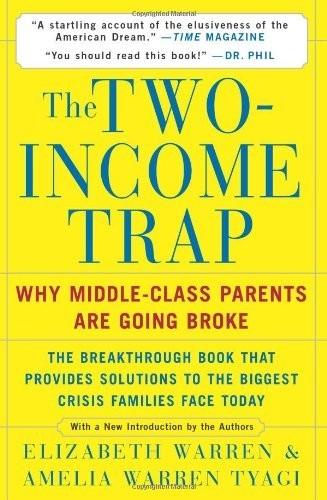
The Two-Income Trap: Why Middle-Class Parents Are Going Broke
by
Elizabeth Warren
and
Amelia Warren Tyagi
Published 17 Aug 2004
Petersburg Times “My advice for a great way to start on the road back to fiscal solvency, or to avoid falling into this trap altogether, is to invest $26 of your dwindling discretionary income on THE TWO-INCOME TRAP. The solutions and advice it provides might change the financial future for you and your children, today, tomorrow, and forever.” —Lowell Sun “The book should be mandatory reading for any couple before they begin a family.” —Pensacola News Journal “Well-constructed book [with a] very persuasive argument” —“Sound Money,” NPR “An extremely thoughtful, well-presented, relevant book that challenges some of the basic assumptions in America today . . . this excellent work deserves to be considered by all, and most currently by policy-makers looking for creative solutions.”
…
Bureau of the Census, American Housing Survey: 1975, Indicators of Housing and Neighborhood Quality, Current Housing Reports, H-150-75B (February 1977), Table A-4, Selected Neighborhood Characteristics, 1975; American Housing Survey, 1999, Current Housing Reports, H150/99 (October 2000), Table 3-8, Neighborhood—Owner Occupied Units. 46 Danilo Yanich, “Location, Location, Location: Urban and Suburban Crime on Local TV News,” Journal of Urban Affairs 23, no. 3-4 (2001): 221-241, Table 2, Rates of Selected Crimes in Baltimore and Philadelphia, 1977 and 1996. 47 Yanich, “Location, Location, Location,” p. 222. 48 While this is not exclusively an urban-suburban dichotomy, urban dwellers are more than twice as likely as suburbanites to say that the public elementary schools are so bad that they would like to move.

China's Good War
by
Rana Mitter
The Tiananmen Square confrontation and killings in June 1989 led to a major hardening of attitudes in history, as in many other areas of Chinese intellectual life, at least for a while. The War of Resistance was very much present in the new political atmosphere. During this time, plans were made for CASS to establish a new journal, entitled KangRi zhanzheng yanjiu (Research on the War of Resistance against Japan), that would showcase research on the war years but would also provide academic ballast for the party-state’s new emphasis on nationalism. In the period leading up to the journal’s inaugural issue in 1991, there was political pressure both from Chinese politicians and from figures in the Chinese diaspora in the United States, recalled one scholar who was involved in the planning.51 Wartime History and Contemporary Politics, 1990s–2010s The tensions between the political sphere and the academy in interpretations of the War of Resistance continued over the next two decades.
…
China, which did not recognize Lee’s claim to presidential status, was angered by the impression that he had been received in his official status, rather than as a private citizen, and the incident led to a dampening of relations between the mainland and Taiwan.52 But that year also saw the publication of a special issue of the new journal that had been established at CASS. The journal had started publication in 1991, in the intellectually chilly aftermath of Tiananmen, but was distinguished by carrying rigorous, empirically rich research essays on wartime history, mostly of a political and military nature. In the aftermath of the 1989 killings, the state became increasingly concerned to promote “patriotic education.”

Laziness Does Not Exist
by
Devon Price
Published 5 Jan 2021
“APA Stress in America Survey: US at ‘Lowest Point We Can Remember’; Future of Nation Most Commonly Reported Source of Stress,” American Psychological Association, November 1, 2017, https://www.apa.org/news/press/releases/2017/11/lowest-point. 10. Ibid. 11. Grace Ferrari Levine, “Learned Helplessness in Local TV News,” Journalism & Mass Communication Quarterly 63, no. 1 (March 1986): 12–18. 12. Grace Ferrari Levine, “ ‘Learned Helplessness’ and the Evening News,” Journal of Communication 27, no. 4 (December 1977): 100–105. 13. Ted Chiricos, Kathy Padgett, and Marc Gertz, “Fear, TV News, and the Reality of Crime,” Criminology 38, no. 3 (August 2000): 755–86. 14. Mirka Smolej and Janne Kivivuori, “The Relation between Crime News and Fear of Violence,” Journal of Scandinavian Studies in Criminology and Crime Prevention 7, no. 2 (2006): 211–27. 15.
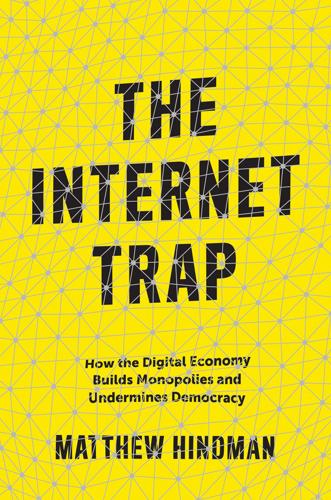
The Internet Trap: How the Digital Economy Builds Monopolies and Undermines Democracy
by
Matthew Hindman
Published 24 Sep 2018
But for journalism and media scholarship as a whole, as Barbie Zelizer has noted, there has been surprisingly little work on recommender systems.6 To the extent that algorithmic news filtering has been discussed at all, it was long unhelpfully lumped with a grab bag of different site features under the heading of “interactivity.”7 Research by Neil Thurman and Steve Schifferes has provided a taxonomy of different forms of personalization and has chronicled their (mostly growing) deployment across different news sites.8 Even Thurman and Schifferes’s work, however, has said little about recommender systems because traditional news organizations lagged in deploying them. As this book goes to press, new journalism and communication scholarship has finally started to address this longstanding gap.9 Still, much work remains to be done. This chapter has two main aims. First, it offers a more detailed examination of the principals behind these recommendation systems than previous media scholarship. Recommender systems research has changed dramatically over the past decade, but little of this new knowledge has filtered into 40 • Chapter 3 research on web traffic, online news, or the future of journalism.
…
T., Stecula, D., and Sweet, D. (2014). May we have your attention please? Human-rights NGOs and the problem of global communication. International Journal of Press/Politics, 135–59. Thurman, N. (2011). Making “The Daily Me”: Technology, economics and habit in the mainstream assimilation of personalized news. Journalism: Theory, Practice & Criticism, 12(4), 395–415. Thurman, N., and Schifferes, S. (2012). The future of personalization at news websites: lessons from a longitudinal study. Journalism Studies 13(5–6): 775–90. Toth, O. (2014, May). Moving the conversation to where you want to have it. Huffington Post.
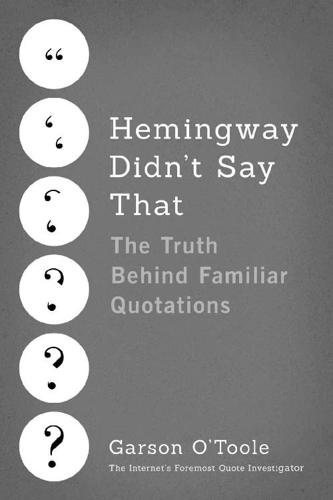
Hemingway Didn't Say That: The Truth Behind Familiar Quotations
by
Garson O'Toole
Published 1 Apr 2017
Note that this published edition is different from the privately published one in endnote 2. 3. Fred R. Shapiro, The Yale Book of Quotations (New Haven: Yale University Press, 2006), 440. Verified in hard copy. 4. Peter Max, Meditation [cartoon panel], Cleveland Plain Dealer (Cleveland, OH), September 16, 1972, 19B. Accessed in GenealogyBank; Peter Max, Meditation [cartoon panel], News Journal (Mansfield, OH), September 16, 1972, 3. Accessed in NewspaperARCHIVE.com. This newspaper mentioned Chantal Sicile and the request for quotations. 5. Judy Hughes, “At Home with Bill Walton,” Northwest Magazine in Oregonian (Portland, OR), April 20, 1975, 12. Accessed in GenealogyBank. 6. United Press International, “Lee Majors Is No Mr.
…
Petersburg Times (St. Petersburg, FL), January 6, 1961, 10D. Accessed in Google News Archive, https://goo.gl/ku1EQp. 13. Hal Lebovitz, “Flap Your Arms, Hitters Tell Perry,” Cleveland Plain Dealer (Cleveland, OH), April 1, 1962, 2C. Accessed in GenealogyBank. 14. Fred Tharp, Fred Tharp on Sports, Mansfield News Journal (Mansfield, OH), December 29, 1963, 20. Accessed in NewspaperARCHIVE.com. 15. Roy Blount Jr., “Yogi: As a Reincarnated Yankee Skipper, Yogi Berra Is Working for George Steinbrenner,” Sports Illustrated, April 2, 1984. Accessed in Sports Illustrated Archive. 16. Joe Sharkey, “Commencement Ain’t Over Till It’s Started,” New York Times, May 19, 1996, NJ1.
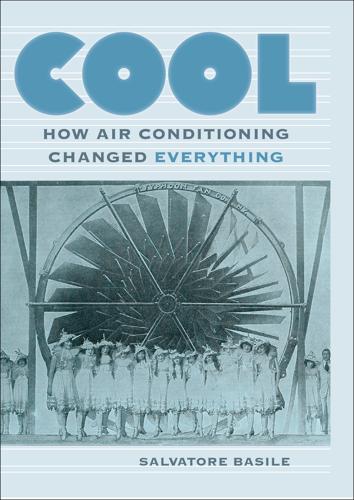
Cool: How Air Conditioning Changed Everything
by
Salvatore Basile
Published 1 Sep 2014
The Evening World dubbed the Exchange “New York’s Coolest Place” in a headline, then continued, “In summer the coolest spot in the city outside of a cold storage warehouse will be the Stock Exchange, which will be kept at a low temperature”—a line that was instantly copied verbatim by papers across the country, including the Washington Post, the Minneapolis Journal, and even the Norfolk (Nebraska) Weekly News-Journal. The Saint Paul Globe was less hyperbolic, reporting only that “the heating, cooling and ventilating arrangements are perfect.” As conservative elder statesman, the New-York Tribune merely assured its readers that the installation was “especially elaborate” and reveled in figures when it pointed out that the system changed 12,000,000 feet of air each minute, cooling it with some 25,000 feet of “cold pipes.”
…
Louis), 201 1928 (Houston), 201–202 1932 (Chicago), 202 1940 (Chicago), 202 1944 (Chicago), 202–203 1948 (Philadelphia), 203 1952 (Chicago), 203–204 1972 (Miami Beach), 231n Republican: 1928 (Kansas City), 201–202 1932 (Chicago), 202 1940 (Philadelphia), 202 1944 (Chicago), 202–203 1948 (Philadelphia), 203 1952 (Chicago), 203–204 televising of, 202–204 National Renewable Energy Laboratory, 241, 242 Natural House, The, 225 Nautical Almanac Office, 48 Nero, 17 Nettleton, Lois, 1 Nevo, 72, 73, 95, 240 New York Life Building, 65 New York Public Library, 70 New York Stock Exchange, 66–70, 69, 77, 90, 91–92, 104, 112–113, 223, 243n Newcomb, Simon, 48–49 newspapers: Atlanta Constitution, 144 Bombay Times and Journal of Commerce, 26 Boston Globe, 47 Charleston Mercury, 9 Chicago Daily Tribune, 56, 67, 67, 72, 115, 118, 147, 173, 173n, 246 Christian Science Monitor, 242 Columbus Journal, 53 Courier and Enquirer, 7 Daily Dispatch, 35 Daily Telegraph, 239 Detroit News, 128 Hartford Daily Courant, 38, 64, 196, 207 Kansas City Journal, 81 Kansas City Star, 77, 79 Lancaster Daily Intelligencer, 55 Los Angeles Herald, 83 Los Angeles Times, 132, 141, 178, 189 London Times, 75 Looking Glass, 27n Louisville Daily Journal, 157 Minneapolis Journal, 68 Minneapolis Star, 236 New York American, 85 New-York Daily Globe, 26 New York Daily News, 173n, 175n, 194 New York Evening Post, 34 New York Herald, 29, 32 New York Sun, 62, 119 New York Times (and New York Daily Times), 10, 12, 32, 33n, 40, 45, 64, 66, 69, 72, 75, 76, 82, 83, 85, 91, 95, 106, 118, 121, 128, 129, 132, 134, 141, 142, 159, 176, 180, 181, 185, 186, 187, 187n, 192, 194, 195, 196, 197, 202, 203, 204, 213, 217, 219, 228, 233, 238 New-York Tribune, 33, 34, 38, 42, 43, 47, 51, 55, 58, 66, 67, 68, 82, 83, 87, 97, 98, 105 New York World (and Evening World), 36, 40, 68 New Yorker, The, 154, 195n, 221, 224, 225 Norfolk Weekly News-Journal, 68 Philadelphia Inquirer, 172 Pittsburg Press, 201 Richmond Times-Dispatch, 83 Saint Paul Globe, 68 San Antonio Evening News, 168 San Francisco Call, 54, 80 San Francisco Chronicle, 236 Wall Street Journal, 69, 147–148, 179, 184, 185, 233 Washington Globe, 29 Washington Post, 47, 64, 68, 96, 113, 131, 172, 177, 238 nickelodeon, 106, 107–108, 107, 109, 111 Nixon, Richard M., 229, 230, 231, 231n, 232 Obama, Barack, 239 Oklahoma!
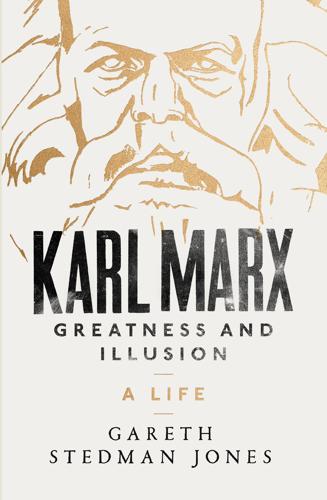
Karl Marx: Greatness and Illusion
by
Gareth Stedman Jones
Published 24 Aug 2016
It was clear that ‘the terrorism of true theory must clear the field’ and this meant that a new journal had to come into being. ‘In the summer we must already get the material together’, so that the journal could be published in Michaelmas.36 ‘It would be nonsense to devote yourself to a practical career. Theory is now the strongest form of practical activity, and we still cannot predict in how large a sense it will be practical.’37 Talk about the new plan lasted between March and December 1841. The new journal would be entitled The Archives of Atheism.38 Unlike his brother, Edgar, Bauer had never expressed any confidence in the intentions of the new king; and even before the new reign he had expressed distrust of the Prussian government on account of its ambivalence on the question of Rhineland Catholics.
…
But this plan ended when the authorities closed down the Bote and expelled Herwegh. Arnold Ruge had also agreed to the Bote plan, but his primary aim was to secure the ‘essential rebirth’ of the Deutsche Jahrbücher. So next he offered Karl co-editorship and a fixed income of 550–600 thalers with another 250 thalers for other writings. The new journal would establish ‘radical philosophy on the foundations of the freedom of the press’ and would ‘articulate the question of the political crisis or of general consciousness as it begins to form itself’. The immediate aim would be ‘to prepare ourselves, so that later we may jump in among the philistines fully armed and knock them out with one blow’.6 Karl’s politics had closely followed those of Ruge ever since the end of the 1830s.
…
By contrast, the publication of a Deutsch-Französische Jahrbücher would be ‘An undertaking about which one can be enthusiastic.’49 Ruge accepted Karl’s ‘Gallo-Germanic principle’, but between March and August, perhaps due to Jenny’s misgivings, Karl dropped the Strasbourg idea.50 Ruge explored the possibility of Brussels, but found it contained few intellectuals and nothing to compare with the 85,000 Germans supposedly living in Paris.51 Paris was therefore agreed as the place of publication. Some idea of what Karl and Ruge initially expected of the new journal was set out in correspondence from the spring and summer of 1843, which was later reprinted in the journal. Karl optimistically compared the Prussian king with the Stuarts and Bourbons, and likened Germany to ‘a ship of fools’ destined to go down in an ‘impending revolution’.52 Ruge’s reply was deeply pessimistic, the result of his experience as a German republican, a political prisoner and a persecuted editor.
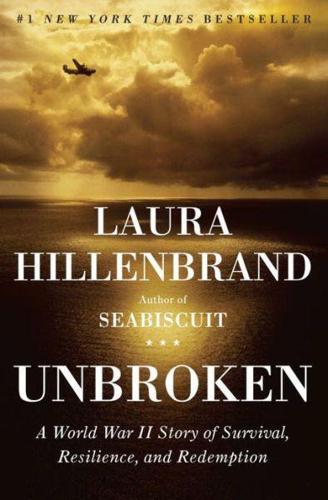
Unbroken: A World War II Story of Survival, Resilience, and Redemption
by
Laura Hillenbrand
Published 16 Nov 2010
Chapter 7: “This Is It, Boys” 1 Oahu in 1942: Stanley Pillsbury, telephone interviews, August 25, 2004, March 9, 2005, and August 18, 2006; Cleveland, p. 158. 2 “one sees only about ⅓”: Cleveland, p. 158. 3 Barracks: Jesse Stay, “Twenty-nine Months in the Pacific,” unpublished memoir. 4 “You kill one”: Russell Allen Phillips, letter to Kelsey Phillips, December 8, 1942. 5 “like a dozen dirty”: Russell Allen Phillips, letter to Cecy Perry, April 2, 1943. 6 Water fight: Russell Allen Phillips, letter to Cecy Perry, May 12, 1943. 7 Beer fight: Louis Zamperini, telephone interview. 8 Pornography: Russell Allen Phillips, letter to Cecy Perry, December 29, 1942. 9 Greenhouse windows froze: Cleveland, 103. 10 Phil hits pole: Russell Allen Phillips, letter to Cecy Perry, March 27, 1943. 11 Gunnery, bomb scores: Louis Zamperini, war diary, January 20, 30, February 2, and March 21, 1943 entries. 12 Sea search: Stanley Pillsbury, telephone interview, August 27, 2004; Louis Zamperini, war diary, March 14, 1943, entry; Louis Zamperini, telephone interview. 13 Diving over sub: Louis Zamperini, diary, March 14, 1943. 14 Practical jokes: Louis Zamperini, telephone interviews. 15 “kind of daring”: Russell Allen Phillips, television interview, CBS, La Porte, Ind., January 1997. 16 Leisure-time activities: Louis Zamperini, telephone interview; Louis Zamperini, war diary, November 1942–May 1943 entries. 17 Wake attack: Louis Zamperini, war diary, December 22–25, 1942, entries; Stanley Pillsbury, telephone interviews, August 25, 27, 2004, March 9, 2005, and August 18, 2006; Louis Zamperini, telephone interview; Jesse Stay, telephone interviews, July 23, 2004, and March 16, 2005; “Son of Pickett ‘Sky Pilot’ Pilots Bomber over Wake I,” undated article from Phillips scrapbook, NPN; Walter Clausen, undated article from Phillips scrapbook, NPN; “Delphi Flyer Is Given Medal for Pacific Bombing,” undated article from Phillips scrapbook, NPN; “Former La Porte Youth Helps to Bomb Wake Isle,” undated article from Phillips scrapbook, NPN; “Fledglings’ Raid on Wake Token of Things to Come,” Berkshire Evening Eagle, January 2, 1943; St. Louis Globe, undated article from Phillips scrapbook, NPN; “Their Raid on Wake Biggest of Year,” Mansfield News-Journal, January 2, 1943; “Tells of Raid on Wake Island,” Mansfield News-Journal, January 2, 1943; “Nobody Scared in Raid on Wake Island, Ace Says,” Ada Evening News, January 2, 1943; Walter Clausen, “Hawaii Fliers Get Jap Planes in Wake Raid,” undated article from Phillips scrapbook, NPN; Britt, p. 12; Jesse Stay, “Twenty-nine Months in the Pacific,” unpublished memoir. 18 New Year’s: Louis Zamperini, war diary, January 1, 1943, entry. 19 STEEL FILLS JAP SOX: Undated article from Phillips scrapbook, NPN. 20 “fled in terror”: “Tells of Raid on Wake Island,” Mansfield News-Journal, January 2, 1943. 21 Japan finished within the year: “U.S.
…
Louis Globe, undated article from Phillips scrapbook, NPN; “Their Raid on Wake Biggest of Year,” Mansfield News-Journal, January 2, 1943; “Tells of Raid on Wake Island,” Mansfield News-Journal, January 2, 1943; “Nobody Scared in Raid on Wake Island, Ace Says,” Ada Evening News, January 2, 1943; Walter Clausen, “Hawaii Fliers Get Jap Planes in Wake Raid,” undated article from Phillips scrapbook, NPN; Britt, p. 12; Jesse Stay, “Twenty-nine Months in the Pacific,” unpublished memoir. 18 New Year’s: Louis Zamperini, war diary, January 1, 1943, entry. 19 STEEL FILLS JAP SOX: Undated article from Phillips scrapbook, NPN. 20 “fled in terror”: “Tells of Raid on Wake Island,” Mansfield News-Journal, January 2, 1943. 21 Japan finished within the year: “U.S. Can Take Care of Japan, Halsey Thinks,” Ada Evening News, January 2, 1943. 22 “it’s a little premature”: Russell Allen Phillips, letter to Kelsey Phillips, December 31, 1942. Chapter 8: “Only the Laundry Knew How Scared I Was” 1 Coxwell’s crash: Louis Zamperini, diary, January 8–10, 1943; Missing Air Crew Report No. 16218, Air Force Historical Studies Office, Bolling AFB, Washington, D.C.; Russell Allen Phillips, letter to Kelsey Phillips, February 13, 1943. 2 Buried in Honolulu: American Battle Monuments Commission. 3 Crashes over the past two months: Army Air Forces Statistical Digest, Table 64; Louis Zamperini, diary, December 27, 1942, and January 9, 1943; Britt, pp. 10, 13. 4 Crash, loss statistics: Army Air Forces Statistical Digest, Tables 100 and 161. 5 In the air corps, 35,946 personnel: Army Battle Casualties and Nonbattle Deaths in World War II: Final Report, 7 December 1941–31 December 1946, Department of the Army, Statistical and Accounting Branch, Office of the Adjutant General, p. 7. 6 Disease kills 15,779: Preventive Medicine in World War II, vol.
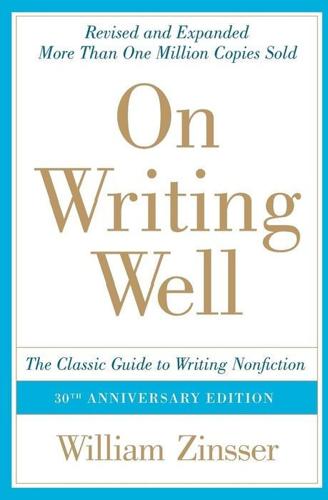
On Writing Well (30th Anniversary Edition)
by
William Zinsser
Published 1 Jan 1976
I know that it’s just not possible to write a competent interview without some juggling and eliding of quotes; don’t believe any writer who claims he never does it. But many shades of opinion exist on both sides of mine. Purists would say that Joseph Mitchell has taken a novelist’s wand to the facts. Progressives would say that Mitchell was a pioneer—that he anticipated by several decades the “new journalism” that writers like Gay Talese and Tom Wolfe were hailed for inventing in the 1960s, using fictional techniques of imagined dialogue and emotion to give narrative flair to works whose facts they had punctiliously researched. Both views are partly right. What’s wrong, I believe, is to fabricate quotes or to surmise what someone might have said.
…
L., 27–29, 65, 99, 207, 212 Mencken (Rodgers), 98 Metaphor, 202–3 Michener, James, 202–3 Mitchell & Ruff (Zinsser), 107, 279 Mitchell, Dwike, 107, 279–80 Mitchell, Joseph, 99, 112–14 Mitchell, Margaret, 103 Models, writing, 96–97, 218, 235–36 Modern English Usage (Fowler), 74 Monty Python, 218 Mood changers of, 73–74 unity of, 50 Moore, Marianne, 42 Morley, Christopher, 103 Morris, Edmund, 98 Morrison, Toni, 243 Mortimer, John, 144 “Mr. Hunter’s Grave” (Mitchell), 112–14 Mumford, Lewis, 38 My Life and Hard Times (Thurber), 148 Nabokov, Vladimir, 135 Narrative, 262 Nast, Thomas, 212 New Journalism, 114 New School, 254 Newsletters, 168–70, 175 New Yorker, The, 50, 75, 79, 98, 111, 112, 204, 220 New York Herald Tribune, 201, 205, 241 New York Public Library, 101 “Night the Bed Fell, The,” (Thurber), 227 Nixon, Richard M., 12, 44, 237 Nouns adjectives as, 32 concept, 75–76, 172 creeping, 76 plain, 238 as verbs, 15, 32, 43 One Writer’s Beginnings (Welty), 136–37 Oral histories, 106 Oral language, 40–41, 107, 238 O’Reilly, John, 242 Orwell, George, 14, 166–67 Out of Egypt (Aciman), 135 Overstatement, 77 Ozick, Cynthia, 204–5 Paine, Thomas, 35–36 Panda’s Thumb, The (Gould), 158 Paper, The (Kluger), 98 Paper Lion (Plimpton), 182 Paragraphs, 79–80 transitions between, 55, 261–62 Parker, Dorothy, 194 Parody, 207–11 Parting the Waters (Branch), 98 Passive voice, 67–68, 298 Path Between the Seas, The (McCullough), 98 Perelman, S.
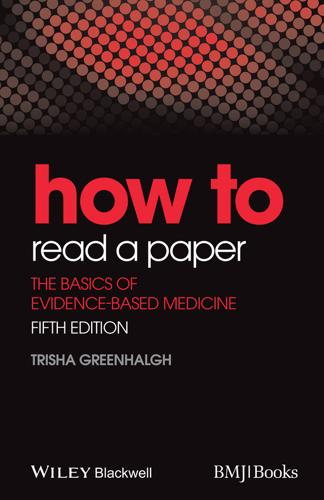
How to Read a Paper: The Basics of Evidence-Based Medicine
by
Trisha Greenhalgh
Published 18 Nov 2010
The medical literature is far more of a jungle today than it was when the first edition of this book was published in 1996. The volume and complexity of published literature has grown: Medline alone has over 20 million references. While Medline is the flagship database for journal articles in the health sciences, it is a very conservative resource, slow to pick up new journals or journals published outside the USA, so there are many thousands of high-quality papers that may be available via other databases but are not included in Medline's 20 million. The proliferation of databases makes the information jungle that much more confusing, especially because each database covers its own range of journals and each has its own particular search protocols.
…
There are certainly good theoretical grounds for the reinstatement of the humble case report as a useful and valid contribution to medical science, not least because the story is one of the best vehicles for making sense of a complex clinical situation. Richard Smith, who edited the British Medical Journal for 20 years, recently set up a new journal called Cases dedicated entirely to ‘anecdotal’ accounts of single clinical cases (see http://casesjournal.com/casesjournal). The following are clinical situations in which a case report or case series is an appropriate type of study. A doctor notices that two babies born in his hospital have absent limbs (phocomelia).
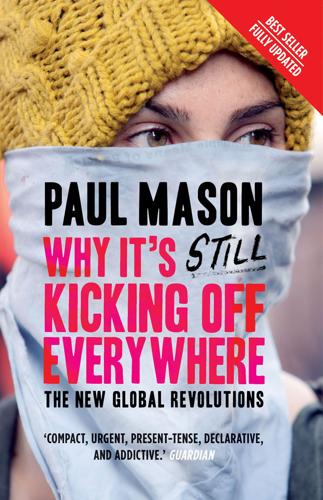
Why It's Still Kicking Off Everywhere: The New Global Revolutions
by
Paul Mason
Published 30 Sep 2013
And for many, politics has become gestural: it is about refusing to engage with power on power’s own terms; about action, not ideas; about the symbolic control of territory to create islands of utopia. The format of the book reflects the zeitgeist: it brings together reportage, essay, tweet, anecdote and cyber-psychology; plus some economic insights gathered amid clouds of tear gas. And the role of ‘the book’ itself is changing. Writers of my generation stood in awe of the New Journalism of the 1960s, when the sudden swing to truthful reportage could end presidencies and terminate wars. But the equivalent in this era will not be like the grand reportage of the Sixties at all. Rather, it is the combined input of thousands of people into the freely accessible public record of social media: the thoughts they tweeted, the jokes they cracked as their friends panicked in the crush of crowds, the football shirts they wore as they toted Kalashnikovs through liberated Tripoli.
…
I. 46 Len-len 193–96, 209 Liberal Democrats 43–44, 46 liberalizers 31 Libya 25, 31, 119; National Transitional Council 178 Life and Fate (Grossman) 129 Lilico, Andrew 121 link-shorteners 75 Linux 139–40 @littlemisswilde 41–42, 44, 45, 135–36, 138 living conditions, urban slums 196–99 London: anti-capitalist demonstrations 33; arrests 61–62; Day X, 24 November 2010 41–42, 46–48; the Dubstep Rebellion 48–52; Fortnum & Mason 60–61; HM Revenue and Customs building 51; Hyde Park 60; Millbank riot 42–44; Millbank Tower 43; Museum Tavern 1; National Gallery teach-in 53, 53–54; Oxford Circus 60; Palladium Theatre 51; Parliament Square 49, 51, 52–53; Piccadilly Circus 58; police–student confrontation 50–51; Regent Street 58; Ritz Hotel 60; Tate Modern 53; trade-union demonstration, March 2011 57–61; Trafalgar Square 47; Victoria Street 50; Victorinox 59 London School of Oriental and African Studies, occupation of 44–46 López, Fernando 166–67, 170 Lopez, Gina 200–2 Lopez Inc. 200–2 Loubere, Leo 174 Loukanikos (riot dog) 94, 96 L’Ouverture, Toussaint 149 LulzSec 151 McIntyre, Jody 51 McPherson, James 182 Madison, Wisconsin revolt 184–87 Madrid 33 Mahalla uprising, 2008 10, 71 Maher, Ahmed 83 Mahfouz, Asmaa, @AsmaaMahfouz 11, 177 Mahmoud (Zamalek Sporting Club ultra) 16–17 Makati, Manila 204–6 malnutrition 9 Mandelson, Peter 17, 26, 114 Manila 33; Estero de Paco 200–2; Estero de San Miguel 196–99; Makati 204–6; waterways 200–2 manipulated consciousness 29–30 Manufacturing Consent (Chomsky and Herman) 28–29 Mao Tse Tung 46 Marxism 141–45 Marx, Karl 46, 141–45, 174, 187, 188–89, 190, 192 Masai with a mobile, the 133–34 Masoud, Tarek 27 Masry Shebin El-Kom textile factory 22–23 mass culture 29–30 Matrix, The (film) 29 Meadows, Alfie 51 media, the 28–29 @mehri912 34 Meltdown (Mason) 31–32 memes 75, 150–52, 152 Merkel, Angela 96, 98, 99, 112 Michas, Takis 103 Middle East: balance of power 178; Facebook usage 135; failure of specialist to understand 25–27 Milburn, Alan 114 Miliband, Ed 58, 60, 188 Millbank riot 42–44 Millennium Challenge 2002 82–83 Miller, Henry 128 misery 209 mobile telephony 75–76, 133–34 modernism 28 mortgage-backed securities 106–8 Moses, Jonathan 48 Mousavi, Mir-Hossein 33–34 movement without a name 66 Mubarak, Alaa 17–18 Mubarak, Gamal 8, 10, 17–18, 26 Mubarak, Hosni 9, 10, 14, 15, 18–19, 19–20, 26, 31 Murdoch, Rupert 31, 106, 148–49 Muslim Brotherhood 21, 177 NAFTA 166–67 Napoleon III 172, 191 Nasser, Gamal Abdel 19 National Gallery teach-in 53, 53–54 nationalism 124 Native Americans 162, 163 Negri, Toni 42 Netanyahu, Binyamin 180 network animals 147 networked individualism 130, 130–33, 141 networked protests 81–82, 85 networked revolution, the 79–85; erosion of power relations 80–81; informal hierarchies 83; networked protests 81–82; network relationships 81; swarm tactics 82–83 network effect, the 2, 74–75, 77; erosion of power relations 80–81; strength 83; usefulness 84 network relationships 81 Nevins, Allan 182 New Journalism 3 News Corporation 148—49 News of the World 49; phone hacking scandal 61, 148–49 New Unrest, social roots of 65–66, 85; demographics of revolt 66–73; information tools 75–76; the networked revolution 79–85; organizational format 77–78; technology and 74–79; the urban poor 70–72 New York Times 170 1984 (Orwell) 30, 129 Nomadic Hive Manifesto, The 53–54 @norashalaby 13 North Africa: demographics of revolt 66; students and the urban poor 71 Obama, Barack 72, 116–18, 120, 122, 162, 167, 170, 180, 183, 187 OccupiedLondon blog 88–89 Occupy Wall Street movement, the 139, 144, 187, 210 Office for National Statistics 115 Ogden-Nussbaum, Anna, @eponymousthing 184 Oklahoma 153, 153–56 Oldouz84 36, 37 Olives, Monchet 202–4 online popularity 75 On the Jewish Question (Marx) 143 Open Source software 139–40 Operation Cast Lead 33 organizational format, changing forms of 77–78 Organisation of Labour, The (Blanc) 187 organized labour 71–72, 143 Ortiz, Roseangel 161 Orwell, George 30, 129, 208, 210 Owen, Robert 142 Palafox, Felino 204–5 Palamiotou, Anna 97 Palestine 25, 121, 179, 180 Palin, Sarah 181, 182 PAME (Greek trade union) 90 Papaconstantinou, George 91, 97 Papandreou, George 88, 96 Papayiannidis, Antonis 103 Paris 39; 1968 riots 46; revolution of 1848 171, 172 Paris Commune, the 1, 72–73, 84, 132 PASOK 89, 91, 98, 99 Paulson, Hank 110 Petrache, Ruben 203–4 Philippines: Calauan, Laguna Province 202–4; Estero de Paco, Manila 200–2; Estero de San Miguel, Manila 196–99, 205–6, 206–9; Gapan City 193–96; Makati, Manila 204–6; New People’s Army 203 Philippines Housing Development Corporation 198 philosophy 29 phone hacking scandal 61, 148–49 Picasso, Pablo 127, 128, 132 Pimco 170 Poland 172 police car protester (USA) 4 Policy Exchange think tank 55 political mainstream, youth disengagement from 89–90 popular culture 65, 176 Porter, Brett 154, 155, 156 Port Huron Statement, the 129–30, 145 Portugal 92, 112, 188 postmodernism 28 poverty 121–22, 210, 211 Powell, Walter 77 power, refusal to engage with 3 power relations, erosion of 80–81 Procter & Gamble 23 propaganda of the deed 62 property 48 property bubble collapse 106–8 protectionism 124 protest, changing forms of 54–57 pro-Western dictators, support for 31 Prussia 191 Puente 165 Putnam, Robert 134 Quantitative Easing II 120–23 radicalization 33, 37, 47–48 radical journalists 149 Ramírez, Leticia 165 Real Estate Tax Authority Workers (Egypt) 19 Really Free School, the 1–2 @rebeldog_ath 96 reciprocity 77 Reed Elsevier 146 Reider, Dimi 179 Research and Destroy group 38–39 revolt, demographics of 66, 66–73 revolutionary wave 65 revolution, definition 79–80 revolutions: 1848 171–73, 173–75, 191, 192; 1917 173; 1968 173; 1989 173 Reynalds, Jeremy 159–60, 162–63 rice crops 195 Riches, Jessica, @littlemisswilde 41–42, 44, 45, 135–36, 138 Rimbaud, Arthur 132 River Warriors 201 Roads to Freedom (Sartre) 129 Road to Wigan Pier, The (Orwell) 208 Romer, Christina 117 Roosevelt, Franklin D. 169–70 Rove, Karl 30–31, 32 Rowan, Rory 54 Said, Edward 26–27 Said, Khaled 11, 148 @Sandmonkey 13 Sandra (Joy Junction resident) 160 Santa Cruz, University of California 37–39 Sarkozy, Nicolas 91–92, 98 @sarrahsworld 11–12, 14, 135 Sartre, Jean-Paul 129 Saudi Arabia 121 savings, and investment 107 Savio, Mario 4 SB1070 (USA) 164, 165–66, 166–67 self-esteem, and consumption 80–81 self-interest 111 self-reliance 68 self, the, social networks impact on 136–38 Sennett, Richard 68, 80–81, 131 Sentimental Education (Flaubert) 171 el-Shaar, Mahmoud 22 Shafiq, Mohammed 20–22 Shalit, Gilad 179 shared community 84 Sharp, Gene 83 Sharpton, Al 184 Shirky, Clay 138, 139, 140, 146 Sinclair, Cameron 199, 208 Sioras, Dr Ilias 90–91 Situationist movement 46–47 Situationist Taliban 1 slum-dwellers 68; numbers 198 social capital 134 social democracy 145 social housing 199 Socialist International 19–20 social justice 177, 191, 192, 209, 210 social media 7, 74–75, 77; collective mental arena 137; lack of control 37; power of 34–35; role of 56; and the spread of ideas 151 social micro-history 173 social networks 77, 82; impact of 147; impact on activism 138–41; and the self 136–38 social-republicanism 187 solidaristic slum, the 207 Solidarity 42 ‘Solidarity Forever’ (song) 42 Soviet Union 28 Spain 66, 104, 105, 188 Spanish Civil War 209–10 species-being 143 @spitzenprodukte (art activist) 1 spontaneous horizontalists 44–46 spontaneous replication 55 Starbucks Kids 79 Steinbeck, John 153, 155, 159, 163, 164, 169 Stephenson, Paul 52 Stiglitz, Joseph 118 Strategy Guide (Sharp) 83 Strauss-Kahn, Dominique 188 strongman threat, the 177–78 student occupations 37–39, 44–46, 53, 53–54 students: economic attack on 38; expectations 67–68; population 70 Sudan 25 Suez Canal Port Authority 19 Supreme Council of the Armed Forces (SCAF) (Egypt) 18, 20 surveillance 148 swarm tactics 82–83 swine flu epidemic 9 Switzerland 123 syndicalism 175–76 synthesis, lack of 57 Syria 25 tactics 54–57 Tahrir Square, Cairo 6, 69, 89, 139; chants 191, 211; Day of Rage, 28 May 15–17; demonstration, 25 January 10–14; numbers 13; Twitter feeds 13; volunteer medics 20–22 Taine, Hippolyte 73 Tantawi, General 19 Tarnac Nine, the 189 Tea Party, the 117–18, 124–25, 180–81 tear gas 93–94, 100–1 technology 65, 66, 74–79, 85, 133–36, 138–39; and the 1848 revolutions 173–74 Tehran, Twitter Revolution 34–37 teleology 131, 152 Tent City jail, Arizona 164–67 Territorial Support Group 50 Thatcher, Margaret 106 @3arabawy 10, 22, 71 Third Way, the 31 Time magazine 36 Tim (human rights activist) 1–2 Tim (Joy Junction resident) 160 Tocqueville, Alexis de 192 totalitarianism 147–48 toxic debt 110–11 trade wars 122, 124–25 transnational culture 69 Transparency International 119 Trichet, Jean-Claude 112 Truman Show, The (film) 29 trust 57 Tunisia: Army 178; economic growth 119; inflation 121; organized workforce 72; revolution 10, 11, 25–26; unemployment 119 Turkle, Sherry 136 Twitpic 75 Twitter and tweets 3, 74, 137–38; #wiunion 184, 185; @Ghonim 13; @mehri912 34; @norashalaby 13; @rebeldog_ath 96; @Sandmonkey 13; Egyptian revolution 13, 14; importance of 135–36; Iranian revolution and 33–37; Madison, Wisconsin revolt 184; news dissemination 75; real-time organization 75; reciprocity 77; user numbers 135; virtual meetings 45 Twitter Revolution, Iran 33–37, 78, 178 Ukraine 177–78 UK Uncut 54–57, 58, 61 ultra-social relations 138 unemployment: America 159–63; Egypt 119; Spain 105; Tunisia 119; youth 66, 105, 119–20 UN-Habitat 199 Unison 57 United Nations, The Challenge of Slums 198–99 United States of America: agriculture 154–56; Albuquerque 159, 159–63; Arizona 164–67, 183; armed struggle 181–83; Bakersfield, California 168–70; budget cuts 156, 161, 167, 170; California 168–70; campus revolts, 1964 4; Canadian River 159; cattle prices 156; collapse of bipartisan politics 116–19; culture wars 179, 180–84; current-account deficit 107; debt 118; deportations 166; devaluation 123; Dodd–Frank Act 167; the Dust Bowl 154–55; economic decline 183–84; economic growth 170; Federal budget 156, 161; fiscal management 183; fiscal stimulus 117–18; fruit pickers 169; hamburger trade 156; healthcare bill 180, 183; homeless children 160; homelessness 159–63; Indiana 116–17, 125; Interstate 40 157, 170; job market 161; Joy Junction, Albuquerque 159–63; Madison, Wisconsin revolt 184–87; minimum wage workers 158; the Mogollon Rim 163; motels 157–58, 162–63; the New Deal 169–70; Oklahoma 153, 153–56; Phoenix, Arizona 164–67; police car protester 4; political breakdown, 1850s 182–83; property bubble 106–8; Quantitative Easing II 120–23; radical blogosphere 184; the religious right 118; repossessions 168; Route 66 157–59; San Joaquin valley 169; SB1070 164, 165–66, 166–67; State Department 178; states’ rights 183; student occupation movement 37–39; the Tea Party 117–18, 124–25, 180–81, 186; Tent City jail, Arizona 164–67; Tucson, Arizona 182; undocumented migrants 164–67; unemployment 159–63; wages 108; war spending 162; welfare benefits 162, 170 Unite Union 55 university fees 44, 47, 50, 54 urban poor 70–72 urban slums 191; Calauan, Laguna Province 202–4; clearance policies 198–99; education levels 207; Estero de Paco, Manila 200–2; Estero de San Miguel, Manila 196–99, 205–6, 206–9; Gapan City, Philippines 193–96; improvement policies 199, 205–6; internet access 207; labour force 208; living conditions 196–99; Moqattam, Cairo 6–10; population numbers 198 Vail, Theodore 74 Vanderboegh, Mike 181 Van Riper, Lieutenant General Paul 82 Venizelos, Evangelos 97–98 Vietnam War 129 virtual meetings 45 virtual societies 134 Vodafone 54–55 Vradis, Antonis 87–89 wages 108, 112 Walker, Scott 184 Walorski, Jackie 116–17 Walt, Stephen M. 26 war, threat of 178 Warwick University, Economics Conference 67–68 Washington Times 35 Wasim (Masry Shebin El-Kom delegate) 23 water supplies 194 wave creation 78 wealth, monopolization of 108 We Are Social 148 Weeks, Lin, @weeks89 184 Wellman, Barry 130 Wertheim, Margaret 136 White House, the 92 ‘Why the Tunisian revolution won’t spread’ (Walt) 26 WikiLeaks 140 Wikipedia 46, 140 wikis 140–41 #wiunion 184, 185 Wobblies 176 Women’s liberation 132 Woods, Alan 33 Woollard, Edward 43 working class 68, 71–72, 79–80, 145; culture 72; revolutions, 1848 172–73 World of Yesterday, The (Zweig) 128 World Trade Organization 122 Yemen 25, 119, 121 youth 68; alienation 62; British 41–42, 44, 53–54; culture 70; disconnected 190; disengagement from political mainstream 89–90; radicalization 33, 37, 47–48; unemployment 66, 119–20 YouTube 75; Egyptian revolution on 11, 14, 15; Iranian revolution on 34, 35 Zamalek Sporting Club, ultras 16–17 Zapatistas 1 Zekry, Musa 5–6, 7, 23–24 Zola, Emil 191 Zweig, Stefan 128, 132–33, 152, 176 Copyright This revised and updated second edition first published by Verso 2013 First published by Verso 2012 © Paul Mason 2012, 2013 All rights reserved The moral rights of the author have been asserted Verso UK: 6 Meard Street, London W1F 0EG US: 20 Jay Street, Suite 1010, Brooklyn, NY 11201 www.versobooks.com Verso is the imprint of New Left Books ISBN: 978-1-781-68245-6 (e-book) British Library Cataloguing in Publication Data A catalogue record for this book is available from the British Library Library of Congress Cataloging-in-Publication Data A catalog record for this book is available from the Library of Congress Typeset in Fournier by MJ Gavan, Truro, Cornwall Printed by ScandBook AB, Sweden

We Are Electric: Inside the 200-Year Hunt for Our Body's Bioelectric Code, and What the Future Holds
by
Sally Adee
Published 27 Feb 2023
To be fair, they had probably never been made aware of ion channels either. “It is actually quite difficult to find reviewers with appropriate expertise that agree on anything,” Levin said in 2018, during a roundtable meeting held by the editors founding the new journal Bioelectricity. “Trying to get reviewers who see the big picture beyond their individual silos has definitely been a challenge.” The new journal is part of a movement to make bioelectricity an umbrella discipline in its own right, encompassing the wide range of relevant biological phenomena from developmental biology to AI. The research into bioelectricity, if this project is to succeed, needs to begin to resemble the natural philosophy that prevailed when Galvani made his momentous discoveries.

Is the Internet Changing the Way You Think?: The Net's Impact on Our Minds and Future
by
John Brockman
Published 18 Jan 2011
Its demands on library shelf space have increased over time: The first volume contained only 583 pages, whereas the 2009 edition had 9,680. The arrival of the Internet rescued libraries from the space crisis created by the proliferation of new journals and the vast increase in the size of existing ones. Many paper subscriptions were replaced by electronic ones, and past holdings were converted to digital form. It is not hard to imagine a future time when paper copies of the scientific literature will no longer exist. Many new journals are appearing only in digital form. This conversion has produced many benefits for readers. In the past, I had to leave my office, ride an elevator, walk several blocks, take another elevator, and make my way through a maze of shelves to find a paper I needed.
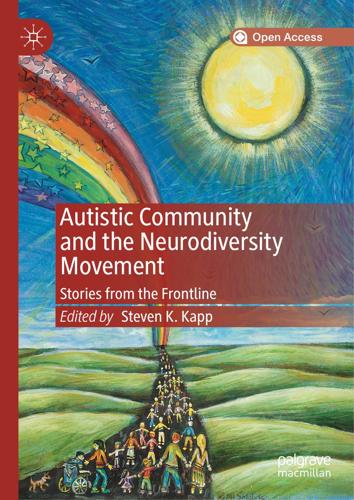
Autistic Community and the Neurodiversity Movement: Stories From the Frontline
by
Steven K. Kapp
Published 19 Nov 2019
Our publications on neurodiversity have been loudly cited, while our publications on our research have quietly infused the next generation of academics interested in conducting research in collaboration with the A/autistic community (see aaspire.org for an ongoing list of AASPIRE’s publications and activities). Recently, due in part to AASPIRE’s visibility in the field, Christina was asked to start a new journal Autism in Adulthood (https://home.liebertpub. com/publications/autism-in-adulthood/646) that includes A/autistic people (both scientists and not, including myself as Associate Editor) in all aspects of its editorial processes. The power that I, and my colleagues, have as peer reviewers in other journals to reject articles that are disrespectful, stigmatizing, or poorly designed is significant.
…
We are “both in charge, the academics and self-advocates”: Empowerment in community-based participatory research. Journal of Policy and Practice in Intellectual Disabilities, 15 (1), 80–89. 13. Nicolaidis, C. (2018, May 24). Hi, I’m Dr. Christina Nicolaidis and I’m editor of a brand new peer-reviewed journal called Autism in Adulthood. Ask me anything about the new journal or the ways that people on the autism spectrum can get better health care! (Online forum). Retrieved from https://www.reddit.com/r/askscience/comments/8lrqke/askscience_ama_ series_hi_im_dr_christina. 144 D. M. Raymaker 14. Raymaker, D. M. (2017, February 27). I’m Dora Raymaker, an Assistant Research Professor at Portland State University, I conduct communityengaged research with the autistic and other disability communities.
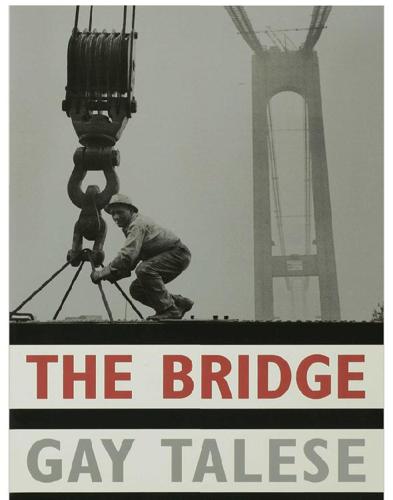
The Bridge: The Building of the Verrazano-Narrows Bridge
by
Gay Talese
and
Bruce Davidson
Published 1 Jan 2003
All are worth reading." —Houston Post "Talese has spun a fascinating, engrossing account of the construction of the Verrazano-Narrows Bridge. This is an absorbing drama; superbly written." —Times Union (Jacksonville) "No finer tribute in print will ever be found than this book." —Wilmington News Journal "Talese tells warm, funny and tragic stories of men, women, steel and concrete. This book is fine reading." —Denver Post "Fine writing and story-telling. . . . Superbly well does Talese tell his story, one that combines sadness, high humor, bawdiness, danger, death and poignancy in one fine package that readers will find hard to put down."
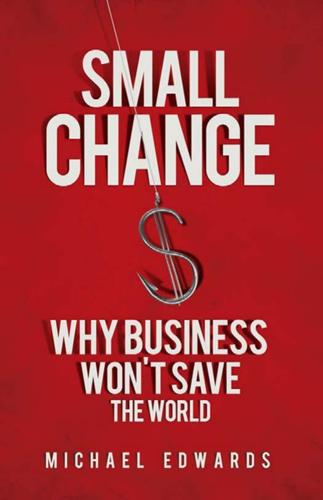
Small Change: Why Business Won't Save the World
by
Michael Edwards
Published 4 Jan 2010
The Gates Foundation is also investing in vaccines against the malaria parasite, along with similar efforts to defeat the scourge of HIV/AIDS, hookworm, leishmaniasis, and sleeping sickness. These efforts include encouragement for different laboratories to collaborate with each other, and at the same time spur innovation through competition — a nice example of rebalancing these different forces in a genuinely useful way — and a grant to the Public Library of Science to launch a new journal on neglected tropical diseases. The latter is the kind of investment that will help to build the public health capacities that are crucial for the future. Pharmaceutical companies are becoming enthusiastic participants in ventures like these, including the Chicagobased Abbott Laboratories, which recently reached agreement with the Brazilian government to sell its popular HIV/AIDS drug Kaletra at a 30 percent discount.

The Idea of Israel: A History of Power and Knowledge
by
Ilan Pappe
Published 30 Apr 2012
The first struggle would be conducted in the Knesset and the second in academia. But the battlefield also extended to foreign policy – aggression towards the state’s neighbours and the Palestinians under occupation – and towards the educational system and the media. Ofir Haivry, the editor of the new journal, explained that his team hoped to set up in the near future a Zionist academia and media, since these realms had, from his point of view, been overtaken by post-Zionists. At the time, the centre and its members looked esoteric at best and pathetic at worst. Within a decade, however, their agenda had become the idea of Israel in the twenty-first century.
…
Noam Demsky of the Ma’aleh School of Television, Film & the Arts, Jerusalem, received 40,000 NIS in 2013 from Minister Livnat for a film called The Strength to Tell, which seeks to communicate ‘a new sense of relevancy of the Holocaust and its lessons’.5 In 2012 the composer Doron Toister received a prize for his Zionist musical piece We Are Your People. One can assume that there was nothing Zionist about the music, the arrangement or the composition, so the award must have been given for the title. Appropriately Zionist poetry is now to be found in a new journal, Meshiv Ruah (Fresh Air), devoted to ‘national religious poetry’. There is also a Zionist plastic art, it seems. Yoav Ben-Dov and Serjio Daniel Chertko won a prize for their piece In the Spirit of Hope. ‘This work was particularly pleasing [for the ministry]’, wrote the critic Alon Idan, cynically, in Haaretz, since ‘it constantly fused the Star of David and the national anthem, “Hatikva”, in their work’ while broadcasting the universal and national meanings of Zionism.6 An obvious winner a year later was the author A.
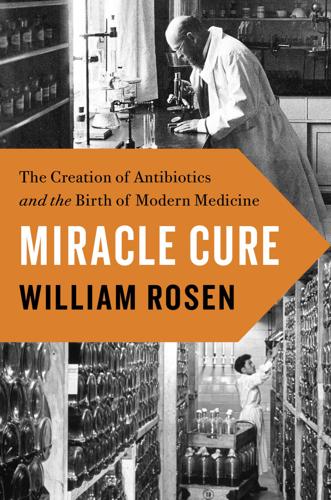
Miracle Cure
by
William Rosen
Published 14 Apr 2017
The Spanish psychiatrist made it clear in speeches and articles that the ideal source for financing the organization and diffusion of therapeutic knowledge was the pharmaceutical firms themselves. “Who better than the pharmaceutical industry,” he wrote, “could organize, coordinate, and integrate on an international scale the vast and increasing knowledge on antibiotics?” Martí-Ibáñez had a business plan. In 1951, he put it into action. He and Welch joined forces to found a new journal, entitled Antibiotics and Chemotherapy, with an editorial board that included a who’s who of antibiotic research, including Florey, Waksman, and Alexander Fleming. Martí-Ibáñez, as president of MD Publications, would run the business side; Welch would be the editor. Antibiotics and Chemotherapy was an immediate success with medical researchers, but its content was virtually all bench science, which limited its appeal.
…
Antibiotics and Chemotherapy was an immediate success with medical researchers, but its content was virtually all bench science, which limited its appeal. To serve the much larger audience interested in the clinical application of the new drugs, in 1955 Welch and Martí-Ibáñez launched another journal, which they named Antibiotic Medicine, changing the title a year later to Antibiotic Medicine and Clinical Therapy. The new journal was circulated free to physicians and other health professionals, as Martí-Ibáñez and Welch reasoned that delivering to that particular audience would make the publication an attractive place for pharmaceutical company advertising. It seems not to have occurred to anyone at the FDA that allowing their antibiotic division’s director to work for a for-profit journal supported entirely by the same pharmaceutical companies whose applications he was responsible for endorsing or rejecting was the very definition of a conflict of interest.
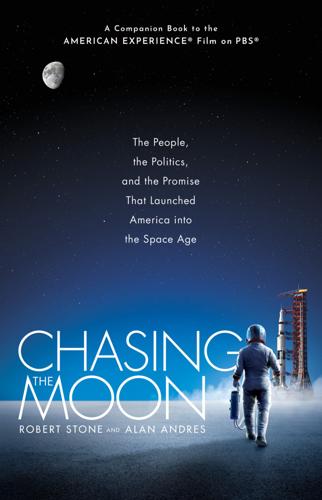
Chasing the Moon: The People, the Politics, and the Promise That Launched America Into the Space Age
by
Robert Stone
and
Alan Andres
Published 3 Jun 2019
A combination of rare skill and unwavering courage, “the right stuff” was what caused someone to willingly and repeatedly place his life on the line to fly an untested bit of machinery and push it to its limit. This was done humbly and without fanfare. The only accolades that mattered were those of their peers. A leading practitioner of the New Journalism, Wolfe employed the tools of a novelist to reveal what he perceived as the essence of his story. His approach allowed him to examine the astronauts’ complex psychology—their driving ambition, recklessness, courage, and flaws—with a freedom that had eluded the previous journalists who’d attempted to chronicle their story.
…
Experience was not pleasant Mordecai Lee, “The Astronaut and Foggy Bottom PR: Assistant Secretary of State for Public Affairs Michael Collins, 1969–1971,” Public Relations Review 33, no. 2 (2007). “I heard we’ve got lots” Clyde Haberman, “Dick Gregory, 84, Dies; Found Humor in the Civil Rights Struggle,” NYT (August 19, 2017). Among the first prominent celebrities “Group: Space Program Moon Shots a Perpetual Star Trek,” Longview Texas News-Journal (July 21, 1994). He used a FOIA request Lynn Darling, “A Rebel Redeemed,” The Washington Post (April 23, 1980). NASA received a letter Courtney G. Brooks, James M. Grimwood, and Loyd S. Swenson, Chariots for Apollo: The NASA History of Manned Lunar Spacecraft to 1969 (Washington: NASA, 1979), p. 331.

Digital Disconnect: How Capitalism Is Turning the Internet Against Democracy
by
Robert W. McChesney
Published 5 Mar 2013
He adds, “In the next few decades, journalism will be made up of overlapping special cases. . . . Many of these models will fail. No one experiment is going to replace what we are now losing with the demise of news on paper, but over time, the collection of new experiments that do work might give us the journalism we need.”9 Yochai Benkler suggests that the new journalism will be so radically different from the old that traditional concerns about resource support are no longer of pressing importance. We can have a leaner journalism, and it will still be much better, thanks to the Internet. He writes: “Like other information goods, the production model of news is shifting from an industrial model—be it the monopoly city paper, IBM in its monopoly heyday, or Microsoft, or Britannica—to a networked model that integrates a wider range of practices into the production system: market and nonmarket, large scale and small, for profit and nonprofit, organized and individual.
…
Instead, the Internal Revenue Service regards journalism as a commercial undertaking, and has dragged its heels granting nonprofit status to numerous legitimate start-ups. That makes fundraising far more difficult. Free Press has made this a major organizing campaign. See Ryan Chittum, “Nonprofit News and the Tax Man,” Columbia Journalism Review, CJR.org, Nov. 17, 2011. 120. Charles Lewis, Brittney Butts, and Kaye Musselwhite, “A Second Look: The New Journalism Ecosystem,” Investigative Reporting Workshop, Nov. 30, 2011, investigativereportingworkshop.org/ilab/story/ecosystem. 121. “IRS Policy and the Future of Nonprofit News,” Free Press, Apr. 16, 2012, freepress.net/irs. 122. Josh Stearns e-mail to author, May 23, 2012. 123. Eric Newton e-mail to author, May 23, 2012. 124.
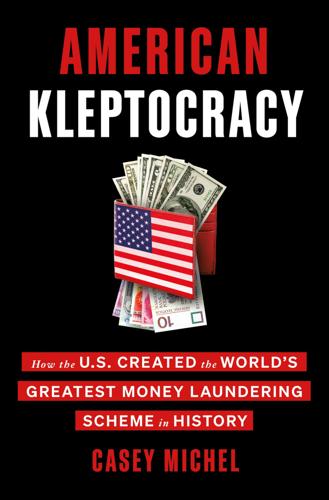
American Kleptocracy: How the U.S. Created the World's Greatest Money Laundering Scheme in History
by
Casey Michel
Published 23 Nov 2021
“‘Merchant of Death’ Viktor Bout Sentenced to 25 Years,” BBC, 6 April 2012, https://www.bbc.com/news/world-us-canada-17634050. 30. Lynnley Browning, “Delaware Laws, Helpful to Arms Trafficker, to Be Scrutinized,” New York Times, 4 November 2009, https://www.nytimes.com/2009/11/05/business/05tax.html. 31. Adam Duvernay and Matthew Albright, “Panama Papers Could Cast Shadow on Delaware,” News Journal, 9 April 2016, https://www.delawareonline.com/story/news/local/2016/04/09/panama-papers-could-cast-shadow-delaware/82670000/. 32. Leslie Wayne, “Anti-Shell Corporation Bill Gets Support from Unlikely US State,” ICIJ, 3 September 2014, https://www.icij.org/inside-icij/2014/09/anti-shell-corporation-bill-gets-support-unlikely-us-state/. 33.
…
Harper Neidig, “Trump Has 378 Businesses Registered in Delaware,” Hill, 22 April 2016, https://thehill.com/blogs/ballot-box/presidential-races/277326-trump-has-378-businesses-registered-in-delaware. 20. Karl Baker, “Delaware Dissolves Shell Companies Created to Pay Off Women by Trump-Fixer Michael Cohen,” Delaware News Journal, 5 October 2020, https://www.delawareonline.com/story/news/2020/10/05/delaware-dissolves-llcs-created-pay-off-women-trump-fixer-michael-cohen/3623443001/. 21. Craig Unger, House of Trump, House of Putin (New York: Dutton, 2018). 22. “Semion Mogilevich,” FBI Most Wanted, https://www.fbi.gov/wanted/topten/topten-history/hires_images/FBI-494-SemionMogilevich.jpg/view. 23.
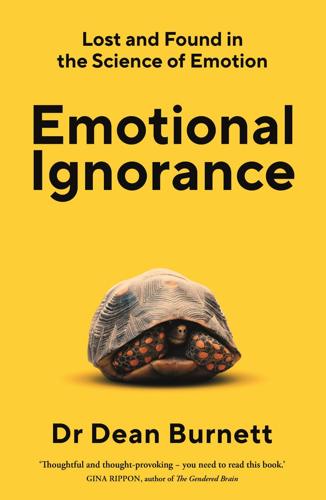
Emotional Ignorance: Lost and Found in the Science of Emotion
by
Dean Burnett
Published 10 Jan 2023
Zhang, ‘Emotion recognition by assisted learning with convolutional neural networks’, Neurocomputing, 2018, 291: pp. 187–194. 77 Kornfield, R., et al., ‘Detecting recovery problems just in time: application of automated linguistic analysis and supervised machine learning to an online substance abuse forum’, Journal of Medical Internet Research, 2018, 20(6): p. e10136. 78 Birnbaum, M.L., et al., ‘Detecting relapse in youth with psychotic disorders utilizing patient-generated and patient-contributed digital data from Facebook’, NPJ Schizophrenia, 2019, 5(1): pp. 1–9. 79 Venkatapur, R.B., et al., ‘THERABOT an artificial intelligent therapist at your fingertips’, IOSR Journal of Computer Engineering, 2018, 20(3): pp. 34–38. 80 Craig, T.K., et al., ‘AVATAR therapy for auditory verbal hallucinations in people with psychosis: a single-blind, randomised controlled trial’, The Lancet Psychiatry, 2018, 5(1): pp. 31–40. 81 Kothgassner, O.D., et al., ‘Virtual reality exposure therapy for posttraumatic stress disorder (PTSD): a meta-analysis’, European Journal of Psychotraumatology, 2019, 10(1): p. 1654782. 82 Dunbar and Dunbar, Grooming, Gossip. 83 Wyse, D., How Writing Works: From the Invention of the Alphabet to the Rise of Social Media (Cambridge University Press, 2017). 84 Doosje, B.E., et al., ‘Antecedents and consequences of group-based guilt: the effects of ingroup identification’, Group Processes & Intergroup Relations, 2006, 9(3): pp. 325–338. 85 Lee, R.S., ‘Credibility of newspaper and TV news’, Journalism Quarterly, 1978, 55(2): pp. 282–287. 86 Jensen, J.D., et al., ‘Public estimates of cancer frequency: cancer incidence perceptions mirror distorted media depictions’, Journal of Health Communication, 2014, 19(5): pp. 609–624. 87 McCombs, M. and A. Reynolds, ‘How the news shapes our civic agenda’, in Media Effects (Routledge, 2009), pp. 17–32. 88 Desai, R.H., M.
…
Gerard, ‘A study of normative and informational social influences upon individual judgment’, The Journal of Abnormal and Social Psychology, 1955, 51(3): p. 629. 109 Spanos, K.E., et al., ‘Parent support for social media standards combatting vaccine misinformation’, Vaccine, 2021, 39(9): pp. 1364–1369. 110 Wu, L., et al., ‘Misinformation in social media: definition, manipulation, and detection’, ACM SIGKDD Explorations Newsletter, 2019, 21(2): pp. 80–90. 111 Kenworthy, J.B., et al., ‘Building trust in a postconflict society: an integrative model of cross-group friendship and intergroup emotions’, Journal of Conflict Resolution, 2015, 60(6): pp. 1041–1070. 112 Mallinson, D.J. and P.K. Hatemi, ‘The effects of information and social conformity on opinion change’, PLOS One, 2018, 13(5): p. e0196600. 113 Cummins, R.G. and T. Chambers, ‘How production value impacts perceived technical quality, credibility, and economic value of video news’, Journalism & Mass Communication Quarterly, 2011, 88(4): pp. 737–752. 114 Abdulla, R.A., et al. ‘The credibility of newspapers, television news, and online news’, in Education in Journalism Annual Convention, Florida USA (Citeseer, 2002). 115 Tandoc Jr, E.C., ‘Tell me who your sources are: perceptions of news credibility on social media’, Journalism Practice, 2019, 13(2): pp. 178–190. 116 Wijenayake, S., et al., ‘Effect of conformity on perceived trustworthiness of news in social media’, IEEE Internet Computing, 2020, 25(1): pp. 12–19. 117 Janis, I.L., ‘Groupthink’, IEEE Engineering Management Review, 2008, 36(1): p. 36. 118 Lin, A., R.
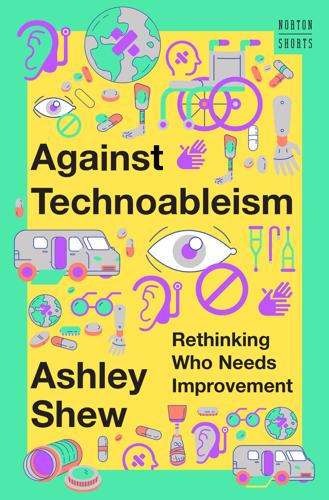
Against Technoableism: Rethinking Who Needs Improvement
by
Ashley Shew
Published 18 Sep 2023
I got a feel for writing for a more general audience for the first time with the history of medicine blog Nursing Clio, big thanks to Laura Ansley; and I received excellent advice from David Perry in a writing for the public workshop. The material about tropes in Chapter 3 is rewritten from “How to Get a Story Wrong,” published in the new journal Including Disability in 2022. Thank you, Stephanie Cork, Ron Padrón, and Sara Olsen, for soliciting this work. I owe a huge debt to Virginia Tech’s Tom Ewing, Karen Roberto, and Yancey Crawford for their grant-writing support. With their encouragement, I applied for a National Science Foundation CAREER grant (#1750260) in 2017, which has supported my research on technology, narrative, and disability—this book is one outcome of that research.
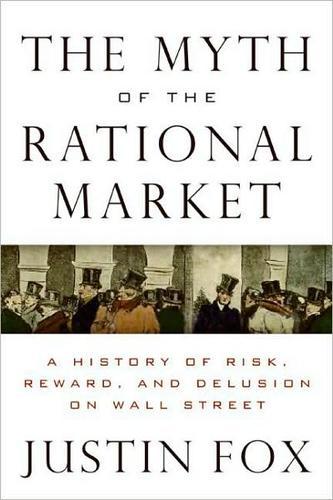
The Myth of the Rational Market: A History of Risk, Reward, and Delusion on Wall Street
by
Justin Fox
Published 29 May 2009
A letter arrived in Fisher’s mailbox from Cowles. Fisher, who had known Cowles’s father and uncle at Yale, enlisted the newspaper heir as the society’s patron. For Cowles, who had been something of an ineffectual dabbler, the role gave him purpose and focus. He became treasurer of the organization, circulation manager of its new journal, Econometrica, and even chief note taker at its meetings. He also founded the Cowles Commission for Research in Economics in Colorado Springs, hiring the math professor he had initially consulted and a couple of young statisticians to help him in his research. In future years, even after he had moved back to Chicago to take over the family’s business interests and removed himself from the day-today activities of the Cowles Commission, he always proudly listed his profession in Who’s Who as “economist.”
…
Arthur doubted his would. Waldrop’s book about Santa Fe, which portrayed him as a lonely hero out to show his blindered colleagues the error of their ways, “ended my career in economics,” he said. Farmer went out of his way to reach out, coauthoring several papers with mainstream finance scholars and launching a new journal, Quantitative Finance, that included Robert Merton and Myron Scholes (along with Kenneth Arrow and Benoit Mandelbrot) on its advisory board. But his work has yet to really penetrate the academic mainstream either.30 Still, even as they resist the incursions from Santa Fe, economists have been taking steps away from their near-exclusive reliance on equilibrium.
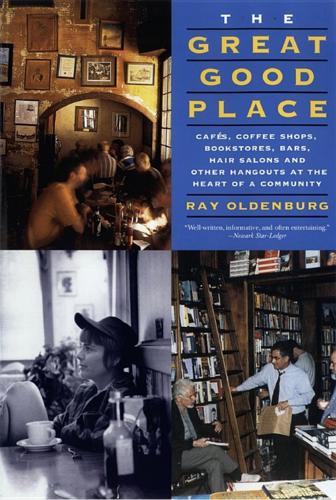
The Great Good Place: Cafes, Coffee Shops, Bookstores, Bars, Hair Salons, and Other Hangouts at the Heart of a Community
by
Ray Oldenburg
Published 17 Aug 1999
Jane Addams, The Spirit of Youth and the City Streets (New York: The Macmillan Company, 1923), 8. 25. Ibid., 7. 26. Nathan Silver, Lost New York (New York: Houghton Mifflin Company, 1967), 227. 27. Paul Gray, “Another Look at Democracy in America,” Time Essay (16 June 1986). 28. Robert Macy, “Entertainer bemoans high prices in Vegas,” The Pensacola News-Journal (15 July 1982), 5D. 29. Ibid. 30. Jim Pettigrew, Jr. “The Vanishing Game of Snooker,” Atlanta Weekly (12 October 1980), 15 ff. 31. I based the calculation on figures reported in Andrew A. Rooney, A Few Minutes with Andy Rooney (New York: Atheneum, 1981), 58–59. 32. Southern Beverage Journal, Feb. 1982, p 39. 33.
…
“Taverns and Coffee Houses: Adult Educational Institutions in Colonial America.” Lifelong Learning: The Adult Years (January 1981). MacCallum, T.W. The Vienna That’s Not in the Baedeker. New York: Robert M. McBride and Company, 1931. Macy, Robert. “Entertainer bemoans high prices in Vegas.” The Pensacola News-Journal (15 July 1982). Malko, George. The Biltmore for Men Only.” Holiday Magazine (January 1969). Mass Observation. The Pub and the People: A Worktown Study. London: Victor Gollancz Ltd., 1943. Mathews, David. “Civic Intelligence.” Social Education (November/December 1985). McHarg, Ian. The Fitness of Man’s Environment.
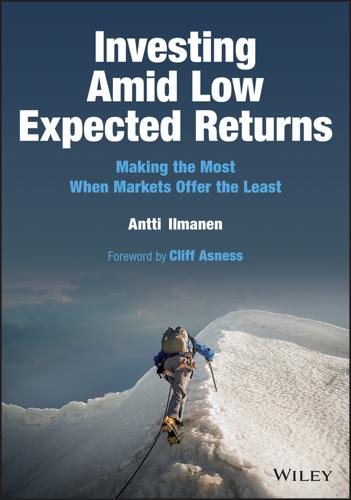
Investing Amid Low Expected Returns: Making the Most When Markets Offer the Least
by
Antti Ilmanen
Published 24 Feb 2022
Eisfeldt, Andrea L; Edward Kim; and Dimitris Papanikolaou (2020), “Intangible value,” NBER working paper 28056. Elton, Edwin J.; Gruber, Martin J.; and Blake Christopher R. (2012), “Does mutual fund size matter? The relationship between size and performance,” Review of Asset Pricing Studies 2(1), 31–55. Engelberg Joseph; David McLean; and Jeffrey Pontiff (2018), “Anomalies and news,” Journal of Finance 73(5), 1971–2001. Engle, Robert F.; Stefano Gihlio; Bryan Kelly; Heebum Lee; and Johannes Stroebel (2020), “Hedging climate change news,” Review of Financial Studies 33(3), 1184–1216. Ennis, Richard M. (2020), “Institutional investment strategy and manager choice: A Critique.” Journal of Portfolio Management 46(5), 104–117.
…
French. (2015). “A five-factor asset pricing model.” Journal of Financial Economics 116(1), 1–22. Francis, Jack Clark; and Roger G. Ibbotson (2020), “Real estate returns,” Journal of Alternative Investments 23(2), 111–126. Frazzini, Andrea (2006), “The disposition effect and underreaction to news,” Journal of Finance 61(4), 2017–2046. Frazzini, Andrea; and Lasse H. Pedersen (2014), “Betting against beta,” Journal of Financial Economics 111(1), 1–25. Frazzini, Andrea; and Owen A. Lamont (2008), “Dumb money: mutual fund flows and the cross-section of stock returns,” Journal of Financial Economics 88, 299–322.
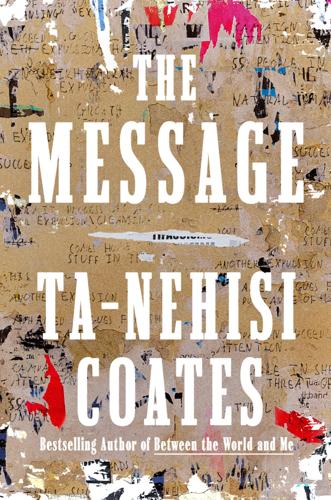
The Message
by
Ta-Nehisi Coates
Published 2 Oct 2024
Perhaps the most important fact in this skepticism was that I had no living models. The few Black writers working at the journals and magazines I read seemed bent on putting as much distance between themselves and Black people as possible. That wasn’t me. If I was skeptical of the gift, I was never skeptical of the people. I came to think of my trade—long-form magazine or new journalism—as a kind of scientific process that, when correctly applied, must necessarily reveal the truth. And for a time I saw the practitioner of that science as an individual, as singular, as standing alone, applying the process, searching for truth. And then I found myself in newsrooms where, for the first time in my life, I was often an only, in newsrooms with no Black editors.
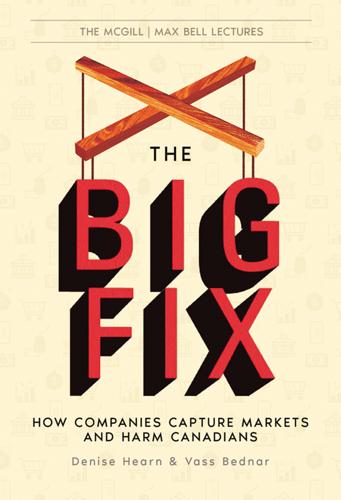
The Big Fix: How Companies Capture Markets and Harm Canadians
by
Denise Hearn
and
Vass Bednar
Published 14 Oct 2024
Although it cited COVID-19 and uncertainty in real estate prices, the real reason was clear: Canada had rejected a monopolists’ vision for one of its prized cities and refused to bow to corporate egoism that thought Canadians would go along to get along. Just a few years later, Canadians were fighting Google again, and Meta, too, as the behemoths attempted to hold the country hostage over a news journalism law: Bill C-18, the Online News Act. The legislation aimed to ensure that tech giants negotiate fair compensation with Canadian news publishers for the use of their content on their platforms. Only Meta and Google were large enough to be accountable to C-18.303 The firms retaliated immediately.
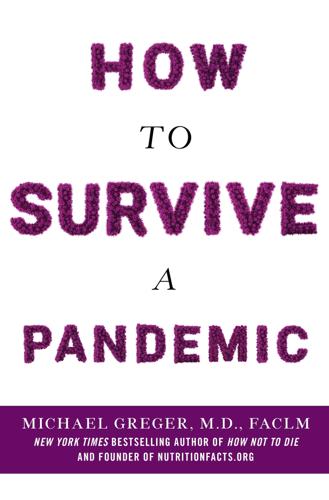
How to Survive a Pandemic
by
Michael Greger, M.D., FACLM
New Scientists, April 24. www.newscientist.com/article/dn3656.html. 814. Bridges CB, Kuehnert MJ, Hall CB. Transmission of influenza: implications for control in health care settings. Clinical Infectious Diseases 37:1094–101. 815. De Gennaro N. 2005. Avian flu pandemic real threat, says national expert. Daily News Journal, October 8. dnj.midsouthnews.com/apps/pbcs.dll/article?AID=/20051008/LIFESTYLE/510080316/1024. 816. Bridges CB, Kuehnert MJ, Hall CB. Transmission of influenza: implications for control in health care settings. Clinical Infectious Diseases 37:1094–101. 817. 2006. Bird flu: the untold story.
…
Nature 437:458–9. 2442. Carr R. 2005. CDC locks up flu data: critics call policy too restrictive. The Atlanta Journal-Constitution, October 3. 2443. Vaillancourt JP. 2002. Biosecurity now. Poultry International. 411:12–8. 2444. Montgomery J. 2005. Public in dark about avian flu cases on farms. News Journal, October 24. www.delawareonline.com/apps/pbcs.dll/article?AID=/20051024/NEWS/510240344. 2445. Rainsford S. 2005. Resentment grows in bird flu town. BBC News, October 11. news.bbc.co.uk/1/hi/world/europe/4329712.stm. 2446. Nordland R. 2005. To stop a virus. Newsweek, October 14. msnbc.msn.com/id/9698067/site/newsweek/. 2447. 2005.
…
[accessed 2020 Apr 12]; https://www.wsj.com/articles/SB110512998255120225. 3240. Gorman C. 2005. How scared should we be? Scared enough to take action. Time, October 17. www.time.com/time/archive/preview/0,10987,1115685,00.html. 3241. De Gennaro N. 2005. Avian flu pandemic real threat, says national expert. Daily News Journal, October 8. 3242. Sandman PM. 2005. The flu pandemic preparedness snowball. Peter Sandman Column, October 10. www.psandman.com/col/panflu3.htm. 3243. New Zealand Ministry of Health. 2005. Ministry of Health flu fact sheet. October 21. xtramsn.co.nz/news/0,11964-4925488,00.html. 3244. Vasquez J. 2006.

Barefoot Into Cyberspace: Adventures in Search of Techno-Utopia
by
Becky Hogge
,
Damien Morris
and
Christopher Scally
Published 26 Jul 2011
* * * A lot of people like to blame the destruction of the media on the internet. 2010 was also the year Rupert Murdoch put the online version of The Times newspaper behind a paywall, having decreed that his customers were “smart enough to know they can’t get something for nothing”. But in truth, the quality of news journalism was falling fast way before the rise of the web. As Nick Davies recounts in his excellent polemic against the modern news machine Flat Earth News, old-school newspaper proprietors of the sixties and seventies were focussed at least to some extent on quality investigative journalism. But they soon gave way to businessmen owners in the eighties and nineties who cared more for the bottom line.
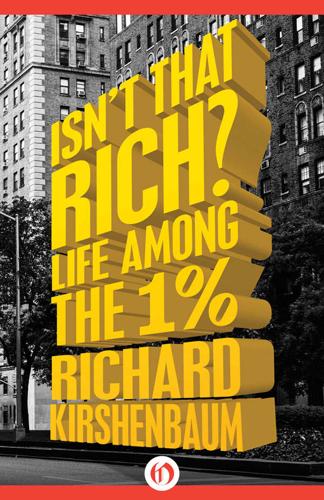
Isn't That Rich?: Life Among the 1 Percent
by
Richard Kirshenbaum
and
Michael Gross
Published 9 Jun 2015
He approached advertising the same way I approached fashion journalism, with tongue firmly in cheek and the rule book balancing on the lip of the trash. Back then, I worked for one of the legends of journalism, an editor named Clay Felker. He’d founded the first magazine I adored, New York, which was one of the crucibles of what was called New Journalism, and was all about “tell the truth, damn the consequences, and do it in a way that’s as entertaining as it is informative.” I went to work for Felker when he started another publication, long since mostly forgotten, that was the spiritual forefather of the formerly pink paper Richard now writes for.
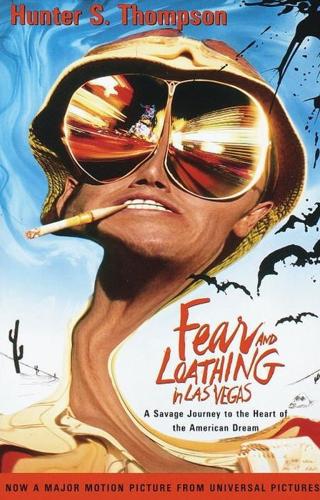
Fear and Loathing in Las Vegas
by
Hunter S. Thompson
and
Ralph Steadman
Published 31 Dec 1970
A hell-raiser from the first, during his twenties Thompson moved quickly through a series of magazine and newspaper jobs – from TIME and The National Observer to a bowling magazine in Puerto Rico, where he wrote his first book, a novel called The Rum Diary that remained unpublished until the late ’90s. Thompson is best known as the godfather of Gonzo Journalism. Taking the New Journalism of the ’60s one step further, Thompson got to the heart of the action by becoming the star of his own reporting – whether by cycling with America’s toughest motorcycle gang, the Hell’s Angels, or downing a frightening collection of psychedelics in the name of the American Dream. In 1970, Hunter S.

Where We Are: The State of Britain Now
by
Roger Scruton
Published 16 Nov 2017
– the first line of the Czech national anthem. 10Information from BMG research on behalf of the Commission for National Renewal. 11On the inherent confrontation between Americanization and European culture see the evocative study by George Steiner, The Idea of Europe, London, 2004. 12See in general David Goodhart, The Road to Somewhere: The Populist Revolt and the Future of Politics, London, 2017, Chapter 4. 13See for example Finbarr Livesey, From Global to Local, London, 2017. 14See John R. Silber, Architecture of the Absurd: How ‘Genius’ Disfigured a Practical Art, London, 2007. 15See Guy Debord, La société du spectacle, Paris, 1967, Jean Baudrillard, Simulacres et simulation, Paris, 1981; G. Lipovetsky and J. Serroy, L’esthétisation du monde, Paris, 2006. 16See the new journal Limite, for example, which advocates an integral ecology, in which the human settlement is defended alongside the natural environment. 17See George A. Akerlof and Rachel E. Kranton, Identity Economics: How Our Identities Shape Our Work, Wages and Well-being, Princeton, 2010. 7 OUT INTO THE WORLD The argument is often made that Britain belongs in Europe and will be bereft of its true identity if it leaves the Union.
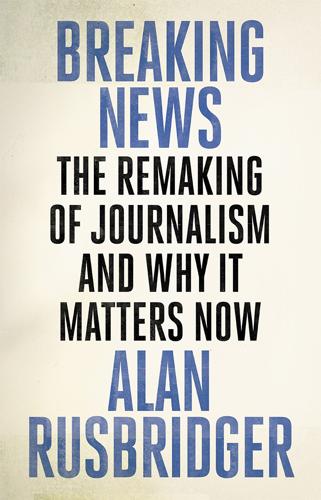
Breaking News: The Remaking of Journalism and Why It Matters Now
by
Alan Rusbridger
Published 14 Oct 2018
A lot of academics watching the industry from the outside placed the open v. closed debates in a longer historical context. Quite a few who knew their press history were doubtful if the media industry could ever adapt to openness because its history had been predicated on being closed. Jay Rosen, a thoughtful sociology professor at NYU in New York who later became involved in a new journalism start-up,17 put it like this when I dropped in on him in 2011 – for 200 years there had been two different ways of profiting from news, the newsletter model or news for the public: The oldest way [of news information] was a private good for rich people. The first people to be paid as correspondents were in the pay of rich merchants in the 15th and 16th centuries, who needed to know about conditions and trade in cities other than the ones they lived in.
…
I remember reading an interview with [Guardian editor] Rusbridger, and he was talking about making the Guardian “a global newspaper” and I thought “actually, that’s a pretty cool idea”. So I started talking to Paul [Dacre] and co. and said “Why don’t we follow the traffic? Why don’t we put some people into California – into LA?” And that worked. Then they said we really want to be in New York, that’s the centre, that’s the place to be for news journalism. So we started building a team in New York. And it’s just continued to grow, we just followed our success if you like. It’s really that simple’. (Quoted in Addison, Mail Men; see Bibliography) 4. Dixon had been hired by a Newcastle-based developer, Peter Millican, who wanted a concert hall in the basement which he would run.
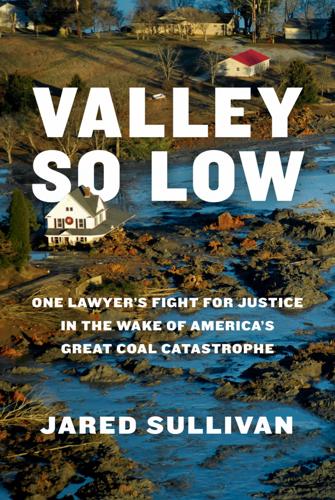
Valley So Low: One Lawyer's Fight for Justice in the Wake of America's Great Coal Catastrophe
by
Jared Sullivan
Published 15 Oct 2024
GO TO NOTE REFERENCE IN TEXT the two sides settled: Ibid. GO TO NOTE REFERENCE IN TEXT usually brought along: Background interviews with two former Neal & Harwell attorneys. GO TO NOTE REFERENCE IN TEXT as a high-school wrestler: Josh Ezzell, “Six Area Wrestlers Advance at State Tourney,” Daily News Journal, February 16, 2001. GO TO NOTE REFERENCE IN TEXT idolized his dad: Four former Neal & Harwell attorneys spoke with me about Isaac Sanders. He declined an interview request. GO TO NOTE REFERENCE IN TEXT Danny Gouge: Danny Gouge interview; Adkisson et al. v.
…
GO TO NOTE REFERENCE IN TEXT “a material adverse effect”: Jacobs Engineering Group, Fiscal Year 2020 SEC filing, Form 10-K, p. F-60. GO TO NOTE REFERENCE IN TEXT seventeen in all: Jamie Satterfield, “TVA Contractor Cannot Punish Workers over Mediation Leak,” News Sentinel via Daily News-Journal, July 17, 2020. GO TO NOTE REFERENCE IN TEXT fifty dead Kingston workers: Jamie Satterfield, “Coal Ash Keeps Killing,” News Sentinel via The Tennessean, September 11, 2020; I was also provided a list of the dead Kingston workers by the plaintiffs’ attorneys. GO TO NOTE REFERENCE IN TEXT “Clients are losing their homes”: Keith Stewart email, February 2020.
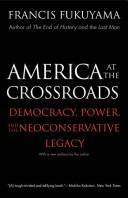
America at the Crossroads: Democracy, Power, and the Neoconservative Legacy
by
Francis Fukuyama
Published 20 Mar 2007
It is much more Preface important to redefine American foreign policy in a way that moves beyond the Bush administration's legacy and that of its neoconservative supporters. This book is an attempt to elucidate the neoconservative legacy, explain where in my view the Bush administration has gone wrong, and outline an alternative way for the United States to relate to the rest of the world. This has also motivated my effort to start a new journal devoted to the question of America's role in the world, The America?! Interest (www.the-american-interest.com). The position I want to stake out is not captured by any existing schools within the U.S. foreign policy debate, but it is one that I think would win support from a fairly broad spectrum of Americans.
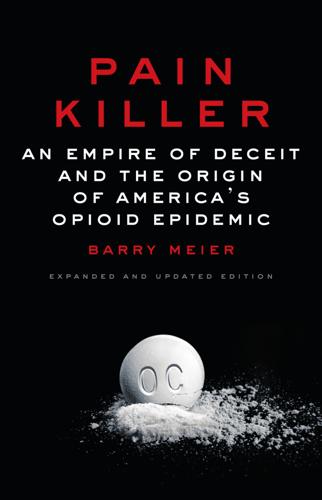
Pain Killer: An Empire of Deceit and the Origins of America’s Opioid Epidemic
by
Barry Meier
Published 29 Oct 2020
He tried to piece together a tangled business trail, one made more impenetrable because the companies involved were private and so didn’t have to disclose their true ownership. Names involved with the Sacklers kept popping up, including that of a lawyer and an accountant who had done work for Arthur. Lear noted that a news agency owned by Arthur was the first to announce in 1951 that Welch would edit a new journal called Antibiotics and Chemistry. He also discovered that Mortimer Sackler sat on the editorial board of another antibiotics-related publication, whose research articles had been cited in the ad created by William Douglas McAdams for the antibiotic Sigmamycin—the same ad that featured the business cards for doctors who didn’t exist.

Neutrino Hunters: The Thrilling Chase for a Ghostly Particle to Unlock the Secrets of the Universe
by
Ray Jayawardhana
Published 10 Dec 2013
Additional useful sources include the popular article by Francis Reddy, “Time for SNEWS,” at the Astronomy magazine website, www.astronomy.com/en/sitecore/content/Home/News-Observing/News/2005/06/Time%20for%20SNEWS.aspx; and the technical article by Pietro Antonioli, “SNEWS: The SuperNova Early Warning System,” New Journal of Physics 6 (2004): 114. 136 “We will be able”: From the author’s telephone interview with Francis Halzen, conducted on December 12, 2011. 136 Helium and Lead Observatory: Project website is at www.snolab.ca/halo/. 136 Long-Baseline Neutrino Experiment: See, e.g., Adrian Cho, “DOE Scraps Plans for Neutrino Experiment in Mine,” ScienceInsider, March 22, 2012, http://news.sciencemag.org/scienceinsider/2012/03/doe-scraps-plans-for-neutrino.html; and Eugenie Samuel Reich, “US Physicists Fight to Save Neutrino Experiment,” Nature News, March 26, 2012, www.nature.com/news/us-physicists-fight-to-save-neutrino-experiment-1.10305. 138 Laser Interferometer Gravitational-Wave Observatory: By far the best popular account of the science and the technological challenge behind LIGO is Marcia Bartusiak, Einstein’s Unfinished Symphony: Listening to the Sounds of Space-Time (Washington, D.C.: Joseph Henry Press/National Academies Press, 2000). 140 “diffuse supernova neutrino background”: See John Beacom, “The Diffuse Supernova Neutrino Background,” Annual Review of Nuclear and Particle Science 60 (November 2010): 439–62; preprint available online at http://arxiv.org/abs/1004.3311. 141 Eta Carinae: See, e.g., Michael Lemonick, “Supernova Countdown: Giant Star Could Explode Any Day Now,” Time, February 16, 2012, www.time.com/time/health/article/0,8599,2106904,00.html; and the website of the Eta Carinae research group at the University of Minnesota, http://etacar.umn.edu/. 7.
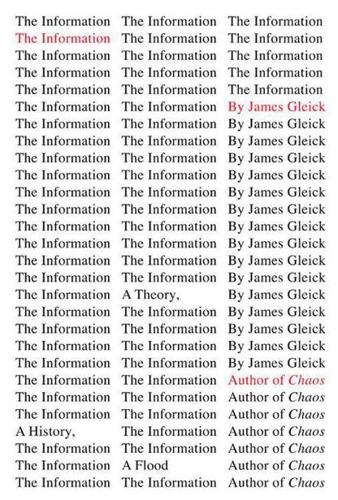
The Information: A History, a Theory, a Flood
by
James Gleick
Published 1 Mar 2011
“Having placed the discipline of psychology for the first time on a sound scientific basis, the author modestly leaves the filling in of the outline to the psychologists.” He suggested his colleagues give up larceny for a life of honest toil. These warnings from Shannon and Elias appeared in one of the growing number of new journals entirely devoted to information theory. In these circles a notorious buzzword was entropy. Another researcher, Colin Cherry, complained, “We have heard of ‘entropies’ of languages, social systems, and economic systems and of its use in various method-starved studies. It is the kind of sweeping generality which people will clutch like a straw.”♦ He did not say, because it was not yet apparent, that information theory was beginning to change the course of theoretical physics and of the life sciences and that entropy was one of the reasons.
…
.”♦ Newton quantified mass and force, but simplicity had to wait. Chaitin sent his paper to the Journal of the Association for Computing Machinery. They were happy to publish it, but one referee mentioned that he had heard rumors of similar work coming from the Soviet Union. Sure enough, the first issue of a new journal arrived (after a journey of months) in early 1966: , Problems of Information Transmission. It contained a paper titled “Three Approaches to the Definition of the Concept ‘Amount of Information,’ ” by A. N. Kolmogorov. Chaitin, who did not read Russian, had just time to add a footnote. Andrei Nikolaevich Kolmogorov was the outstanding mathematician of the Soviet era.
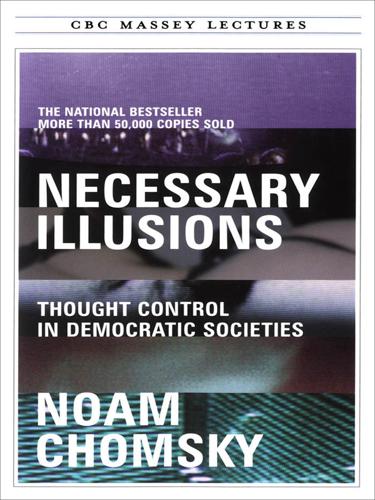
Necessary Illusions
by
Noam Chomsky
Published 1 Sep 1995
This classic of modern scholarship was alleged to have demonstrated that in their incompetent and biased coverage reflecting the “adversary culture” of the sixties, the media in effect lost the war in Vietnam, thus harming the cause of democracy and freedom for which the United States fought in vain. The Freedom House study concluded that these failures reflect “the more volatile journalistic style—spurred by managerial exhortation or complaisance—that has become so popular since the late 1960s.” The new journalism is accompanied by “an often mindless readiness to seek out conflict, to believe the worst of the government or of authority in general, and on that basis to divide up the actors on any issue into the ‘good’ and the ’bad’.” The “bad” actors included the U.S. forces in Vietnam, the “military-industrial complex,” the CIA and the U.S. government generally; and the “good,” in the eyes of the media, were presumably the Communists, who, the study alleged, were consistently overpraised and protected.
…
Their market is advertisers, and the “product” is audiences, with a bias towards more wealthy audiences, which improve advertising rates.16 Over a century ago, British Liberals observed that the market would promote those journals “enjoying the preference of the advertising public”; and today, Paul Johnson, noting the demise of a new journal of the left, blandly comments that it deserved its fate: “The market pronounced an accurate verdict at the start by declining to subscribe all the issue capital,” and surely no right-thinking person could doubt that the market represents the public will.17 In short, the major media—particularly, the elite media that set the agenda that others generally follow—are corporations “selling” privileged audiences to other businesses.

The Gods of New York: Egotists, Idealists, Opportunists, and the Birth of the Modern City: 1986-1990
by
Jonathan Mahler
Published 11 Aug 2025
He dropped out of college to become a copyboy at the now-defunct Long Island Press and worked his way up to reporting before writing a breakout book about the hapless first season of the New York Mets, memorably titled, Can’t Anybody Here Play This Game? Another soon-to-be-defunct paper, the New York Herald Tribune, hired him as a news columnist in 1963, and he quickly became one of the city’s most distinctive voices, a pioneer of the so-called New Journalism movement, which introduced novelistic techniques to newspaper and magazine writing. Since then, he had run for city council on a ticket that featured Norman Mailer as mayor, received a handwritten letter from the Son of Sam serial killer, and filed many hundreds of thousands of inches of copy.
…
Zion Church, 160 Motley, Constance Baker, 320 Moynihan, Daniel Patrick, 177 Muhammad, Khallid, 298 Muhammad, Maryam, 393 Murdoch, Rupert, 20, 37, 60 Murphy, Eddie, 214, 289 Murphy, Stephen, 197 Museum of Modern Art, 10 Museum Tower, 10 Myerson, Bess, 19, 20, 23, 168–69, 217, 304–8 Myerson, David, 324 N NAACP, 103, 117, 120, 267 Nabisco, 7 Nathan, Richard, 19, 22, 163–64, 165, 169, 177, 216–17, 260 Nation of Islam, 4, 65, 224, 298 National Conference of Black Lawyers, 116 National Institute of Allergy and Infectious Diseases, 260 National Institutes of Health (NIH), 261, 300, 355 National Rifle Association, 147 National Youth Movement, 105, 107, 303, 358, 394 naturalization, 60 NBC, 151–52, 268 needle exchange programs, 164–65, 354 New Jersey Casino Control Commission, 157, 254, 348 New Journalism movement, 38 New Park Pizza, 112, 114, 120, 273 New School for Social Research, 137–138 New York Amsterdam News, 62, 131, 153, 290–91 New York City Board of Education, 45 New York City Board of Estimate, 27 New York City Civilian Complaint Review Board, 283, 286 New York City Department of Correction, 65 New York City Fire and Building, 245 New York City Fire Department (NYFD), 7 New York City Health and Hospitals Corporation, 124–25, 263 New York City Housing Authority, 294 New York City Police Department (NYPD) anti-crack unit, 71, 245 Black officers, 64 Byrne shooting, 243–45 corruption, 80–81, 103 Davis case, 102–5 Emerald Society Pipes & Drums band, 398 Griffith case, 105, 111–15 misconduct complaints, 283, 285–86, 332–33 Nation of Islam mosque incident, 64–65 Office of Management Analysis, 286 106th precinct, 69, 112–14 police brutality, 66–67, 68–69, 275, 281–83 protests, 401–2 secret surveillance operations, 161–62, 165, 204–5 77th precinct, 78, 80–81, 133 shootings by, 12, 116–17, 147, 273, 322, 333, 401 Ward’s tenure as commissioner, 66–69, 79–81, 102–5, 113–14, 134, 167, 187, 243–45, 283, 285–86, 332–34, 384–85 New York Civil Liberties Union (NYCLU), 191–92, 194, 229–30, 237, 264, 293–94 New York Herald Tribune, 38 New York Post, 20, 37–38 New York Stock Exchange (NYSE), 182–84 The New York Times, 37, 290–91 New York University Film School, 212 New York University School of Law, 17, 32, 41 Newfield, Jack, 86, 168, 351 Newhouse, Si, 172, 209–10 Newsday, 37, 38, 230–34 newspapers, 36–39, 62 Nicholson, Joe, 58 NIH.
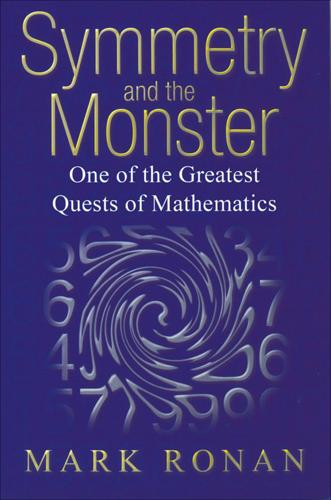
Symmetry and the Monster
by
Ronan, Mark
Published 14 Sep 2006
Writing about it later he recalled that ‘One of the most exciting moments of my life was when, after computing several of these series, I went down to our mathematical library and found some of them in Jacobi’s “Fundamenta nova theoriæ” ... with the same coefficients down to the last decimal digit!’* Conway was good at reading these old papers, and recalls that, as an undergraduate, ‘I turned the pages of every paper Euler published in the new journal from St Petersburg’ – Euler, who lived in the eighteenth century, was the most prolific mathematician of all time, and his proofs were very stimulating, with lots of good ideas. As Conway says, ‘Euler would prove a theorem, and later someone would modify his theorem and produce a more complicated proof, but if you wanted to understand what was really going on you had to go back to Euler.’
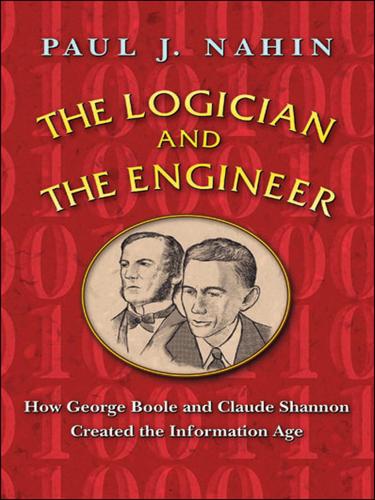
The Logician and the Engineer: How George Boole and Claude Shannon Created the Information Age
by
Paul J. Nahin
Published 27 Oct 2012
question, a new math journal was looking for manuscripts that might not be accepted by the established journals, perhaps (for example) for being too controversial.3 This was the Cambridge Mathematical Journal, which had begun publication in October 1837. From the very start it published papers from such talented people as Augustus De Morgan, Arthur Cayley, James Sylvester, and George Stokes, all mathematicians whose names are well known today. Perhaps, in fact, it was the appearance of this new journal that caused Boole to begin writing. The young editor of the Journal, less than three years older than Boole, was the Scottish mathematician Duncan F. Gregory (1813–1844), who had received a magnificent education that Boole could only have dreamed about. The youngest son of a professor of medicine at King’s College in Aberdeen, he had first attended Edinburgh Academy (where James Clerk Maxwell would later study), then was sent off to a private academy in Geneva, then brought back to Edinburgh University and, finally, finished his studies at Newton’s school, Trinity College, Cambridge.

Big Data at Work: Dispelling the Myths, Uncovering the Opportunities
by
Thomas H. Davenport
Published 4 Feb 2014
. • Very few organizations competed on analytics—for most, analytics were marginal to their strategy. Data science first began to be discussed in earnest by academics around 2001; the Purdue statistician William S. Cleveland published a paper advocating for the field in that year, and in the following two years two new journals of data science were created.6 Beginning in 2003 or so, the commercial world began to take notice of big data, and let’s call the early 2000s the beginning of Analytics 2.0. The era began with the exploitation of online data in internet-based firms like Google, Yahoo!, and eBay—the earliest adopters of the “data economy.”
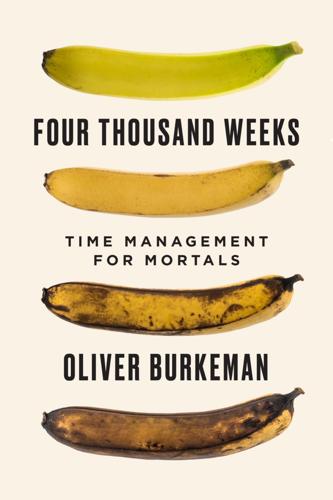
Four Thousand Weeks: Time Management for Mortals
by
Oliver Burkeman
Published 9 Aug 2021
My respect for the rock star Rod Stewart: Steve Flint and Craig Tiley, “In My Heart, and in My Soul: Sir Rod Stewart on His Lifelong Love of Model Railways,” Railway Modeler, December 2019. The publisher and editor Karen Rinaldi: Karen Rinaldi, “(It’s Great to) Suck at Something,” New York Times, April 28, 2017. 10. The Impatience Spiral The practice of inching toward the car in front: S. Farzad Ahmadi et al., “Latent Heat of Traffic Moving from Rest,” New Journal of Physics 19 (2017), available at iopscience.iop.org/article/10.1088/1367–2630/aa95f0 [inactive]. It has been calculated that if Amazon’s front page loaded one second more slowly: See Kit Eaton, “How One Second Could Cost Amazon $1.6 Billion in Sales,” Fast Company, March 15, 2012, available at www.fastcompany.com/1825005/how-one-second-could-cost-amazon-16-billion-sales.
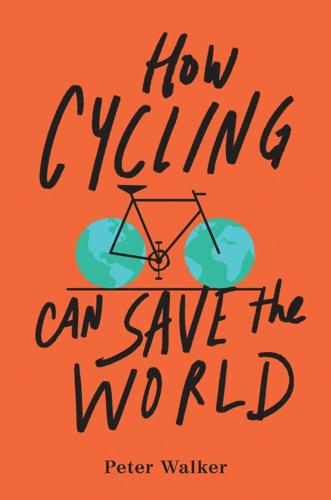
How Cycling Can Save the World
by
Peter Walker
Published 3 Apr 2017
Let’s Help Prevent Them,” RachelAldred.org, July 9, 2013, http://rachelaldred.org/writing/thoughts/these-deaths-are-preventable-lets-help-prevent-them. CHAPTER 6 1 Interview with the author. 2 Interview with the author. 3 Dan Carrier, “CS11 Bike Route Plans: Is It Cyclists vs Tom Conti and the Car Drivers?” Camden New Journal, March 7, 2016, http://www.camdennewjournal.com/cs11-conti. 4 UK Parliament, “Daily Hansard,” Monday, December 14, 2015, http://www.publications.parliament.uk/pa/ld201516/ldhansrd/text/151214-0001.htm. 5 Andrew Gilligan, “‘If You Want Cycling Improvements, You Have to Keep Fighting for Them,’” The Guardian, March 17, 2016, https://www.theguardian.com/environment/bike-blog/2016/mar/17/if-you-want-cycling-improvements-you-have-to-keep-fighting-for-them. 6 Interview with the author. 7 Interview with the author. 8 Natalie O’Neill, “The Prospect Park West Bike Lane Had our Presses Rolling All Year Long,” The Brooklyn Paper, December 30, 2011, http://www.brooklynpaper.com/stories/34/52/all_year_bikelane_2011_12_30_bk.html. 9 Interview with the author. 10 Interview with the author. 11 Odense city statistics. 12 Interview with the author. 13 “The Portland Bicycle Story,” Portland State University, http://www.pdx.edu/ibpi/sites/www.pdx.edu.ibpi/files/portlandbikestory_1.pdf. 14 Michael Andersen, “Portland’s New Surge in Bike Commuting Is Real—and It’s Gas-Price Proof,” BikePortland.org, September 5, 2016, http://bikeportland.org/2016/09/15/what-gas-prices-portland-bike-commuting-stays-strong-new-data-show-191430. 15 Odense city statistic. 16 Interview with the author. 17 Beijing Transport Research Centre (2011), cited by Sustainable Transport in China. 18 This is the WHO estimate; official Chinese road fatality statistics are widely seen as too low. 19 Interview with the author. 20 Philippines census 2015. 21 Tony Lopez, “Solving Manila’s Traffic,” Manila Standard, June 4, 2014, http://manilastandardtoday.com/opinion/columns/virtual-reality-by-tony-lopez/149020/solving-manila-s-traffic.html. 22 Interview with the author. 23 At The Guardian Live event, “How can we get more people cycling in London?”
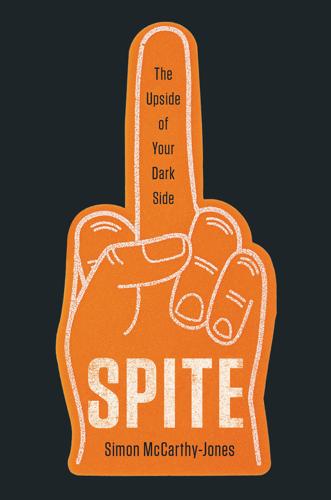
Spite: The Upside of Your Dark Side
by
Simon McCarthy-Jones
Published 12 Apr 2021
Ansell-Pearson, trans. C. Diethe (Cambridge, UK: Cambridge University Press, 2006 [1887]), 20. 22. Which brings to mind a classic scene from Blackadder Goes Forth: www.youtube.com/watch?v=yZT-wVnFn60. 23. X. Chen, A. Szolnoki, and M. Perc, “Probabilistic Sharing Solves the Problem of Costly Punishment,” New Journal of Physics 16, no. 8 (2014): 083016. 24. N. J. Raihani and R. Bshary, “Punishment: One Tool, Many Uses,” Evolutionary Human Sciences 1 (2019): e12. 25. Raihani and McAuliffe, “Human Punishment Is Motivated by Inequity Aversion.” 26. D. Balliet, L. B. Mulder, and P. A. van Lange, “Reward, Punishment and Cooperation: A Meta-analysis,” Psychological Bulletin 137, no. 4 (2011): 594–615. 27.
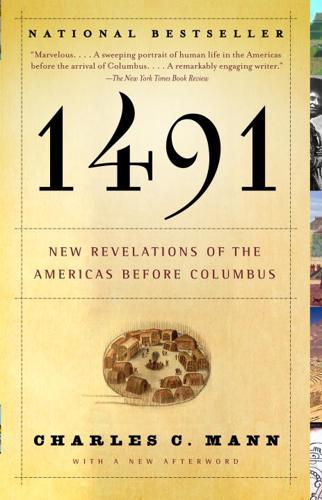
1491
by
Charles C. Mann
Published 8 Aug 2005
“Sequence and Organization of the Human Mitochondrial Genome.” Nature 290:457–65. Anello Oliva, G. 1998. Historia del Reino y Provincias del Perú y Vidas de los Varones Insignes de la Compañía de Jesús. Lima: Pontificia Universidad Católica del Perú (1631). Anon. 2003. “Whiteman, James” (obituary). Clovis (N.M.) News Journal, 23 Sep. ———. 1994. “Leyenda de los Soles.” Trans. T. Sullivan. In Sullivan and Knab 1994, 62–81. ———. 1982. El Maíz, Fundamento de la Cultura Popular Mexicana. Mexico City: Museo Nacional de Culturas Populares. ———. 1979. “Occurents in Newfoundland,” 1 Sep. 1612–1 Apr. 1613, in D. B.
…
. ———. 1939. Peter Wilhelm Lund no Brasil: Problemas de Paleontologia Brasiliera. São Paulo: Companhia Editora Nacional. Mazour, A. G., and J. M. Peoples. 1968. A World History: Men and Nations. New York: Harcourt Brace. McAlavy, D. 2003. “Tales of 91 Years in Clovis as a Family.” Clovis (N.M.) News Journal, 10 Sep. McCaa, R. 1995. “Spanish and Nahuatl Views on Smallpox and Demographic Catastrophe in Mexico.” Journal of Interdisciplinary History 25:397–431. McCaa, R., A. Nimlos, and T. Hampe-Martínez. 2004. “Why Blame Smallpox? The Death of the Inca Huayna Capac and the Demographic Destruction of Tawantinsuyu (Ancient Peru).”
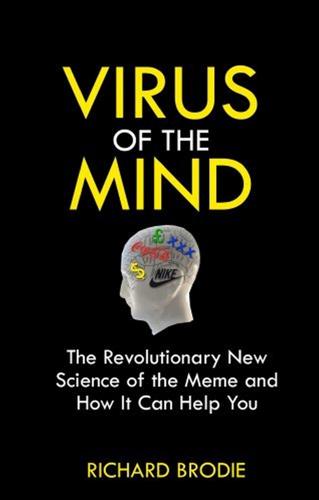
Virus of the Mind
by
Richard Brodie
Published 4 Jun 2009
The point is, the institution of television, while originally created as entertainment, has evolved into a self-perpetuating cultural virus with little possibility of anything but broadcasting the 158 Cultural Viruses most gripping, button-pushing sounds and images. That’s true not only of the entertainment portion of television but also of the news. Journalism The idea behind freedom of speech, in the minds of the framers of the Constitution, was that if all ideas were given equal opportunity to compete in a sort of free market of the mind, the truth would emerge victorious. Unfortunately, this is not the case. It’s successful mind viruses that emerge victorious, spreading their selfish memes.

Gaza in Crisis: Reflections on Israel's War Against the Palestinians
by
Ilan Pappé
,
Noam Chomsky
and
Frank Barat
Published 9 Nov 2010
As part of his efforts to sabotage such a development, he enlisted an official (of Canadian origin) who worked in the UN’s public relations office: Isaiah L. “Si” Kenen. Kenen’s first assignment was to write an article alerting the public to the dangers incurred by the anti-Israeli orientation of U.S. policy in the Middle East. The same message was forcefully conveyed in a series of articles Kenen published in a new journal, the Near East Policy, which became the pro-Israeli lobby’s mouthpiece (funded partly by Israel). Kenen began organizing Jewish support, first in local trade unions and then in communities across the country. The Washington Institute for Near East Policy was founded around the journal as AIPAC’s think tank.
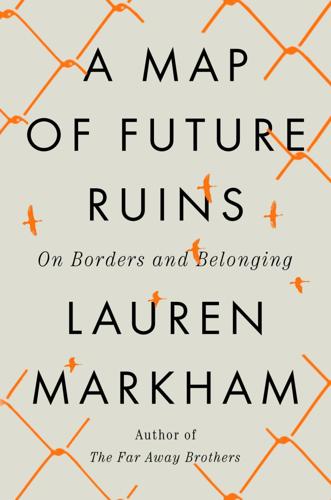
A Map of Future Ruins: On Borders and Belonging
by
Lauren Markham
Published 13 Feb 2024
I get to be a full person in the United States of America, this place like a dusty trunk stuffed with old and new hopes, true and untrue stories—a white person who belongs, now, barely a number at all. PART III Future 18. In those early months of COVID, people continued to hover in the unknown, wondering what was safe and what might be deadly, and yearning to know what the future held for this apocalyptic world. News—journalism—became a lifeline, but also fuel for more anxiety and fear. I stayed glued to my phone, not only in search of reliable information about the virus but in order to follow what was happening in Greece: refugees penned inside Moria, clashes between the NGOs and the fascists, the suspension of asylum claims.
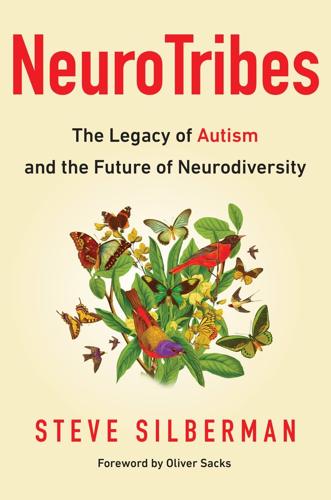
NeuroTribes: The Legacy of Autism and the Future of Neurodiversity
by
Steve Silberman
Published 24 Aug 2015
Kanner knew there must be many more children like Virginia, passing the empty hours in dayrooms and lockdown wards without anyone knowing who they really were. After seeing eight children who fit the pattern, he was ready to tell the world about his discovery. VII In January 1942, Ernest Harms, the editor of a new journal called The Nervous Child, asked Kanner if he would consider guest-editing an upcoming issue. Seeing an opportunity to position his work at the leading edge of a wave of research on affect disorders of childhood, Kanner intimated that he was on the verge of a major breakthrough. “I have followed a number of children who present a very interesting, unique and as yet unreported condition, which has both interested and fascinated me for quite some time,” he said.
…
Centers for Disease Control and Prevention. http://www.cdc.gov/healthyyouth/noise/signs.htm#3 Harvard Inductorium: “The First Stimulators—Reviewing the History of Electrical Stimulation and the Devices Crucial to Its Development,” L. A. Geddes. Engineering in Medicine and Biology Magazine, No. 4, Vol. 13, Aug.–Sept. 1994. used in canine obedience tests: Mansfield News Journal, March 31, 1963. “a commercially available device for shocking livestock”: “The Effects and Side Effects of Punishing the Autistic Behaviors of a Deviant Child,” Todd R. Risley. Journal of Applied Behavioral Analysis, No. 1, 1968. (Note: Risley says in the paper that the experiments described commenced in 1963.)
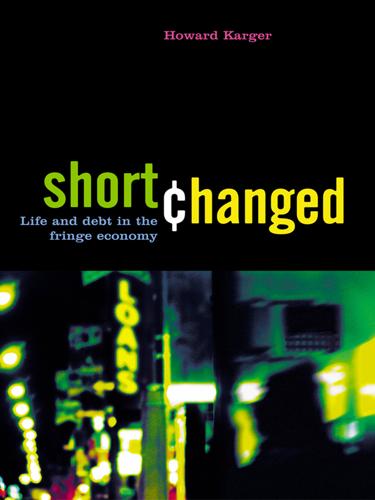
Shortchanged: Life and Debt in the Fringe Economy
by
Howard Karger
Published 9 Sep 2005
CHAPTER 7: FRINGE HOUSING 1 Joint Center for Housing Studies of Harvard University, The State of the Nation’s Housing (Cambridge, MA: Harvard University, 2003), 22. 2 Eric Stein, Quantifying the Economic Cost of Predatory Lending, Coalition for Responsible Lending and the Reinvestment Fund, Durham, NC, 2001. 3 Prime-rate mortgages are low-interest loans given to a bank’s most creditworthy customers. 4 Thomas Feran, “Two Incomes Still Don’t Add Up,” Houston Chronicle, September 22, 2003. 5 Joint Center for Housing Studies of Harvard University, The State of the Nation’s Housing. 6 Edward Gramlich, remarks, Federal Reserve Bank of Philadelphia, Community and Consumer Affairs, Washington, DC, December 6, 2000. 7 Ibid. 8 Ibid. 9 Securitization is the process of aggregating similar instruments, such as loans or mortgages, into a negotiable security. 10 National Low Income Housing Coalition, 2003 Advocates’ Guide to Housing and Community Development Policy, Washington, DC, 2003; Jonathan Epstein, “Sub-prime Loan Growth: Minorities in Wilmington Pay Higher Fees,” The News Journal, November 27, 2002. 11 Center for Responsible Lending, “Newsbrief: Predatory Loan Terms and Subprime Foreclosures,” January 26, 2005, www.responsiblelending.org/news_headlines/nb012605.cfm. 12 Thomas Goetz, “Loan Sharks, Inc.,” The Village Voice, July 15, 1997. 13 Edward M. Gramlich, “Subprime Mortgage Lending” (presentation to Roundtable Annual Housing Policy Meeting, Chicago, Illinois, May 21, 2004. 14 Roberto G.

The People's Platform: Taking Back Power and Culture in the Digital Age
by
Astra Taylor
Published 4 Mar 2014
Aside from a one-person ABC bureau in Nairobi, there are no network bureaus left at all in Africa, India or South America—regions that are home to more than 2 billion people.” Pamela Constable, “Demise of the Foreign Correspondent,” Washington Post, February 18, 2007. 20. Natalie Fenton, New Media, Old News: Journalism and Democracy in the Digital Age (New York: Sage Publications, 2009), 191. The Paul Starr article is also relevant on this issue, in addition to Nat Ives, “It’s Not Newspapers in Peril; It’s Their Owners,” Advertising Age, February 23, 2009; and Mark Edge, “Not Dead Yet: Newspaper Company Annual Reports Show Chains Still Profitable,” paper presented to the Association for Education in Journalism and Mass Communication Annual Convention, Chicago, Illinois, August 9–12, 2012, http://www.marcedge.com/Notdeadyet.pdf. 21.
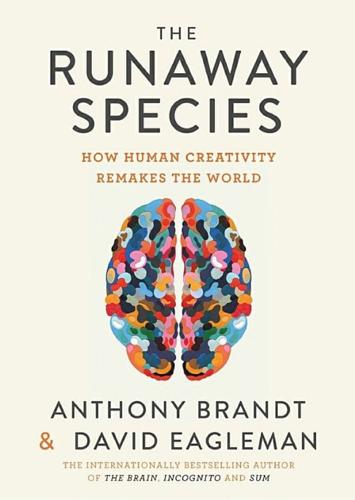
The Runaway Species: How Human Creativity Remakes the World
by
David Eagleman
and
Anthony Brandt
Published 30 Sep 2017
New York: Princeton Architectural Press, 2008. Raphel, Adrienne. “Competition for McDonald’s, and for Ronald.” New Yorker. April 23, 2014. Accessed June 3, 2014. <http://www.newyorker.com/business/currency/competition-for-mcdonalds-and-for-ronald> Rassenfoss, Stephen. “Increased Oil Production with Something Old, Something New.” Journal of Petroleum Technology 64, no. 10 (2012). Accessed August 14, 2014. doi:10.2118/1012-0036-JPT. https://doi.org/10.2118/1012-0036-JPT https://www.onepetro.org/journal-paper/SPE-1012-0036-JPT Recasens, M., Sumie Leung, Sabine Grimm, Rafal Nowak, & Carles Escera. “Repetition suppression and repetition enhancement underlie auditory memory-trace formation in the human brain: an MEG study.”
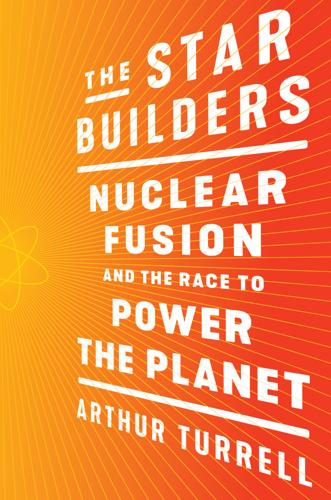
The Star Builders: Nuclear Fusion and the Race to Power the Planet
by
Arthur Turrell
Published 2 Aug 2021
Penzias, “Big Bang Theory Makes Sense of Cosmic Facts; No Contradiction,” New York Times (1991), https://www.nytimes.com/1991/06/18/opinion/l-big-bang-theory-makes-sense-of-cosmic-facts-no-contradiction-092291.html; B. Feuerbacher and R. Scranton, “Evidence for the Big Bang” (2006), http://www.talkorigins.org/faqs/astronomy/bigbang.html#lerner. 18. D. Klir et al., “Ion Acceleration Mechanism in Mega-Ampere Gas-Puff Z-Pinches,” New Journal of Physics 20 (2018): 053064; M. Krishnan, “The Dense Plasma Focus: A Versatile Dense Pinch for Diverse Applications,” IEEE Transactions on Plasma Science 40 (2012): 3189–221. 19. M. Halper, “Startup Nuclear Energy Companies Augur Safer, Cheaper Atomic Power,” Fortune (2014), https://fortune.com/2014/07/03/startup-nuclear-energy-companies/; M.
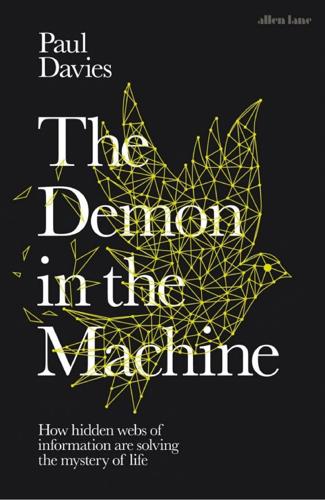
The Demon in the Machine: How Hidden Webs of Information Are Finally Solving the Mystery of Life
by
Paul Davies
Published 31 Jan 2019
Gábor Vattay et al., ‘Quantum criticality at the origin of life’, Journal of Physics: Conference Series, 626, 012023 (2015). 4. Ibid. 5. Gregory S. Engel et al., ‘Evidence for wavelike energy transfer through quantum coherence in photosynthetic systems’, Nature, vol. 446, 782–6 (12 April 2007); doi: 10.1038/nature05678. 6. Patrick Rebentrost et al., ‘Environment-assisted quantum transport’, New Journal of Physics, 11 (3):033003 (2009). 7. Roswitha Wiltschko and Wolfgang Wiltschko, ‘Sensing magnetic directions in birds: radical pair processes involving cryptochrome’, Biosensors, 4, 221–42 (2014). 8. Ibid. 9. Thorsten Ritz et al., ‘Resonance effects indicate a radical-pair mechanism for avian magnetic compass’, Nature, 429, 177–80 (13 May 2004); doi: 10.1038/nature02534. 10.
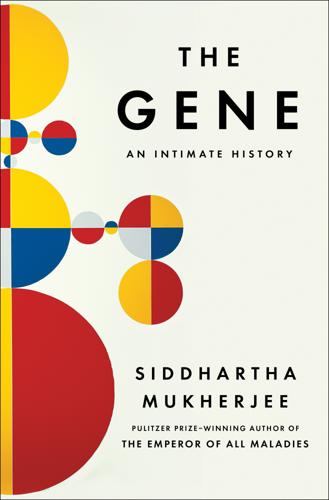
The Gene: An Intimate History
by
Siddhartha Mukherjee
Published 16 May 2016
As an afterthought, he added, “I think,” above the page, as if to signal his last point of departure from the mainlands of biological and theological thought. But—with God shoved aside—what was the driving force behind the origin of species? What impetus drove the descent of, say, thirteen variants of finches down the fierce rivulets of speciation? In the spring of 1838, as Darwin tore into a new journal—the maroon C notebook—he had more thoughts on the nature of this driving force. The first part of the answer had been sitting under his nose since his childhood in the farmlands of Shrewsbury and Hereford; Darwin had merely traveled eight thousand miles around the globe to rediscover it. The phenomenon was called variation—animals occasionally produced offspring with features different from the parental type.
…
Bettany and John Parker Anderson, Life of Charles Darwin (London: W. Scott, 1887), 47. rather than all species radiating out: Duncan M. Porter and Peter W. Graham, Darwin’s Sciences (Hoboken, NJ: Wiley-Blackwell, 2015), 62–63. As an afterthought, he added, “I think”: Ibid., 62. In the spring of 1838, as Darwin tore into a new journal: Timothy Shanahan, The Evolution of Darwinism: Selection, Adaptation, and Progress in Evolutionary Biology (Cambridge: Cambridge University Press, 2004), 296. But the answer that came to him in October 1838: Barry G. Gale, “After Malthus: Darwin Working on His Species Theory, 1838–1859” (PhD diss., University of Chicago, 1980).
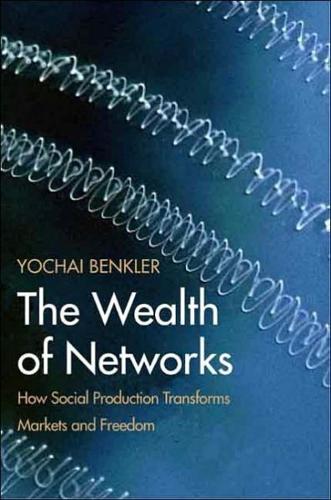
The Wealth of Networks: How Social Production Transforms Markets and Freedom
by
Yochai Benkler
Published 14 May 2006
What is left in determining the overall weight that these open-access journals will have in the landscape of scientific publication is the relatively conservative nature of universities themselves. The established journals, like Science or Nature, still carry substantially more prestige than the new journals. As long as this is the case, and as long as hiring and promotion decisions continue to be based on the prestige of the journal in which a scientist's work is published, the ability of the new journals to replace the traditional ones will be curtailed. Some of the established journals, however, are operated by professional associations of scientists. There is an internal tension between the interests of the associations in securing [pg 325] their revenue and the growing interest of scientists in open-access publication.
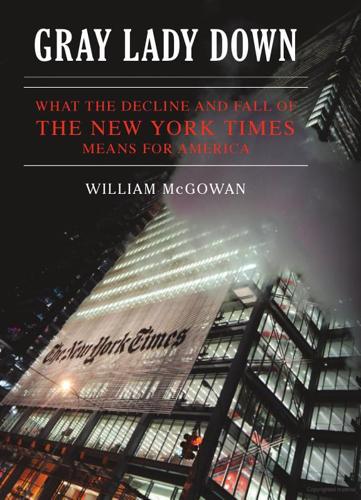
Gray Lady Down: What the Decline and Fall of the New York Times Means for America
by
William McGowan
Published 16 Nov 2010
Rosenthal kept the Times “straight” by battling what he saw as the ingrained left-liberal tendencies of the newsroom, particularly the Washington bureau. He scolded reporters and editors he thought were romanticizing the sixties counterculture, which he viewed as a destructive force. While encouraging reporters to write with more flair, Rosenthal eschewed the subjectivity of the New Journalism, seeing this genre as substituting reportorial ego for a commitment to fact. He was vigilant about conflicts of interest, once firing a reporter who was found to have been sleeping with a Pennsylvania politician she covered while working for the Philadelphia Inquirer. “I don’t care if my reporters are fucking elephants,” Rosenthal was said to have declared, “as long as they aren’t covering the circus.”

The Fractalist
by
Benoit Mandelbrot
Published 30 Oct 2012
Fads come and go and include best-selling books that soon vanish from shelves and minds. New styles begin slowly but are long-lived. One reason The Fractal Geometry of Nature took off was that an amazing variety of journals reviewed it—in glowing terms. Every time I stopped by the library at IBM Research, or so it seemed, one of our librarians would hand me a new journal, often in a field that I did not expect would know or care about my work. Most unexpected, as I try to think of it, was a periodical put out by the French Royalist Party. Its review began by saying that they found themselves surprised to feel that my book had to be reviewed. And the book did not become that nightmare of publishers: one that reviewers love but readers avoid.
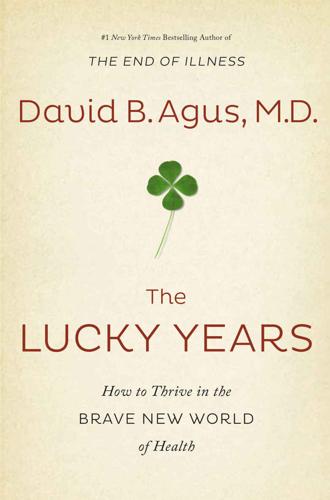
The Lucky Years: How to Thrive in the Brave New World of Health
by
David B. Agus
Published 29 Dec 2015
My guess is that future studies and technologies will be able to tell us that even the most elusive, rare types of cancer that seem to be due to bad luck can actually be influenced by our environment and lifestyle. And knowing that cancer is preventable and can be impacted by behavior is, to me, empowering. Most Medical Studies Are Wrong Regrettably, most medical studies are wrong; they are biased and flawed, each in its own unique way. By some estimates, on average only 3,000 of 50,000 new journal articles published every year are sufficiently well designed and relevant to inform patient care.16 That’s 6 percent. A whopping 94 percent of studies published do not carry significant enough valid data to warrant a change in how doctors treat patients, nor will their findings impact patient outcomes.
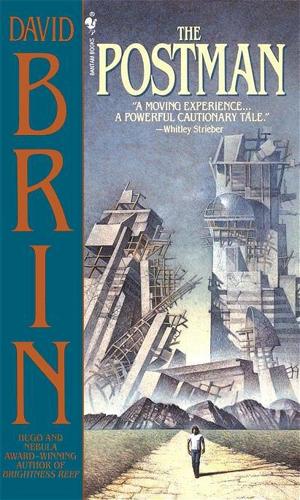
The Postman
by
David Brin
Published 1 Jan 1985
But there didn’t seem to be a single advertisement in the bag, And while there were many private letters, most of the envelopes appeared to be on one or another type of official stationery. Well, there wasn’t time for voyeurism anyway. He’d take a dozen or so letters for entertainment, and use the backsides for his new journal. He avoided thinking about the loss of the old volume— sixteen years’ tiny scratchings, now doubtless being perused by that onetime stockbroker robber. It would be read and preserved, he was sure, along with the tiny volumes of verse he had carried in his pack, or he had misread Roger Sep-tien’s personality.
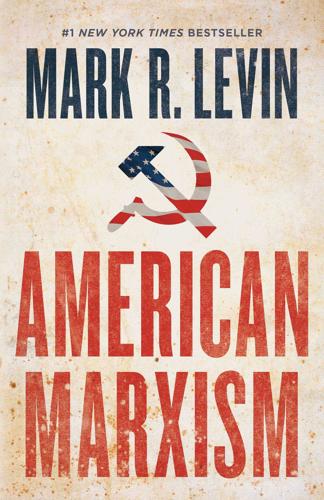
American Marxism
by
Mark R. Levin
Published 12 Jul 2021
Conflict, after all, is the essence of drama, and it is a truism that newspapers deliberately start and prolong quarrels; by allegation, by artful quotation, by the accentuation of unimportant differences, they create antagonism where none was felt to exist before. And this is profitable practically, for the opportunity to dramatize a fight is an opportunity for news. Journalism, on the whole, is glad to see a quarrel start and sorry to see it end. In the more sensational publications this spirit of passion and violence, manifested in a certain recklessness of diction, with vivid verbs and fortissimo adjectives, creeps into the very language. By the attention it gives their misdeeds it makes criminals heroic and politicians large than life….”8 I would go a step further—the press not only starts and prolongs quarrels, but thrives today on the exploitation of issues and agendas that serve the purposes of the various Marxist movements, and in doing so inflames and divides the entire nation along ideological lines.
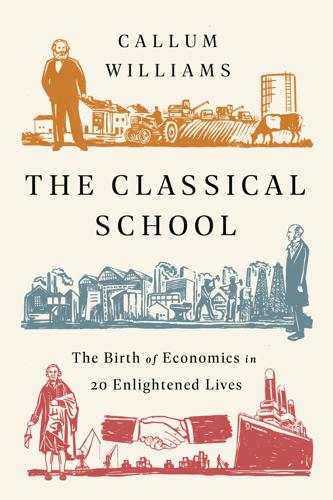
The Classical School
by
Callum Williams
Published 19 May 2020
The French enviously looked over the Channel to England, which seemed to be doing pretty well. England’s navy was gradually assuming global dominance. Its economy was booming. The French establishment thought about how to put its country back on track. As Thomas Neill points out, in the 1760s “a number of new journals were established, and licenced by the government, for the express purpose of carrying articles on economic and financial subjects”. The Gazette du commerce, d’agriculture et des finances was established in 1763, “the prospectus of which announced that it had been given the exclusive privilege of treating economic subjects for thirty years”.
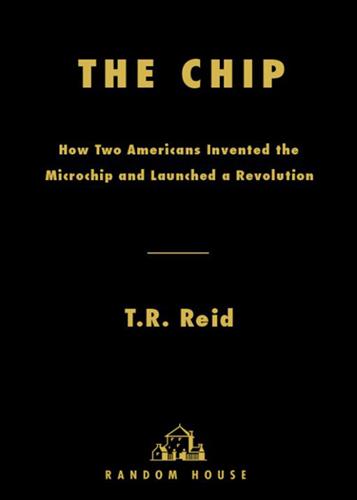
The Chip: How Two Americans Invented the Microchip and Launched a Revolution
by
T. R. Reid
Published 18 Dec 2007
On his deathbed, according to a biographer, William Kneale, Boole requested “that his children not be allowed to fall into the hands of those who were commonly thought religious.” Committed to teaching, Boole opened his own school in Lincolnshire and now found some time for mathematical work. The editor of a new journal was willing to publish Boole’s papers, despite the author’s lack of formal training. One of them caught the eye of the mathematician Augustus De Morgan, who helped Boole obtain a chair at Queen’s College in Ireland. At last Boole had a secure income and the time to work out his grand mathematical synthesis of human thought.
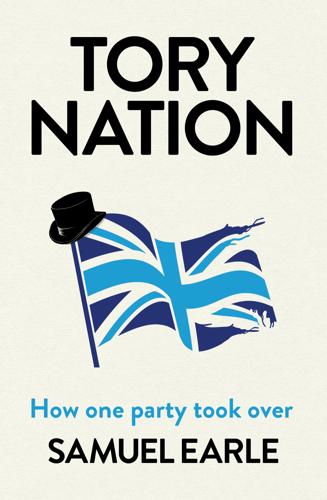
Tory Nation: The Dark Legacy of the World's Most Successful Political Party
by
Samuel Earle
Published 3 May 2023
What they need now is real difference’, Guardian, 15 July 2022. 29 Mark Joseph Pitchford, ‘The Conservative Party and the Extreme Right, 1945–1975’, PhD, Cardiff University, 2009. 30 Boris Johnson, ‘Keep calm, everyone – now is not the time to do a Nicolas Cage’, Daily Telegraph, 28 April 2013. 6 THE TORY PRESS 1 Moore, Margaret Thatcher: The Authorized Biography, vol. 3, p. 3. 2 Matthew Engel, Tickle the Public: One Hundred Years of the Popular Press, Orion, 1997. 3 Steven McKevitt, The Persuasion Industries: The Making of Modern Britain, Oxford University Press, 2018, p. 115. 4 Fawcett, Conservatism: A Fight for a Tradition, p. 83. 5 Engel, Tickle the Public. 6 See for example: Mike Berry, ‘No Alternative to Austerity: How BBC Broadcast News Reported the Deficit Debate’, Media, Culture & Society, 38 (6), 2016; Stephen Cushion, Allaina Kilby, Richard Thomas, Marina Morani & Richard Sambrook, ‘Newspapers, Impartiality and Television News’, Journalism Studies, 19(2), 2018, pp. 162-181; Tom Mills, The BBC: Myth of a Public Service, Verso, 2020. 7 Gary Younge, ‘The Tories can’t win without the press. This isn’t how democracy works’, Guardian, 15 November 2019. 8 This section draws on the excellent history provided in Curran and Seaton, Power Without Responsibility, chapter 1-3. 9 Ibid, p. 21. 10 Alan J.
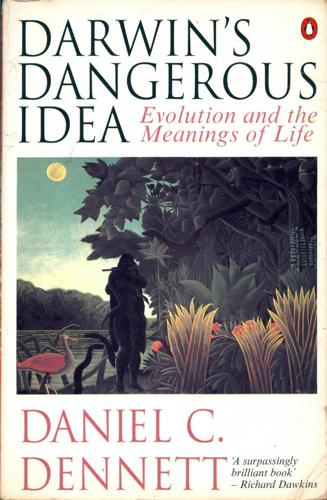
Darwin's Dangerous Idea: Evolution and the Meanings of Life
by
Daniel C. Dennett
Published 15 Jan 1995
The more people looked into the attempt to extend his methods to more complex problems — chess, for instance, to say nothing of real-world, non-toy problems — the more the success of Samuel's Darwinian learner seemed to be attributable to the relative simplicity of checkers rather than to the power of the underlying learning capacity. Was this, then, the end of Darwinian AI? Of course not. It just had to hibernate for a while until computers and computer scientists could advance a few more levels of complexity. Today, the offspring of Samuel's program are multiplying so fast that at least three new journals have been founded in the last year or two to provide a forum: Evolutionary Computation, Artificial Life, and Adaptive Behavior. The first of these emphasizes traditional engineering concerns: using simulated evolution as a method to expand the practical design powers of programmers or software engineers.
…
Explicitly adaptationist approaches are ascendant in the sciences of ecology, ethology, and evolution because they have proven essential to discovery; if you doubt this claim, look at the journals. Gould and Lewontin's call for an alternative paradigm has failed to impress practicing biologists both because adaptationism is successful and well-founded, and because its critics have no alternative research program to offer. Each year sees the establishment of such new journals as Functional Biology and Behavioral Ecology. Sufficient research to fill a first issue of Dialectical Biology has yet to materialize. [Daly 1991, p. 219.] What particularly infuriates Gould and Lewontin, as the passage about the Eskimo face suggests, is the blithe confidence with which adaptationists go about their reverse engineering, always sure that sooner or later they will find the reason why things are as they are, even if it so far eludes them.
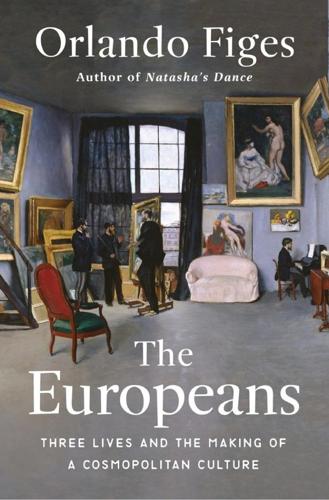
The Europeans: Three Lives and the Making of a Cosmopolitan Culture
by
Orlando Figes
Published 7 Oct 2019
In 1847, Belinsky was involved in the relaunching of The Contemporary (Sovremennik), a journal founded by Pushkin that had gone into decline following his death. With its relaunch it was destined to become the leading literary magazine for the socially progressive, Westernizing circles to which Turgenev comfortably belonged. ‘We have succeeded in founding a new journal here which will appear from the new year under the most favourable auspices,’ Turgenev wrote to Pauline from St Petersburg in November 1846. ‘I will be one of its contributors.’119 When the first number of the magazine appeared, it contained nine poems by Turgenev, a long theatrical review by him, and ‘Khor and Kalinych’, the first of what would go on to become his Sketches from a Hunter’s Album.
…
There was a proliferation of smaller cultural reviews, the petites revues, which as startup businesses depended heavily on translations as a cheap alternative to paying for original writing, although many of these journals were committed to a cosmopolitan agenda in which translations played a vital part. Belgium was a case in point. The number of new literary journals published there rose from under twenty every year in the 1850s to as many as sixty every year during the 1890s. Many of these new journals carried translations between Flemish, French and German, the country’s three main languages, with the aim of promoting what was termed the ‘Belgian spirit’, defined by the journal L’Art moderne as a cultural space for the cross-fertilization of Latin and Germanic sensibilities.105 These reviews became a focus for literary and artistic groups, which linked them to journals with a similar philosophy on the European scene.
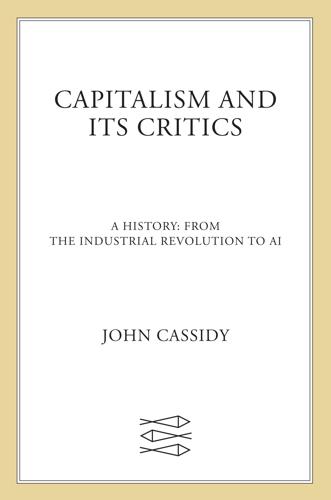
Capitalism and Its Critics: A History: From the Industrial Revolution to AI
by
John Cassidy
Published 12 May 2025
In a piece published on July 4, 1868, under the headline “To What Are We Drifting,” he wrote: “Capital is piled on capital, to the exclusion of men of lesser means, and the utter prostration of personal independence and enterprise on the part of the less successful masses.”21 Later in 1868, George left the Daily Times and started writing again under his own byline. The article that first brought him widespread attention was titled “What the Railroad Will Bring Us.” Appearing in a new journal, The Overland Monthly, it posited that San Francisco was about to become a big and prosperous city like New York, with its own Astors and Vanderbilts but also large numbers of impoverished residents. “The truth is, that the completion of the railroad and the consequent great increase of business and population, will not be a benefit to all of us, but only to a portion,” the piece said.
…
Jogiches was a self-confident and strident figure, but according to Luxemburg’s longtime friend Clara Zetkin, he was also “one of those very masculine personalities—an extremely rare phenomenon these days—who can tolerate a great female personality in loyal and happy comradeship, without feeling her growth and development to be fetters on his own ego.”9 He and Luxemburg would be comrades and lovers for a decade and a half. Jogiches used some family money to launch a Polish-language socialist magazine, Sprawa Robotnicza. Luxemburg wrote for the new journal and eventually edited it. In the Polish exile community, she quickly became a controversial figure, because she rejected the argument that the Polish Socialist Party, which was founded in 1892, should support national self-determination. Given the dependence of Polish industry on the Russian market, independence wasn’t economically viable, she argued.
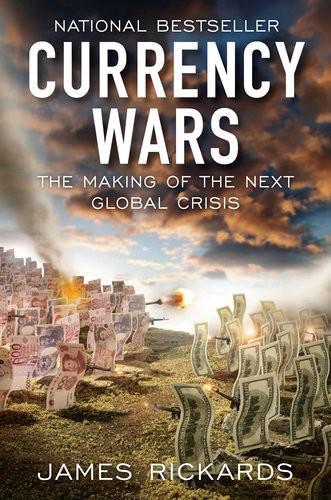
Currency Wars: The Making of the Next Gobal Crisis
by
James Rickards
Published 10 Nov 2011
“Power Laws, Pareto Distributions and Zipf’s Law.” Contemporary Physics 46 (September 2005): 323–51. Nixon, Richard M. “Address to the Nation Outlining a New Economic Policy: ‘The Challenge of Peace,’” August 15, 1971. Pastore, S., L. Ponta and S. Cincotti. “Heterogeneous Information-Based Artificial Stock Market.” New Journal of Physics 12 (2010). Plosser, Charles I. “Exit: Shadow Open Market Committee.” Speech Given in New York, March 25, 2011. ———. “The Scope and Responsibility of Monetary Policy.” Report prepared for GIC 2011 Global Conference Series: Monetary Policy and Central Banking in the Post-Crisis Environment, January 17, 2011.
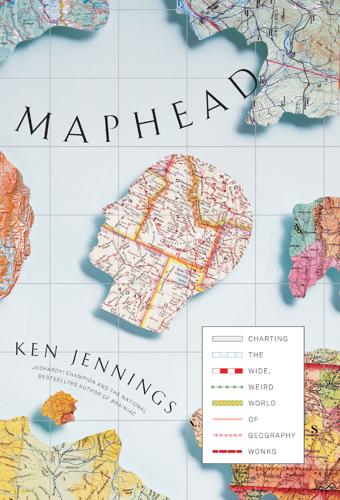
Maphead: Charting the Wide, Weird World of Geography Wonks
by
Ken Jennings
Published 19 Sep 2011
Now that the president of the United States is himself a TCK, the term seems a little less exotic. 31 “To be rooted”: Simone Weil, The Need for Roots: Prelude to a Declaration of Duties Toward Mankind (Boston: Beacon Press, 1955), p. 42. CHAPTER 3: FAULT 32 “To the people of Bolivia!”: Steve Neal, “A Casual Approach Amid Controversy,” Chicago Tribune, Jan. 9, 1983. 32 David Helgren sprang: The best account of Helgren’s fateful brush with fame is the article he himself wrote on the subject: “Place Name Ignorance Is National News,” Journal of Geography 82 (July–August 1983), pp. 176–178. 35 kidnapped a young woman: This was the notorious Gary Steven Krist case. His victim, Barbara Jane Mackle, lived to retell the story in her book 83 Hours till Dawn (New York: Doubleday, 1971). 36 Nouvelle Géographie: Quoted in “Old Maps and New,” Blackwood’s Edinburgh Magazine 94, no. 577 (November 1863), pp. 540–553. 37 Henry Kissinger told: In Years of Renewal (New York: Touchstone, 1999), p. 72, quoted in de Blij, Why Geography Matters, p. 13. 37 “Over the last”: www.snopes.com/politics/obama/57states.asp. 37 “the importance of”: Lourdes Heredia, “Spain Puzzled by McCain Comments,” BBC News, Sept. 18, 2008. 37 Africa was a country: Frank Rich, “The Moose Stops Here,” The New York Times, Nov. 16, 2008. 38 Al Franken’s favorite: A YouTube search for “al franken map” will return at least three such clips, spanning over twenty years. 38 “I personally believe”: Rebecca Traister, “Miss Dumb Blond USA?

Einstein's Dice and Schrödinger's Cat: How Two Great Minds Battled Quantum Randomness to Create a Unified Theory of Physics
by
Paul Halpern
Published 13 Apr 2015
However, it also applied to the reporting of his own unified field theory attempts, which in many cases were treated as breakthroughs rather than just works in progress. For example, during the media hullabaloo over his 1929 theory of distant parallelism, instead of quashing speculations he added to them with his own public statements about its importance. After Einstein’s critical response was published in venues such as Pathfinder, a Washington-based news journal, as well as in the Irish Press, Schrödinger issued his own press statement, framing the matter as an issue of academic freedom: “Surely Professor Einstein is the last to dispute an academician’s right of reporting to his Academy and giving his opinion freely.”32 As Anny recalled, there was even talk of lawsuits, with each thinking of charging the other with plagiarism.
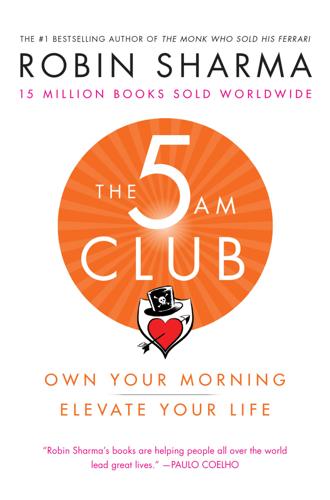
The 5 AM Club: Own Your Morning. Elevate Your Life.
by
Robin Sharma
Published 4 Dec 2018
It had been three weeks since the visit to Rome. In that time, the entrepreneur had been doing wind sprints for twenty minutes at 5 AM each morning along with some serious weight training. After that at, 5:20 AM, she’d use the tranquility of the second pocket to contemplate quietly, write lists of the things she was grateful for in her new journal and then meditate. Finally, at 5:40 AM, she’d listen to an audiobook about a business maverick or read something on the subjects of productivity, teamwork and leadership. She’d also, and this was a hard one, broken the addiction to technology that had been her lifeline—as well as her escape from producing her greatest work.
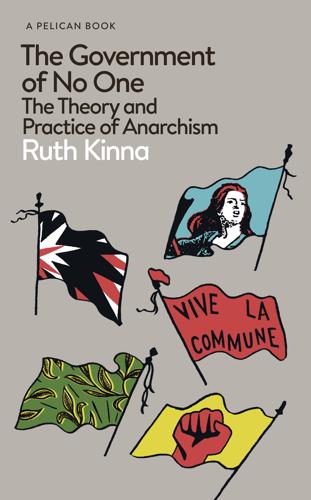
The Government of No One: The Theory and Practice of Anarchism
by
Ruth Kinna
Published 31 Jul 2019
Ward was called to give evidence at the trial of the paper’s editors – John Hewetson, Vernon Richards and Philip Sansom – for conspiracy. He testified that their subversive writing had made no impact on him. He became involved in the post-war squatters movement and editor of Freedom in 1947. In 1961 he took up the editorship of the new journal Anarchy and in 1973 he published Anarchy in Action. This was one of nearly thirty books he wrote on topics ranging from allotments, utopias, education and social policy to town planning and childhood development.12 JOHN ZERZAN (B. 1943) Raised in Salem, Oregon, Zerzan studied political science at Stanford University, history at San Francisco State University and completed his postgraduate degree at the University of Southern California.
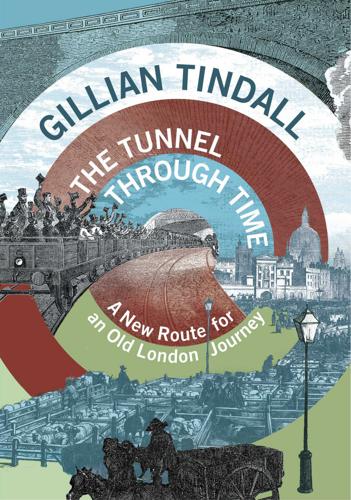
The Tunnel Through Time: A New Route for an Old London Journey
by
Gillian Tindall
Published 14 Sep 2016
Douglas, The Vanished Coaching Inns of the City of London, 2009 Articles, academic papers; manuscript sources in addition to those mentioned in the Acknowledgements Anon., ‘Domesday Book’, actually ‘Liber Domus Dei’, manuscript register compiled in 1624 of those who contributed to the rebuilding of St Giles-in-the-Fields: for several centuries in the possession of the parish but recently lodged in the London Metropolitan Archives Anthony, Sian, ‘Medieval Settlement to 18th–19th-Century Rookery: Excavations at Central St Giles 2006–8’, MOLA Study Series no. 23, 2011 Bird, Samantha L., Stepney: Profile of a London Borough from the Outbreak of the First World War to the Festival of Britain 1914–1951, Cambridge thesis, 2011 Boreman, Robert, A Mirrour of Christianity, and a miracle of charity . . . etc., pamphlet printed 1669 on the death of Alice, Duchess Dudley, a copy in the possession of Camden Local Archives Carrier, Dan, ‘Lauderdale House and Magna Carta’, Camden New Journal, 9 April 2015 Dennis, Richard, ‘Gower Street to Euston Square: A Local History of the Underground’, annotated version of a UCL lunchtime lecture given 15 January 2013 Dennis, Richard, ‘Letting off Steam: The Perils and Possibilities of Underground Travel in Victorian and Edwardian London’, paper delivered at the Institute of Historical Research, UCL, 17 January 2013 Gage, John, ‘The Rise and Fall of the St Giles Rookery’, article published in Camden History Review, vol. 12, 1984 Gliddon, Marchant Alexander, History of Stepney 1819–1869, manuscript in possession of Tower Hamlets Archive Library Green, David, People of the Rookery: A Pauper Community in Victorian London, occasional paper from the Department of Geography, King’s College London, 1986 Hebbert, Michael, ‘Megaproject as Keyhole Surgery: London Crossrail’, from Built Environment, vol. 37, No. 1, 2012 Hill, G.

Enlightenment Now: The Case for Reason, Science, Humanism, and Progress
by
Steven Pinker
Published 13 Feb 2018
Americans’ acceptance of gay relations crosses 50% threshold. http://www.gallup.com/poll/135764/Americans-Acceptance-Gay-Relations-Crosses-Threshold.aspx. Gallup. 2016. Death penalty. http://www.gallup.com/poll/1606/death-penalty.aspx. Galor, O., & Moav, O. 2007. The neolithic origins of contemporary variations in life expectancy. http://dx.doi.org/10.2139/ssrn.1012650. Galtung, J., & Ruge, M. H. 1965. The structure of foreign news. Journal of Peace Research, 2, 64–91. Gardner, D. 2008. Risk: The science and politics of fear. London: Virgin Books. Gardner, D. 2010. Future babble: Why expert predictions fail—and why we believe them anyway. New York: Dutton. Garrard, G. 2006. Counter-enlightenments: From the eighteenth century to the present.
…
Women in the labor force. https://www.dol.gov/wb/stats/facts_over_time.htm. United States Environmental Protection Agency. 2016. Air quality—national summary. https://www.epa.gov/air-trends/air-quality-national-summary. Unz, D., Schwab, F., & Winterhoff-Spurk, P. 2008. TV news—the daily horror? Emotional effects of violent television news. Journal of Media Psychology, 20, 141–55. Uppsala Conflict Data Program. 2017. UCDP datasets. http://www.pcr.uu.se/research/ucdp/datasets/. van Bavel, B., & Rijpma, A. 2016. How important were formalized charity and social spending before the rise of the welfare state? A long-run analysis of selected Western European cases, 1400–1850.
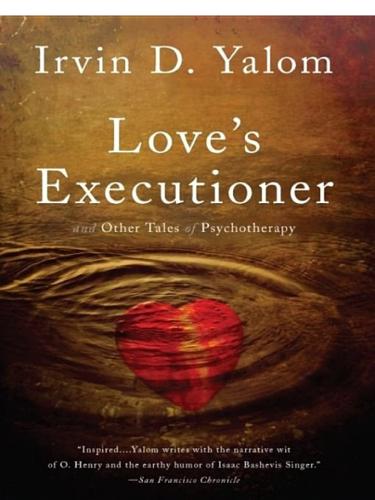
Love's Executioner
by
Irvin D. Yalom
Published 1 Jan 1989
So it was clear that I must not underestimate the gravity of the situation: Saul was in extremis, and I must offer some immediate help. His overwrought reaction was, I thought, totally irrational. God knows what was in those letters—probably some irrelevant announcement, a scientific meeting or a new journal. But I was certain of one thing: those letters, despite their timing, were not letters of censure from either Dr. K. or the Stockholm Institute; and, without doubt, as soon as he read them, his distress would evaporate. Before proceeding, I considered alternatives: Was I being too hasty, too active?
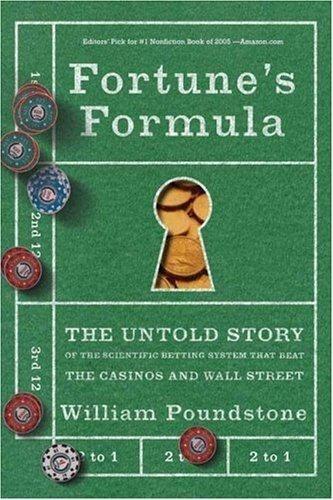
Fortune's Formula: The Untold Story of the Scientific Betting System That Beat the Casinos and Wall Street
by
William Poundstone
Published 18 Sep 2006
The Black-Scholes formula, as it was quickly christened, was published in 1973. That name deprived both Merton and Thorp of credit. In Merton’s case, it was a matter of courtesy. Because he had built on Black and Scholes’s work, he delayed publishing his derivation until their article appeared. Merton published his paper in a new journal that was being started by AT&T, the Bell Journal of Economics and Management Science. This journal was an acknowledgment of how profoundly quantitative methods from information theory and physical science were transforming formerly alien fields like finance. Thorp considers the Merton paper “a masterpiece.”
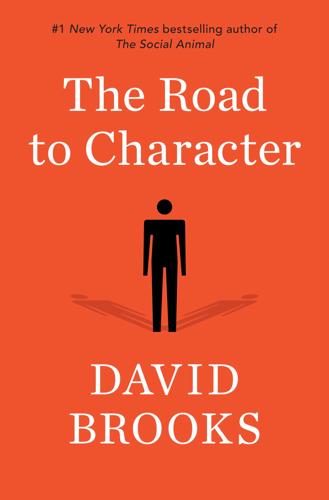
The Road to Character
by
David Brooks
Published 13 Apr 2015
He famously had six-inch shag carpets in his bachelor pad, and he popularized the use of the word “foxes” for women. He wrote an autobiography titled I Can’t Wait Until Tomorrow ’Cause I Get Better Looking Every Day. This is not a title Johnny Unitas would have chosen. Namath came to stardom at a time when New Journalism was breaking the mold of the old reporting. Namath was the perfect subject. Without a reticent bone in his body, he’d bring reporters along as he worked his way through bottles of scotch the night before games. He openly bragged about what a great athlete he was, how good-looking he was. He cultivated a brashly honest style.
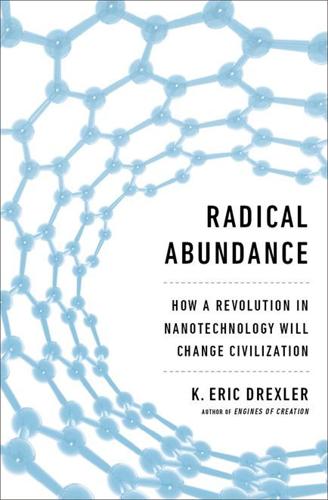
Radical Abundance: How a Revolution in Nanotechnology Will Change Civilization
by
K. Eric Drexler
Published 6 May 2013
Genetic engineering and molecular biology pioneered new fields of science and technology, but they could also be seen as opening the door to manufacturing in a new environment and on a scale that could be important for the future of humanity. I followed this field with particular attention, and by 1976 my thoughts were drawn to the question of where it might lead. (Libraries were the cause once again. As an information omnivore, I’d been casting a net into the flow of knowledge that crossed the new-journals shelves of the MIT Science Library.) The following spring, after toying with ideas about computing with molecular devices, I found myself asking several crucial questions—not just “What could be built by programming nature’s machines?” but a question a step beyond: “What could be built using the machines that nature’s own machines could be programmed to build?”
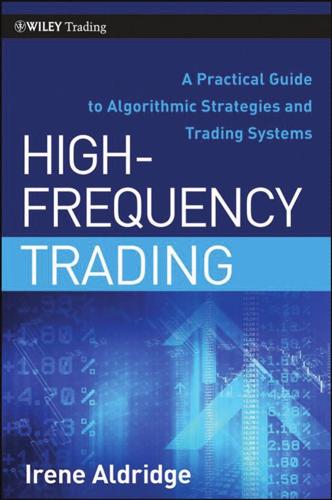
High-Frequency Trading: A Practical Guide to Algorithmic Strategies and Trading Systems
by
Irene Aldridge
Published 1 Dec 2009
“Liquidity Risk and Expected Stock Returns.” Journal of Political Economy 111, 642–685. Pearce, Douglas K. and V. Vance Roley, 1983. “The Reaction of Stock Prices to Unanticipated Changes in Money: A Note.” Journal of Finance 38, 1323–1333. Pearce, D.K. and V. Vance Roley, 1985. “Stock Prices and Economic News.” Journal of Business 58, 49–67. Perold, A.F., 1988. “The Implementation Shortfall: Paper Versus Reality.” Journal of Portfolio Management 14 (Spring), 4–9. Perold, A. and W. Sharpe, 1988. “Dynamic Strategies for Asset Allocation.” Financial Analysts Journal 51, 16–27. Perraudin, W. and P. Vitale, 1996.
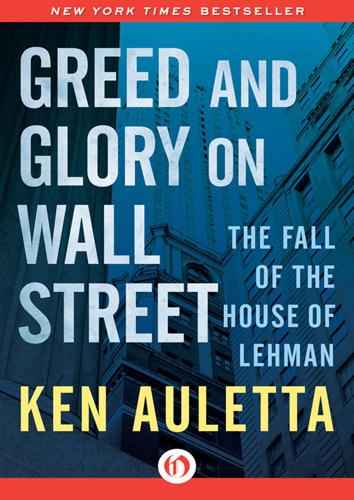
Greed and Glory on Wall Street: The Fall of the House of Lehman
by
Ken Auletta
Published 28 Sep 2015
I also thank Peter Cohen and the executives at Shearson/American Express for cooperating and encouraging others to make themselves available. A word about my method: I have tried to put the pieces of the Lehman puzzle together without resorting to journalistic shortcuts and the air of omniscience that infects much of the new journalism. At the risk of “slowing the narrative”—a phrase too freely uttered by editors eager to blur the line between fiction and nonfiction—I have used only the words actually given to me directly in interviews and have tried to attribute these words and thoughts to people. I have invented no dialogue.
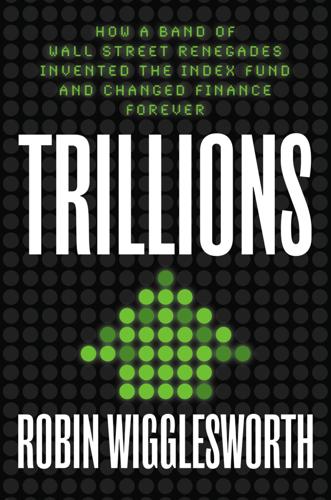
Trillions: How a Band of Wall Street Renegades Invented the Index Fund and Changed Finance Forever
by
Robin Wigglesworth
Published 11 Oct 2021
He had to detail and measure the performance of 7,500 separate recommendations by the financial services, for a total of 75,000 entries, four years of transaction data by the insurance companies, 255 Wall Street Journal editorials, and 3,300 recommendations by the investment publications. The result was a 1933 article in Econometrica—a new journal dedicated to mathematical economics funded by Cowles himself—titled “Can Stock Market Forecasters Forecast?” Cowles summed up the results of his study in a terse, brutal three-word abstract: “It is doubtful.”11 Cowles’s calculations indicated that only a minority of prognosticators actually managed to do better than the stock market as a whole, and blind luck might explain those.

Reset
by
Ronald J. Deibert
Published 14 Aug 2020
University of Chicago Public Law & Legal Theory Working Paper No. 181, 683–768. Retrieved from https://chicagounbound.uchicago.edu/cgi/viewcontent.cgi?article=1036&context=public_law_and_legal_theory; Pennycook, G., Cannon, T. D., & Rand, D. G. (2018). Prior exposure increases perceived accuracy of fake news. Journal of Experimental Psychology: General, 147(12), 1865. http://dx.doi.org/10.1037/xge0000465 Many people still receive the vast majority of their information from traditional news: Nyhan, B. (2016, September 7). Relatively few Americans live in partisan media bubble, but they’re influential. Retrieved from https://www.nytimes.com/2016/09/08/upshot/relatively-few-people-are-partisan-news-consumers-but-theyre-influential.html News organizations increasingly analyze the popularity of their stories over social media: Ferrucci, P. (2018).
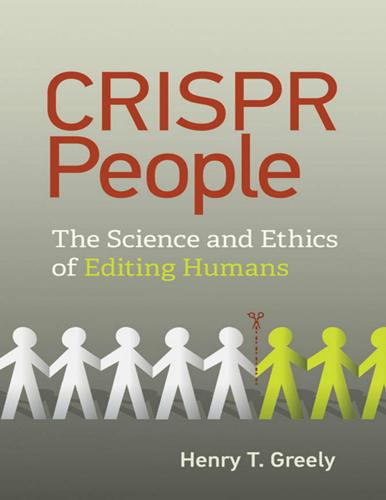
CRISPR People: The Science and Ethics of Editing Humans
by
Henry T. Greely
Published 22 Jan 2021
But the scheme had unraveled: “This was everything not to plan.”11 Ferrell and He had been surprised by Regalado’s story; Ferrell said he had not known that He had, 18 days earlier, posted the project description in ChiCTR. After Regalado’s story came out, Ferrell says that He gave the AP permission to post their story, and Ferrell and He posted the five (unfinished) videos. One more piece from outside Hong Kong needs to be added. Sometime on Monday, November 26, The CRISPR Journal, a relatively new journal published by Mary Ann Liebert, Inc., put out an article, with He as lead author, entitled “Draft Ethical Principles for Therapeutic Assisted Reproductive Technologies.”12 The Journal has told me that the He paper was received on November 5. They sent it out for expedited peer review in the hope of publishing it before the Hong Kong Summit but knew nothing of He’s efforts to make babies until the story broke in the press.
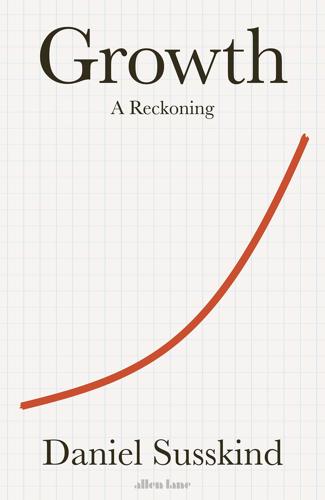
Growth: A Reckoning
by
Daniel Susskind
Published 16 Apr 2024
See Solow, ‘A Contribution’, p. 65. 28 ‘The Growth of Growth Theory’, The Economist, 18 May 2006. 29 The consequences were different, too: in Malthus, more people drove per capita GDP towards subsistence; in Solow, more capital drives per capita GDP up to an eventual plateau. 30 See Moses Abramovitz, ‘The Search for the Sources of Growth: Areas of Ignorance, Old and New’, Journal of Economic History, 53:2 (1993), 217–43. 31 Solow-Swan did not convince everyone. To begin with, some were sceptical of Solow’s leap from uncovering a missing factor driving economic growth to concluding the factor must indeed be ‘technological progress’: this residual should not be thought of as a measure of technological advance, argued Moses Abramovitz, but as a ‘measure of [our] ignorance’ – where technology is only one possible explanation.
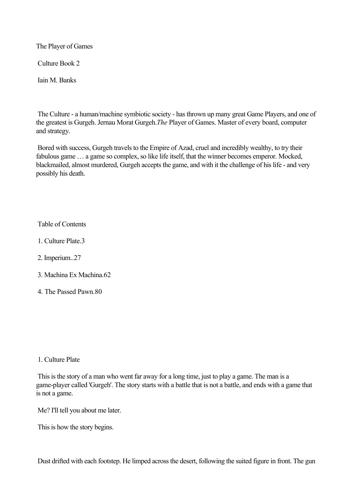
The Player of Games
by
Iain M. Banks
Published 14 Jan 2011
Gurgeh watched on the lounge screen, and even recognised a few people he'd known, flying past in an aircraft, shouting goodbye. Officially, he was going on a solo cruising holiday before travelling to the Pardethillisian Games. He had already dropped hints he might forgo the tournament. Some of the theoretical and news journals had been interested enough in his sudden departure from Chiark - and the equally abrupt cessation of his publications - to have representatives on theLittle Rascal interview him. In a strategy he'd already agreed with Contact, he'd given the impression he was growing bored with games in general, and that the journey - and his entry in the great tournament - were attempts to restore his flagging interest.

The Undoing Project: A Friendship That Changed Our Minds
by
Michael Lewis
Published 6 Dec 2016
When others spoke of their joint work, they put Danny’s name second, if they mentioned it at all: Tversky and Kahneman. “You are very generous in giving me credit for articulating the relationship between representativeness and psychoanalysis,” Amos wrote to a fellow psychologist who had sent Amos his new journal article. “These ideas, however, were developed in discussions with Danny so you should mention both our names or (if that appears awkward) omit mine.” An author of a book credited Amos with noticing the illusory sense of effectiveness felt by Israeli Air Force flight instructors after they’d criticized a pilot.
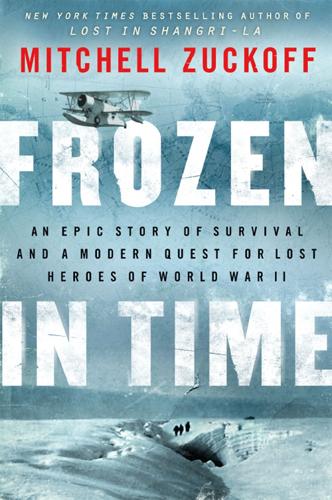
Frozen in Time
by
Mitchell Zuckoff
Published 4 Mar 2013
Press, n.d. 326 “How can I tell them what’s in my heart”: Ibid. 327 “the circulation still isn’t back to normal”: Lloyd Puryear to Alexander Tucciarone, April 2, 1943, provided by Peter Tucciarone. 328 “ill with a lung ailment”: Pearl Puryear to Angelina Tucciarone, December 15, 1943, provided by Peter Tucciarone. 328 “one of its favorite and most beloved native sons”: Lloyd Puryear obituary, News-Journal, January 13, 1944. 328 “under rigorous Arctic conditions”: Distinguished Flying Cross citation for Lieutenant Bernard W. Dunlop, May 8, 1943. 328 served as a lawyer: Nancy Dunlop, daughter of Bernard Dunlop, interview, March 23, 2012. 328 promoted to major in July 1944: “Military Promotions,” Salt Lake Tribune, July 25, 1944. 329 went to officer candidate school in Miami: “Glacier Hero Gets Officer’s Bars,” San Antonio Light, September 1, 1943. 329 “Bernt Balchen Saves 7 on Ice Cap”: Chicago Tribune, May 4, 1943. 329 “Flier of the Snows”: “Flier of the Snows,” unsigned editorial, New York Times, May 5, 1943. 329 secret orders to wipe out a German weather station: Balchen, Come North with Me, pp. 246–47; Matz, History of the 2nd Ferrying Group, p. 145. 330 flown over the North Pole: Balchen, Come North with Me, p. 66.
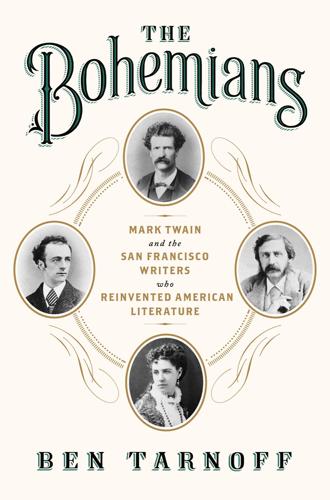
The Bohemians: Mark Twain and the San Francisco Writers Who Reinvented American Literature
by
Ben Tarnoff
Published 20 Mar 2014
For more of the buzz in the Era about a new paper, see Bret Harte, “About the Inigo Boy,” Golden Era, November 15, 1863, and Charles Henry Webb, “Things,” Golden Era, November 29, 1863. They shared a single All quotes: Bret Harte, “Things,” Golden Era, November 8, 1863. For more on the shift in San Francisco’s literary climate, see SFLF, pp. 177–184. In early 1864 The first issue of the new journal, the Californian, appeared on May 28, 1864, and advertised itself as not only the “Best Journal on the Pacific Coast” but also the “Equal of Any on This Continent!” It also listed its offices at 728 Montgomery Street. This is the Genella Building, built in the early 1850s by the merchant Joseph Genella on the site of the first meeting of Freemasons in California.
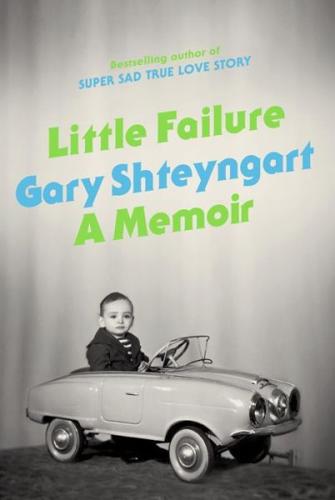
Little Failure: A Memoir
by
Gary Shteyngart
Published 7 Jan 2014
He is the author of the novels Super Sad True Love Story (2010), Absurdistan (2006), and The Russian Debutante’s Handbook (2002), and the memoir Little Failure. Super Sad True Love Story won the Bollinger Everyman Wodehouse Prize and was selected as one of the best books of the year by more than forty news journals and magazines around the world. Absurdistan was chosen as one of the ten best books of the year by The New York Times Book Review and Time magazine. The Russian Debutante’s Handbook won the Stephen Crane Award for First Fiction and the National Jewish Book Award for Fiction. His fiction and essays have appeared in The New Yorker, Granta, Esquire, GQ, Travel + Leisure, The New York Times Magazine, and many other publications.
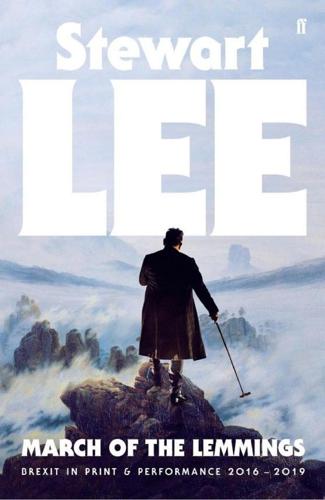
March of the Lemmings: Brexit in Print and Performance 2016–2019
by
Stewart Lee
Published 2 Sep 2019
He gets bonus points for his ability to enrage the hysterical PC brigade. MarkB35 It is possible to agree with every word of Stewart Lee’s takedown of Toby Young and yet wish it hadn’t been printed. I’ve started to think that all this normalized abuse just leads to everyone thinking that abuse is the new journalism. I wasn’t a fan of the ‘jam-rag’ quip (nothing to do with Young, and normalizes misogyny). Or the nudge-wink-iness of the ‘homosexual-dressed-as-a-lesbian’ bit. Or of the fact that it tells us nothing we didn’t already know, in a style already overused by Young himself. I’d like to see something elegant and excoriating for a change, instead of just reading a series of journalists calling each other cunts.
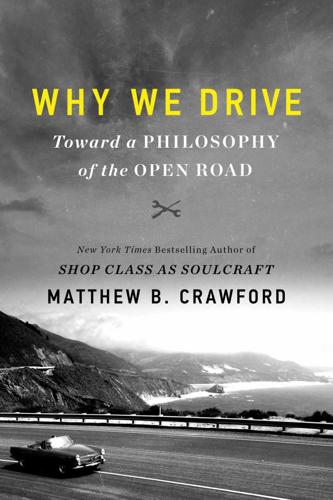
Why We Drive: Toward a Philosophy of the Open Road
by
Matthew B. Crawford
Published 8 Jun 2020
Then as now, that heady sense of winning at a generational culture war—the inevitability of it—is taken to license a certain kind of journalism by those who share it, the point of which is to advance the forward-moving narrative more than it is to capture social reality. Thompson is often lumped together with Tom Wolfe, both pioneers of a New Journalism. Wolfe too had a central concern—not cultural revolt, but the play of status in its many forms, particularly among men. But in this there was no sense of something new in the world, something needing to be ushered in, or to gather partisans around itself. And that probably helps to explain why in reading Wolfe you feel you are learning something about the world as it is.
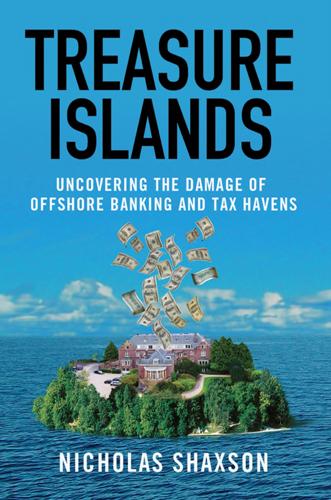
Treasure Islands: Uncovering the Damage of Offshore Banking and Tax Havens
by
Nicholas Shaxson
Published 11 Apr 2011
Frank [Biondi] and Chuck Welch got into a helicopter in Wilmington and went to see him and said, ‘Bill, we want you to know what we’re working on. We’re here to ask you to keep your mouth shut and not make it an issue in the campaign.’ Bill Gordy, God bless him, said yes.” The entire Democrat establishment in Delaware seems to have bought into the silence. And not just them. “If you go back and read the News Journal,” said Hayward, “you will not find one mention of it in the press in the campaign season.”5 This proposal was circulating among Delaware’s entire top business and political elite, including a couple of “populist” legislators who saw this—usury—as a threat to the basic consumer. “We had all these major bankers in Delaware through the whole summer,” said Glenn Kenton, another key player, reeling off names like Citicorp’s CEO Walter Wriston and Chase’s president Tom LaBreque.
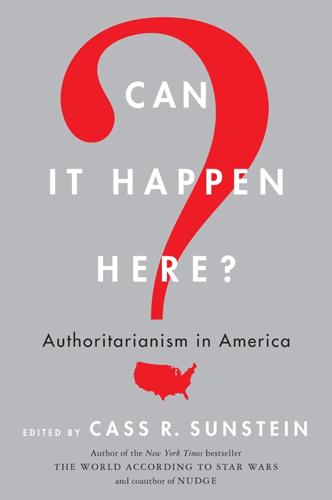
Can It Happen Here?: Authoritarianism in America
by
Cass R. Sunstein
Published 6 Mar 2018
The Effects of Three Types of Media Bias,” The International Journal of Press/Politics 22, no. 1, (2017): 111–32; and Spiro Kiousis, “Compelling Arguments and Attitude Strength: Exploring the Impact of Second-Level Agenda Setting on Public Opinion of Presidential Candidate Images,” The International Journal of Press/Politics 10, no. 2 (2005): 3–27. Such impacts continue to be documented in today’s fragmented media environment. See Ki Deuk Hyun and Soo Jung Moon, “Agenda Setting in the Partisan TV News Context: Attribute Agenda Setting and Polarized Evaluation of Presidential Candidates Among Viewers of NBC, CNN, and Fox News,” Journalism & Mass Communication Quarterly 93, no. 3 (2016): 509–29. 20. Bence Kollanyi, Philip Howard, and Samuel Woolley, “Bots and Automation over Twitter during the U.S. Election,” Computational Propaganda Research Project Working Paper, University of Oxford, November 2016, 4, http://comprop.oii.ox.ac.uk/wp-content/uploads/sites/89/2016/11/Data-Memo-US-Election.pdf. 21.
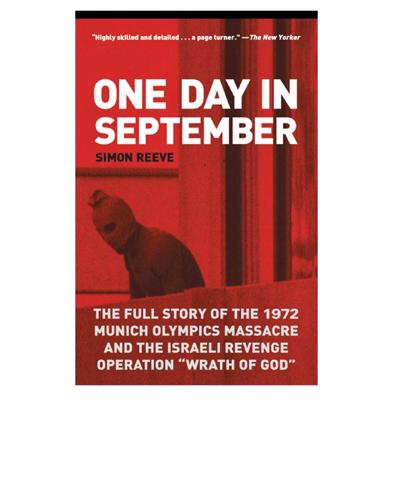
One Day in September
by
Simon Reeve
—Jewish Book World “A gripping, often moving, account of the bloodiest sports day on record.” —Jewish Chronicle “Simon Reeve captures the essence of the slaughter. … One Day in September is the inside story told by those who were present … .The book is easy to read, even with obscure political and religious references.” —Daytona Beach News-Journal “A splendid, disturbing and gripping account of these events and the world’s reactions … Stands among the best of its kind.” —Publishers Weekly (starred review) “A comprehensive and unsettling account … Reeve’s book is an important one since it deals with many issues—terrorism, anti-Semitism and other forms of racism, and Middle East unrest.”
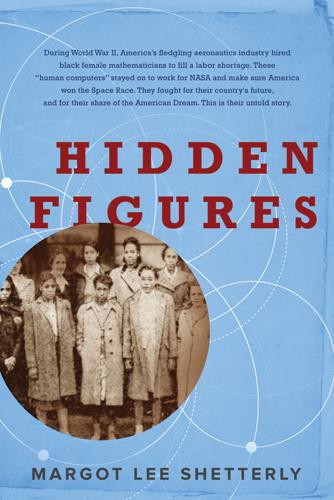
Hidden Figures
by
Margot Lee Shetterly
Published 11 Aug 2016
Sloan Foundation Fellow and the recipient of a Virginia Foundation for the Humanities grant for her research into the history of women in computing. She lives in Charlottesville, Virginia. Discover great authors, exclusive offers, and more at hc.com. CREDITS Cover design by Elsie Lyons Cover photograph used with permission of the New Journal and Guide Background illustrations © Shutterstock Author photograph by Aran Shetterly COPYRIGHT HIDDEN FIGURES. Copyright © 2016 by Margot Lee Shetterly. All rights reserved under International and Pan-American Copyright Conventions. By payment of the required fees, you have been granted the nonexclusive, nontransferable right to access and read the text of this e-book on-screen.
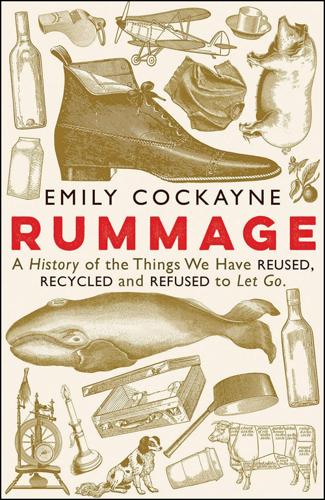
Rummage: A History of the Things We Have Reused, Recycled and Refused To Let Go
by
Emily Cockayne
Published 15 Aug 2020
A correspondent with the pseudonym ‘Substitute’ failed to identify a need for a ‘special organ’, especially one pumped with irrelevant and grating content.34 Having received a copy ‘unasked for’, one surveyor queried the purpose of a journal sold for a shilling, issued by a club ‘with the existence of which I was hitherto unacquainted’. ‘How is it possible’, he asked, for ‘amateurs to start a new journal which obviously does not appeal to the public’, and which was produced under ‘mysterious’ financial conditions. There was, he concluded, nothing useful in it, and pages of precious paper had been wasted with ‘portraits of sundry officials and articles on trite and well-known topics’.35 The resource management experts felt displaced by amateurs, just as their professional skill and experience were most sorely needed.
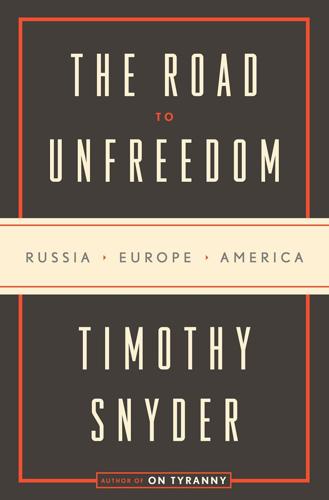
The Road to Unfreedom: Russia, Europe, America
by
Timothy Snyder
Published 2 Apr 2018
It knows much about us, but interacts with us without revealing that this is so. It makes us unfree by arousing our worst tribal impulses and placing them at the service of unseen others. Neither Russia nor the internet is going away. It would help the cause of democracy if citizens knew more about Russian policy, and if the concepts of “news,” “journalism,” and “reporting” could be preserved on the internet. In the end, though, freedom depends upon citizens who are able to make a distinction between what is true and what they want to hear. Authoritarianism arrives not because people say that they want it, but because they lose the ability to distinguish between facts and desires
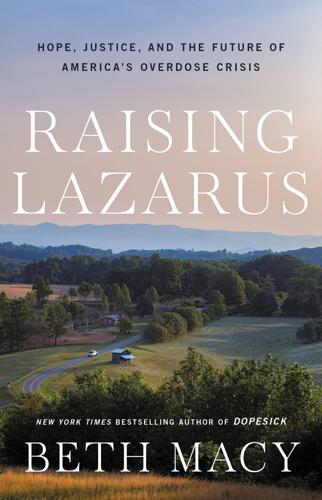
Raising Lazarus: Hope, Justice, and the Future of America’s Overdose Crisis
by
Beth Macy
Published 15 Aug 2022
The real crisis wasn’t the overdose crisis but the one underlying it and all the other crises in the developed world: It was greed, on an order of magnitude that allows corporations and bought-off politicians and families like the Sacklers to turn Americans against ourselves. To persuade us that the “junkies” and Black people and hillbillies and immigrants are why we can’t have nice things. In White Plains, Purdue’s bankruptcy lumbered toward closure while explosive and exhaustive new journalism about Purdue, including an HBO documentary called Crime of the Century, did little to penetrate the Sacklers’ protective coating. For the third time in as many years, comedian John Oliver delivered a scorcher of a show on the Sacklers, this one focused on how the family was using judge shopping and a bankruptcy loophole to nab another get-out-of-jail-free card.
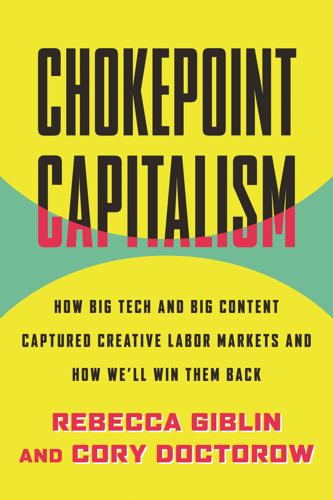
Chokepoint Capitalism
by
Rebecca Giblin
and
Cory Doctorow
Published 26 Sep 2022
We also need to fill gaps caused by the current system, which under-resources important activities that won’t generate enough profit in the market: caring for children and the elderly, repairing crumbling infrastructure, transitioning from our suicidal reliance on fossil fuels, developing communities, building and running libraries and museums, providing quality news journalism, making art, and any number of other activities that support the public good. There are people who need work and work that needs doing, and a job guarantee would unite the two where the market fails to do so. Providing nonmarket jobs is particularly important for art. Excessively powerful corporations are a huge part of why creators struggle to get paid, but not the only challenge.
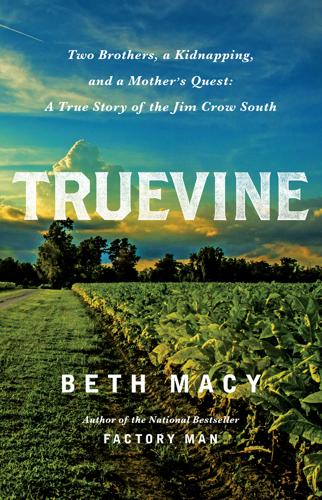
Truevine: Two Brothers, a Kidnapping, and a Mother's Quest: A True Story of the Jim Crow South
by
Beth Macy
Published 17 Oct 2016
triply cursed: Clark Hoyt, “Consistent, Sensitive and Weird,” New York Times, April 18, 2009. Chapter Thirteen. Practically Imbeciles Interviews: Warren Raymond, Bob Blackmar, Ward Hall, Tom Word, Paul Lombardo, Robert M. Brown, Dan Webb, Sarah Showalter make whiskey, steal, or starve: Thomas S. Word Jr., “The Whiskey Business (A Book Review),” Virginia Bar Association News Journal, Summer 2009. Illegal whiskey sold in Roanoke region: Raymond Barnes, A History of the City of Roanoke (Radford, VA: Commonwealth Press, 1968), 753, and “The History and Culture of Untaxed Liquor in the Mountains of Virginia,” Blue Ridge Institute, http://www.blueridgeinstitute.org/moonshine/the_franklin_county_conspiracy.html.
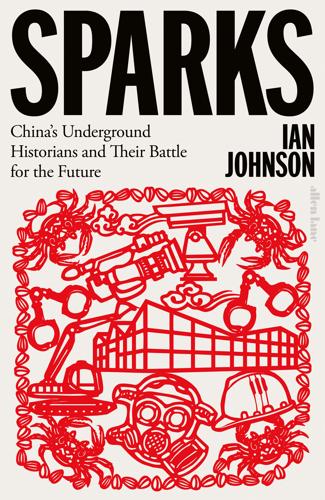
Sparks: China's Underground Historians and Their Battle for the Future
by
Ian Johnson
Published 26 Sep 2023
But you ought to know, Prometheus, for the mortals, we do not want to leave even a spark. Fire is for the gods, for incense and sacrifice, how can the plebeians have it for heating or lighting in the dark? Zhang convinced Lin to let them publish the poem and decided to put it in the first issue of their new journal. Students from Beijing also passed him materials about how Yugoslavian Communists were trying a hybrid form of socialism that allowed for capitalist-style incentives (something the Communist Party would formally embrace twenty years later). Zhang decided to add that material, too, to the inaugural issue, as well as essays by himself and others in the group.

Tripping on Utopia: Margaret Mead, the Cold War, and the Troubled Birth of Psychedelic Science
by
Benjamin Breen
Published 16 Jan 2024
Secure in the Big Sur campground he now owned, he dedicated himself to baking whole wheat bread, maintaining his vacation cabins, and writing playful essays about sexuality, consciousness, and the harms of psychiatric care. He no longer saw himself as a mental health professional with a Stanford affiliation. Instead, he was part of the psychedelic counterculture. As a contributing editor of a new journal, the Psychedelic Review, Adams shared duties with fellow editors Timothy Leary, Richard Alpert, and Alan Watts. He was also a core member of the Esalen Institute community, leading seminars and mingling with the institute’s newly fashionable clientele. And, as happened to be the case on this night, hosting Allen Ginsberg and his lover, Peter Orlovsky, for a cup of tea.
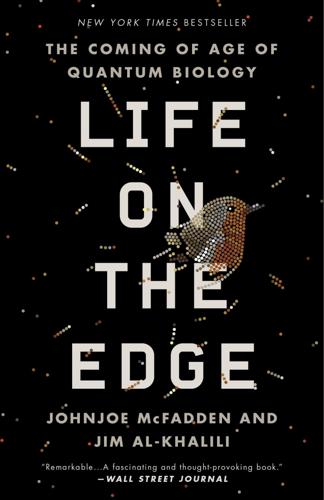
Life on the Edge: The Coming of Age of Quantum Biology
by
Johnjoe McFadden
and
Jim Al-Khalili
Published 14 Oct 2014
Patel, “Quantum algorithms and the genetic code,” Pramana Journal of Physics, vol. 56 (2001), pp. 367–81; available at http://arxiv.org/pdf/quant-ph/0002037.pdf. Chapter 10: Quantum biology: life on the edge of a storm 1 M. B. Plenio and S. F. Huelga, “Dephasing-assisted transport: quantum networks and biomolecules,” New Journal of Physics, vol. 10 (2008), 113019; F. Caruso, A. W. Chin, A. Datta, S. F. Huelga and M. B. Plenio, “Highly efficient energy excitation transfer in light-harvesting complexes: the fundamental role of noise-assisted transport,” Journal of Chemical Physics, vol. 131 (2009), 105106–21. 2 M. Mohseni, P.
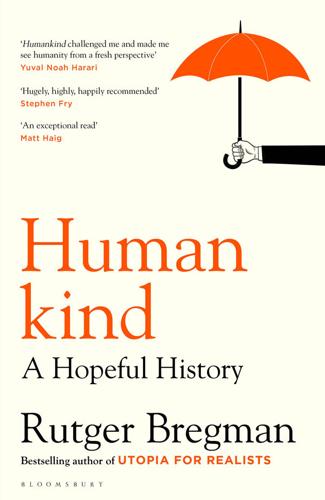
Humankind: A Hopeful History
by
Rutger Bregman
Published 1 Jun 2020
But remember, what’s naive today may be common sense tomorrow. It’s time for a new realism. It’s time for a new view of humankind. ACKNOWLEDGEMENTS In January 2013 I got a message from Dutch philosopher Rob Wijnberg asking if I wanted to grab a coffee. He told me he wanted to discuss plans for launching a new journalism platform. He envisaged a publication with no news, no advertising and no cynicism. Instead, we would offer solutions. Within months, what would become De Correspondent had set a new world record in crowdfunding, and I had a new job. This book is the result of seven years of working at De Correspondent.
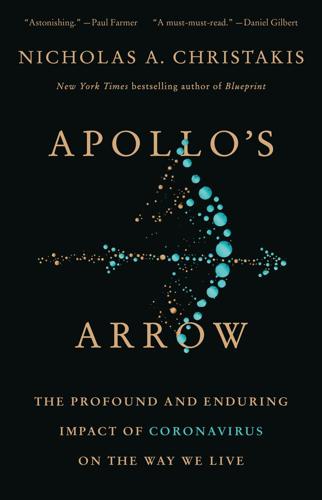
Apollo's Arrow: The Profound and Enduring Impact of Coronavirus on the Way We Live
by
Nicholas A. Christakis
Published 27 Oct 2020
As historian Frank Snowden has argued, the emergence of the worldwide pandemic of HIV in the 1980s was the death knell of this optimism.5 Still, it took some time to reset expectations. In 1992, the U.S. government allocated just seventy-four million dollars for infectious disease surveillance.6 In 1994, the CDC founded a new journal, Emerging Infectious Diseases (wherein many outstanding articles about COVID-19 would be rapidly published in 2020). In 1996, President Clinton issued a statement noting that emerging infectious diseases were “one of the most significant health and security challenges facing the global community” and, of course, the United States itself.7 In 1998, the U.S.
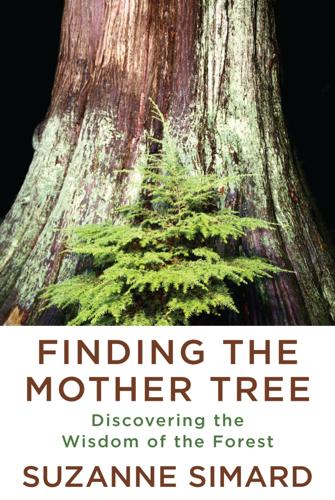
Finding the Mother Tree: Discovering the Wisdom of the Forest
by
Suzanne Simard
Published 3 May 2021
He was right, but I couldn’t seem to follow either of his suggestions. I convinced myself things would quiet down. I was too tired and guileless to grasp the importance of what was going on, to go public with my responses. The original group soon published an article detailing its complaints. Soon new journal articles appeared citing my work alongside the rebuttal, giving the complaints equal footing. A shadow was growing over my work. To Don, the solution remained clear. Stop fretting and write. “I know,” I’d say, wringing my hands. Dave, seeing I was at a standstill, wrote a rebuttal to the rebuttal and published it in Trends in Ecology and Evolution.
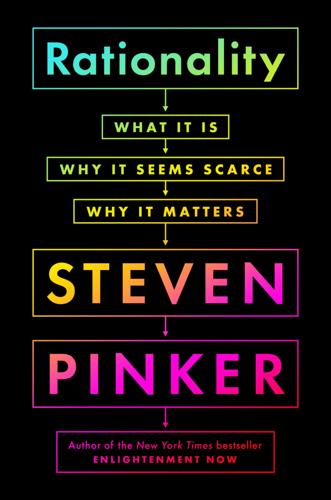
Rationality: What It Is, Why It Seems Scarce, Why It Matters
by
Steven Pinker
Published 14 Oct 2021
Causality: Models, reasoning, and inference. New York: Cambridge University Press. Pearl, J., & Mackenzie, D. 2018. The book of why: The new science of cause and effect. New York: Basic Books. Pennycook, G., Cannon, T. D., & Rand, D. G. 2018. Prior exposure increases perceived accuracy of fake news. Journal of Experimental Psychology: General, 147, 1865–80. https://doi.org/10.1037/xge0000465. Pennycook, G., Cheyne, J. A., Koehler, D. J., & Fugelsang, J. A. 2020. On the belief that beliefs should change according to evidence: Implications for conspiratorial, moral, paranormal, political, religious, and science beliefs.
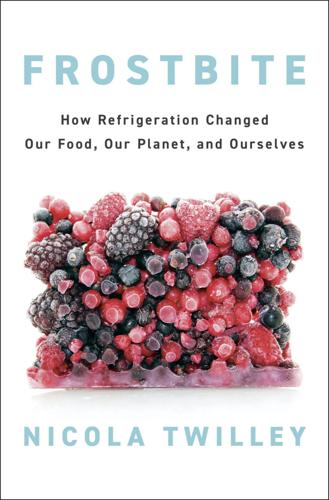
Frostbite: How Refrigeration Changed Our Food, Our Planet, and Ourselves
by
Nicola Twilley
Published 24 Jun 2024
I also referenced the following: Shane Hamilton, “Cold Capitalism: The Political Ecology of Frozen Concentrated Orange Juice” (Working Paper No. 35, Program in Science, Technology, and Society, Massachusetts Institute of Technology, February 2003); Thirteenth Annual Citrus Statistical Survey, Agricultural Marketing Service, Florida Department of Agriculture, March 1961; “From the Concentrate Revolution to the Decline of Florida Citrus” in the online exhibition Bittersweet: The Rise and Fall of the Citrus Industry in Florida, Florida Memory, State Library and Archives of Florida; Angelico Law, “Brazil’s Foothold in the Orange Juice Industry,” October 5, 2018; “The 100-Year Journey of the UF/IFAS Citrus Research and Education Center,” UF/IFAS Communications, November 2017; United States International Trade Commission, “In the Matter of Certain Orange Juice from Brazil,” Investigation No. 731-TA-1089 (Washington, DC: Heritage Reporting, 2012); Duane D. Stanford, “Coke Has a Secret Formula for Orange Juice, Too,” Bloomberg Businessweek, February 4–10, 2013; “How Orange Juice Was Built,” Proof, January 2021; Josephine Peterson, “Port of Wilmington Worker Critically Injured after Falling 50 Feet in Juice Storage Tank,” News Journal, January 9, 2019; “Crowning Achievements in Bulk Aseptic Storage,” Food Engineering, October 3, 2007; “Tropicana Products, Inc.,” Reference for Business, Company History Index; and Marisa L. Zansler, “Overview of Recent OJ Retail Sales Trends and Florida Processor Movement,” FDOC Live Webinar Series, April 30, 2020. 5.
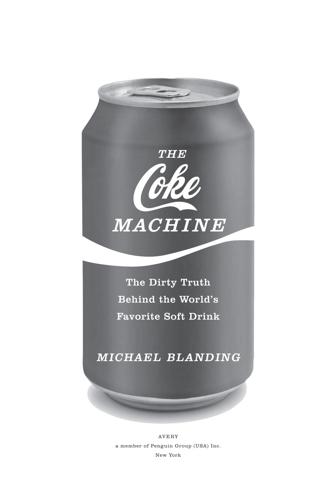
The Coke Machine: The Dirty Truth Behind the World's Favorite Soft Drink
by
Michael Blanding
Published 14 Jun 2010
Page 126 just over $2 per gallon: Mintel International Group, “Bottled Water—US—2008, Executive Summary.” Page 126 one- or two-tenths of a cent per gallon: Natural Resources Defense Council; Food & Water Watch. Page 127 idea of the Tap Water Challenge: Gigi Kellett, interview by the author. Page 127 Newark or Philadelphia tap water: Gary Haber, “Dozens Protest Coca-Cola Outside Annual Meeting,” News Journal (Wilmington, DE), April 20, 2006; Akweli Parker, “Taking the Water Taste Test; Actually, No One Bothered to Keep Score in This Bottled vs. Tap Challenge. Activists Felt They Made Their Point,” Philadelphia Inquirer, March 22, 2006. NOTES 327 Page 127 sources its water from an underground aquifer: Lee Klein, “Bottled Water Gets the Boot,” Miami New Times, August 14, 2008.
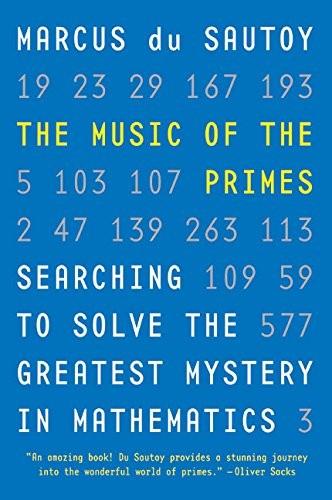
The Music of the Primes
by
Marcus Du Sautoy
Published 26 Apr 2004
Cambridge was beginning to blossom as it opened its doors to the influences of the intellectual tradition across the Channel. Travel between the Continent and England was becoming easier, and Hardy and other academics were making the effort to visit many of the European centres of learning. The new contacts they made encouraged a flow of new journals, books and ideas from abroad. Trinity College in particular became an extraordinarily vibrant community in the early twentieth century. The Senior Combination Room was no longer a gentleman’s club, but a place of research. Conversation at high table did not confine itself to port and claret but was infused with the ideas of the day.
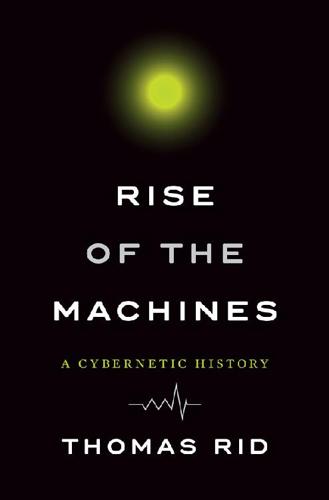
Rise of the Machines: A Cybernetic History
by
Thomas Rid
Published 27 Jun 2016
Cybernetics was coherent and convincing enough to be an emerging field, and it was incoherent enough to attract a wide range of scholars.50 Mathematicians, physicists, and biologists, as well as philosophers and sociologists, seized the cybernetic vision and produced thousands of books and research articles between the late 1950s and early 1970s. New journals sprang up. International conferences were held. New graduate degrees on cybernetics emerged. The neologism found its way into the world’s languages and dictionaries. Early cybernetic work sought to articulate and apply the principles by which systems could be controlled. Later cybernetic scholarship became more abstract: cyberneticists asked how systems would describe themselves, how they organize themselves, and how they control themselves.

The One Device: The Secret History of the iPhone
by
Brian Merchant
Published 19 Jun 2017
To get to the heart of Wayne Westerman’s story—Apple wouldn’t make him available for an interview—I interviewed Ellen Hoerle, his older sister and only living nuclear-family member. Wayne’s vividly written 1999 dissertation on multi-finger gestures was essential to this chapter, and surprisingly fun to read. I plumbed early interviews with his alma mater’s newspaper, the New York Times, and the News Journal, which are where any quotes attributed to him originate. Jeff White, the erstwhile FingerWorks CEO, gave an interview to Technical.ly/Philly, which quotes are drawn from. As a nontouch aside, it’s also worth noting that Tim Berners-Lee built the World Wide Web using a NeXT Cube—the computer made by the company Steve Jobs founded after getting fired from Apple. 5.

Traders, Guns & Money: Knowns and Unknowns in the Dazzling World of Derivatives
by
Satyajit Das
Published 15 Nov 2006
They proselytized about risk, risk management was now the key to success in a new volatile world, you gotta have risk management! To get risk management you needed to buy truckloads of computer hardware and software, then pay millions for consultants to help you implement those systems, and more still to use them. Academics contributed erudite papers in new journals devoted to the subject. It went on and on. These days the risk management industry is big on conferences which are sponsored by risk consultants and technology firms. I recently attended one after a gap of almost ten years. The session was entitled something like DAS_C06.QXP 8/7/06 4:43 PM Page 156 Tr a d e r s , G u n s & M o n e y 156 Risk Management: The New Paradigm.
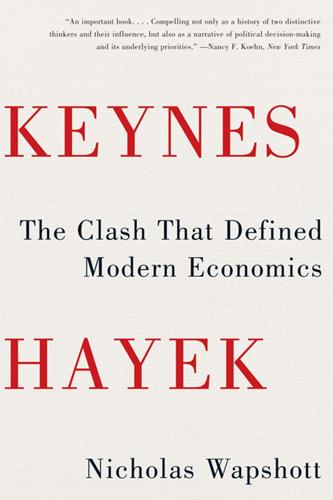
Keynes Hayek: The Clash That Defined Modern Economics
by
Nicholas Wapshott
Published 10 Oct 2011
I must say it was an exciting experience and I found a lot of people quite prepared to give the paper serious attention.”41 Abba Lerner, a Hayekian graduate student at the LSE spending a term at Cambridge, approached Richard Kahn and other Circus members “to suggest that the young generation on each side should get together and settle the debate amongst themselves.”42 The Cambridge contingent agreed, and both sides decided that an account of the debates should be logged in a new journal, Review of Economic Studies. There were also face-to-face meetings between the two sides at a public house in Newport, Essex. The location was significant. Newport was in an intellectual no-man’s-land about halfway between Cambridge and London. At the first meeting, in August 1933, in the Cambridge corner were Kahn, Joan and Austin Robinson, and James Meade; on the LSE team were Lerner, Sol Adler, Ralph Arakie, and Aaron Emanuel.43 Typical of the tone of the discussion was Kahn’s remark, “If Hayek believes that the spending of newly printed currency on employment and consumption will worsen our current terrible depression, then Hayek is a nut.”44 Joint seminars were also held one Sunday each month in either Cambridge, Oxford, or London, with young economists such as Hugh Gaitskell45 from University College London joining.
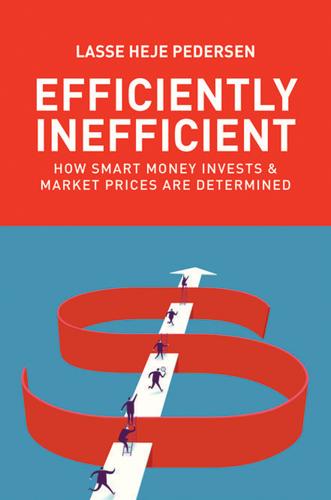
Efficiently Inefficient: How Smart Money Invests and Market Prices Are Determined
by
Lasse Heje Pedersen
Published 12 Apr 2015
French (2010), “Luck versus Skill in the Cross-Section of Mutual Fund Returns,” The Journal of Finance 65, 1915–1947. Fama, E. F., and MacBeth, J. D. (1973), “Risk, Return, and Equilibrium: Empirical Tests,” Journal of Political Economy 81(3), 607–636. Frazzini, A. (2006), “The Disposition Effect and Underreaction to News,” Journal of Finance 61, 2017–2046. Frazzini, A., and L. H. Pedersen (2013), “Embedded Leverage,” working paper, AQR Capital Management and New York University. Frazzini, A., and L. H. Pedersen (2014), “Betting Against Beta,” Journal of Financial Economics 111(1), 1–25. Frazzini, Andrea, Ronen Israel, and Tobias Moskowitz (2012), “Trading Costs of Asset Pricing Anomalies,” working paper, AQR Capital Management and University of Chicago.
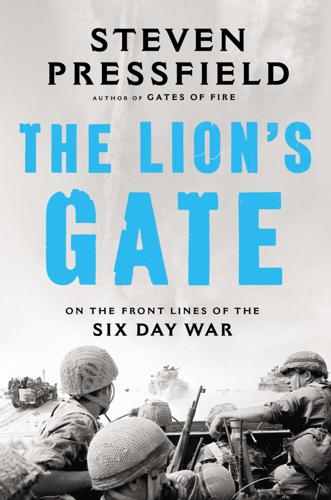
The Lion's Gate: On the Front Lines of the Six Day War
by
Steven Pressfield
Published 5 May 2014
Yet I have written “his” chapters in the first person, as if in his own words. Why am I calling this book “hybrid history”? Because I have elected in its composition to employ techniques from a number of disciplines—from journalism and academic history, from conventional nonfiction and narrative nonfiction, and from New Journalism. The Dayan chapters must be considered the latter. Dayan did not dictate these sentences into my tape recorder. They are not his testimony or his recounting of events. However, I have made every effort to be as true to the historical Moshe Dayan as my limitations of knowledge and imagination permit.
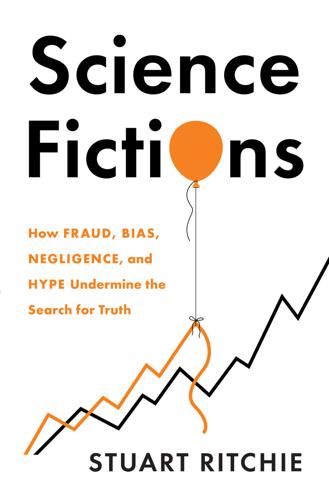
Science Fictions: How Fraud, Bias, Negligence, and Hype Undermine the Search for Truth
by
Stuart Ritchie
Published 20 Jul 2020
Phil Davis, ‘The Emergence of a Citation Cartel’, Scholarly Kitchen, 10 April 2012; https://scholarlykitchen.sspnet.org/2012/04/10/emergence-of-a-citation-cartel/ 54. Paul Jump, ‘Journal Citation Cartels on the Rise’, Times Higher Education, 21 June 2013; https://www.timeshighereducation.com/news/journal-citation-cartels-on-the-rise/2005009.article. The cartels may also have found their Eliot Ness: an algorithm was developed in 2017 which, when fed data on citations, flags up groups of authors who appear to be citing each other disproportionately. Iztok Fister Jr. et al., ‘Toward the Discovery of Citation Cartels in Citation Networks’, Frontiers in Physics 4:49 (15 Dec. 2016); https://doi.org/10.3389/fphy.2016.00049 55.

Empire of the Scalpel: The History of Surgery
by
Ira Rutkow
Published 8 Mar 2022
For Martin, “show me” became a surgical imperative: The phenomenal acceptance of Surgery, Gynecology & Obstetrics was conclusive proof that the profession preferred to receive information directly from practicing surgeons rather than from non-practicing editors who acted merely as interpreters. And it was far better to have a practicing surgeon demonstrate his work than to have him tell about it.20 In 1910, Martin placed announcements in his new journal for a clinical meeting to be held in Chicago where physicians, as long as they had the slightest interest in surgery, could visit the operating rooms of the city’s great surgeons. “It was an innovation,” claimed Martin, “that the academic orators and medical politicians watched with amusement that they did not conceal, but it stirred in the minds of practical surgeons a hope.”21 He expected two hundred attendees.
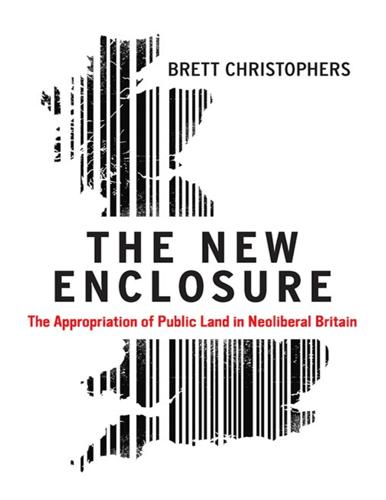
The New Enclosure: The Appropriation of Public Land in Neoliberal Britain
by
Brett Christophers
Published 6 Nov 2018
Wainwright, ‘The Radical Model Fighting the Housing Crisis: Property Prices Based on Income’, Guardian, 16 January 2017. 2 See Ryan-Collins et al., Rethinking the Economics of Land and Housing, p. 198. 3 Wainwright, ‘Radical Model’. 4 Ibid. 1 D. Carrier, ‘Town Hall Urged to Allow Community Land Trust in King’s Cross’, Camden New Journal, 16 February 2017, at camdennewjournal.com. Index Aberthaw, 335 absorption rate, 172 accounting, 199–203 Adams, John, 27 Adams, Martin, 35–6, 47, 48 Adam Smith Institute (ASI), 123, 137–8, 139 Adonis, Andrew, 160–1, 162, 236 affordable housing, 228, 273, 282–3, 312–4, 319, 337, 338–9, 343, 346–7 Albanwise, 299 allemansrätten, 29 Amos, Gideon, 229–30 Annington Homes, 154, 252, 271, 273–6, 311–2 Anti-Corn Law League, 86 Architects for Social Housing, 325 Arnaboldi, Michela, 180 Arnold, Martin, 1, 2 Arrighi, Giovanni, 17 Arthur, Simon, 152 asset management, 142–3, 180, 184, 206–7 asset rents, 140, 178–80 Astley, Edward, 104 Attlee, Clement, 97 Audit Commission, 180, 202–3, 257–8 austerity policy, 119–20, 147–9, 206, 213, 244, 256, 341–3 Australia, 51 Aviva, 298 Baldry, Tony, 204–5 Ball, Michael, 287–8 Barnes, Yolande, 163 Barnsley, 270 Barratt Developments, 169 Bawden, Anna, 212 Beachy Head, 242 Beevor, Stuart, 295 Bentley, Daniel, 98, 171–2 Benyon, Bill, 203, 203n1 Benyon, Richard, 203n1 Beresford, Paul, 177 Berkeley Group, 123, 169, 218, 236–7 Berkshire, 203 Berwin Leighton Paisner (BLP), 167 Bill Sargent Trust, 277–9 Birmingham, 100 Blackman-Woods, Roberta, 151n2, 189–90 Blair, Tony, 74, 192, 251–2 Block, Fred, 70 Blomley, Nick, 14 BNP Paribas, 298 Boles, Nick, 158–9 Bootle, 165–6 Bowie, Duncan, 158–9 Box, Peter, 170 Boyson, Rhodes, 257 Bracknell, 99 Bradford, 204 Brazil, 5 British Coal, 18 British Gas, 133, 328, 329 British Land Company, 298 British Museum, 199 British Rail, 18, 210, 226, 248 landholdings, 97, 105, 187, 247, 261 British Railways Board (BRB), 229 landholdings, 100 British Transport Commission (BTC), 105 British Virgin Islands (BVI), 195 Broadgate, 314 Broadwater Farm estate, 325 Brookfield Asset Management, 298 Brown, Wendy, 15–6 Brownfield land, 160–2, 165, 197, 199 Broxtowe borough council, 324–5 Buccleuch Estates Ltd., 191 budgets, squeezing, 205–6 Build Now, Pay Later scheme, 236, 265, 282 Cabinet Office, 122, 122n1, 135, 137, 174, 182, 264, 268–9 Cable, Vince, 340 Cahill, Kevin, 25, 31, 74, 84, 90, 116, 173, 189, 247–8, 297 Callcutt, John, 303 Camden, 204, 347 Cameron, David, 137, 159, 192–4, 254, 303, 326, 327, 333 Canada, 5 Canary Wharf, 314, 317–8 Canary Wharf Group Investment Holdings, 298 Canterbury City Council, 266, 271 Capital (Marx), 62, 67–8 capital charging, 178–80, 184–5 capital gains, 48–55, 61–2, 64 Capital in the Twenty-First Century (Piketty), 53–4 capitalism and land, 11–13, 26, 34–5, 38– 72, 75, 83, 113–4, 283 contradictions of, 59–60, 62–3, 283 rentier form of, 305–11 role of the state in, 39–40, 64–5, 71 Cardiff, 265–6 Carlino, Nicholas, 268 Carlisle, John, 221 Catalano, Alejandrina, 52, 112–3, 116–7, 117n2, 297, 328–9, 339, 341 Cayman Islands, 195 Central Bedfordshire Council, 219 central government. see also Whitehall landholdings, 87, 115, 117, 134, 198, 209, 251–4, 259–63 Centre for Environmental Studies, 328–9 Centre for Policy Studies (CPS), 179 Chakrabortty, Aditya, 38, 124 Chamberlain, Joseph, 86 Chamberlain Walker Economics, 302n2, 3 Chartist movement, 86 Chelsea Barracks, 253 Churchill, Winston, 48–9, 60–1 City Hall, 199 City of London, 192, 332 city villages, 236, 313 City Villages, 160, 161, 162–3 civil estate, 134–6, 178, 182, 226–7, 253, 260 Civil Estate Property Benchmarking Service, 184 Civitas, 171 Clark, Gordon, 89, 90, 94 Clifford, Ben, 146, 319 coalition government, UK (2010–15), 122, 168, 228, 326 Cobden, Richard, 86 Cogan, Jacob, 27 collectivization, 53n2 Collings, Jesse, 86 Collinson, Patrick, 308 Commission for Architecture and the Built Environment (CABE), 201–2 commodity, land as a, 33–4, 60, 66–72, 311–2, 324, 327. see also ‘fictitious commodities’ Common Good lands, 260 common land, 9, 10–3, 30, 80–3, 116–7, 139, 323, 344 Commons Act (1876), 81, 82 Commons Preservation Society, 81 The Communist Manifesto (Engels and Marx), 46–7 Communities and Local Government Committee, 214n3, 238, 272, 293n4 community benefits, of land disposal, 228, 230, 232, 276–9 Community Care Act, 254 Community Empowerment (Scotland) Act (2015), 239 Community Land Act (1975), 107, 112, 113 Community Land Bill, 107 community land trust (CLT), 346–7 Community Right to Reclaim Land, 151, 228, 237, 238, 239 competition, 15–16, 18n2, 59, 61, 120–1 compulsion, of land disposal, 215–23 compulsory purchase, of land, 40–1, 95, 98–9, 110–1, 314, 320–1 The Condition of the Working Class in England (Engels), 67–8 Conservative Party (UK), 111, 119 donorship, 125 landlord MPs, 122 land privatization, 122, 176, 207, 213, 253, 268 views on landownership, 27, 93, 108, 173, 328 Cooper, Olivia, 88 Corby Borough Council, 266–7n5 Corbyn, Jeremy, 195–6, 337–8 Cornwall, 78 Couchman, James, 136 council estates ‘regeneration’ of, 160–3, 176n1, 236–7, 313, 325, 331 council housing, 240, 272, 314, 320–1, 339. see also Right to Buy policy birth of, 94–5 financing, 145–6, 212–3 land acquisition for, 94–6, 99–100 privatization, 1–2, 7–8, 144–6, 255, 267–8 repurchase by councils, 270–1 waiting lists, 271 Council Tax, 170, 196n2 ‘counter-movement’ (Polanyi), 324, 327, 328 Coventry, 100 Cowen, Tyler, 2–3 Cox, Andrew, 110, 165, 173 Coyle, Diane, 173 Cragoe, Matthew, 88–9 Crawley, 99 Crewe, Tom, 147, 148, 255, 258 Crichel Down affair/rules, 225, 227 Cromwell, Thomas, 79 Crosland, Anthony, 111 Crown Estate, 9–10, 10n1, 88, 116– 7, 259n1, 298 Crown Estate (Scotland), 10n1, 346 Crown land, 88 Cumbria County Council, 12n1 Currie, Edwina, 152 Dalton, Hugh, 110–1, 113 Dalyell, Tam, 217 Davies, Ceri, 18n2, 177–8, 179–80. see also Davies report (1983) Davies, Will, 15 Davies report (1983), 186, 210, 211, 254, 332. see also Davies, Ceri DB Schenker, 273 deBuys, William, 331 Defence Infrastructure Organisation, 165, 215 defence land. see Ministry of Defence, landholdings Defence Lands Committee, 105 deficit reduction, 119, 131, 152, 154, 213 Deloitte Real Estate, 218, 219, 332 Department for Communities and Local Government (DCLG), 198n1, 208, 221–2, 235, 280–2, 284, 285n4, 340n3 Department for Environment, Food and Rural Affairs (DEFRA) landholdings, 209, 259–60, 281 Department for Transport, 273 Department of Health, 221, 254, 280, 281, 333. see also National Health Service Department of the Environment, 187 de-risked sites, 235–6, 285 de Soto, Hernando Mystery of Capital, 34–5 Development Land Tax (1976), 112–3 Dissolution of the Monasteries, 79, 81 Dobson, Frank, 224, 225 Dobson, Julian, 277–9 Domesday Book, 73–4, 77, 199 Dorset, 105–6 ‘double movement’ (Polanyi), 68–9 Downing (property developer), 239 Dunkley, Emma, 1, 2 Eastbourne, 242 Eastbourne Review, 243–4 economic growth, land privatization and, 129, 157–8, 165–7, 264–5, 307–10 Edinburgh, 239 Education Funding Agency (EFA), 232n2, 319 Edwards, Chris, 2 efficiency land allocation, 4, 42–3, 59, 62–5, 286–96 land use, 11–12, 126–7, 136–43, 153, 177–85, 274 Elazar, Dahlia, 26, 27 Elephant Park, 314 employment, land privatization and, 129, 157, 165–7 enclosure movement, 11–4, 30–1, 79–85 Enfield, 320 Engels, Friedrich, 242 The Communist Manifesto, 46–7 The Condition of the Working Class in England, 67–8 enterprise privatizations, 1–3, 6–7, 120–1, 247–8, 299, 328 ‘factor of production,’ 29, 120 Fair, J.
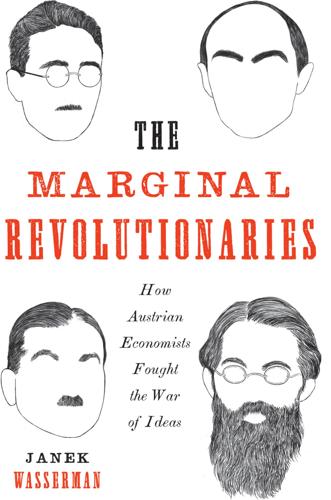
The Marginal Revolutionaries: How Austrian Economists Fought the War of Ideas
by
Janek Wasserman
Published 23 Sep 2019
In it, the Austrians formalized the vigorous defense of liberalism and capitalism initiated in prewar forums like the Colloque Walter Lippmann. Even before the first MPS meeting, the future participants returned to these earlier efforts, recognizing the need for a sounder basis for their worldview. To their dismay, the first forays foundered. Röpke and Hunold discussed forming a new journal, Occident, to revitalize humanistic discourse in Europe. Röpke attracted the support of Hayek and the Italian éminence grise social scientist Benedetto Croce, yet Röpke’s demand for complete editorial control ran afoul of the project’s financial backers. Occident never got off the ground.7 Röpke intended Occident as an ecumenical journal, unifying antifascist scholars under a common banner.
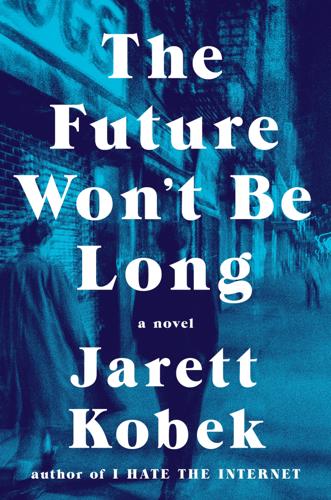
The Future Won't Be Long
by
Jarett Kobek
Published 15 Aug 2017
They’d collapsed back into each other. Maybe good faith can remove any obstacle. Anything is possible. I called Parker and invited him to the pool hall. When he’d discovered the media’s interest, he’d wet himself in joy, encouraging me to dribble every tidbit of gravied information into the gaping maw of news journalism. Any publicity, said Parker, that occurs before a book’s release is a welcome thing. Get your name out there before the reading public. I’d explained how very little I wanted my name associated with Alig’s. I needed time to figure it out. Parker wasn’t interested. —Go hog wild, he said.
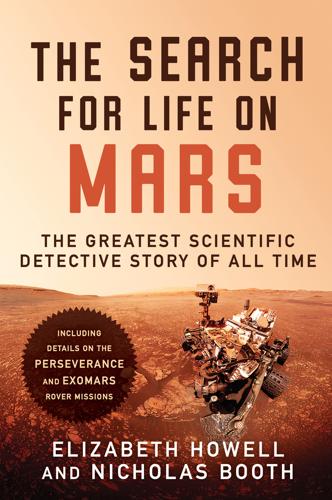
The Search for Life on Mars
by
Elizabeth Howell
Published 14 Apr 2020
See also specific planets elements, 74, 330n evolution, 10, 126, 163, 304 primordial nebula, 50, 52, 54 processes, 52, 54, 90, 170, 226, 241, 266 solar electric propulsion, 287, 338n solar wind, 47, 48, 49, 52, 53, 147, 182, 183, 322n Soviet Union, 3, 5, 188, 273 Mars missions, 95, 96 Mars 2, 96 Mars 3, 96 Phobos 2, 45, 337n, 321n, 325n, 340n space age, 85, 88, 90, 100, 117, 226, 332n Space News (journal), 226, 358n, 362n space race, 94, 117 Space Shuttle program, 120, 168, 233 spacecraft (types), 23, 99, 108, 116, 119, 121, 122, 129, 131, 132, 133, 153, 168, 171, 188, 208, 209, 215, 219, 221, 246, 247, 303 fly-by, 87, 88, 89–91, 95 lander, xi, 6, 23, 27, 29, 30, 33, 34, 40, 102, 136, 156, 159, 215, 219 orbiter, 8, 11, 16, 21, 45, 46, 49, 182, 207, 208, 210, 301 rover, 8, 10, 30, 40, 57, 58–62, 64–73, 77, 78, 83, 84, 125, 131, 133–35, 137–40, 141, 143–45, 151, 152–58, 162, 164, 192, 247, 252, 254, 255, 258, 260, 263, 265, 267, 271, 273–75, 278, 283–86, 288, 289–293, 297, 310, 323n, 328n, 338n, 339n, 347n, 348n, 360n, 361n, 362n, Plates 15 and 16 Spear, Tony, 158 spectroscopy, 28, 91, 106, 202, 203, 263, 286 spectral lines, 64, 73, 92, 93, 197 spectral peaks, 268, 269 spectral shoulders, 269 spectrometer, 29, 58, 63, 72, 73, 78, 79, 81, 95, 102, 112, 129, 130, 133, 156, 181, 190, 216, 217, 218, 222, 228, 229, 238, 258, 261–64, 285–287, 294, 295, 309, 324n, 335n, 336n, 339n, Plate 9 Spirit rover, 62, 63, 66, 76, 133, 134, 135, 138, 144, 163, 189, 190, 191, 274, 275, 285, 347n Spock, Mr., 73 sputtering, 183 Squyres, Stephen, 191, 192, 333n, 347n, 354n Squid (Martian rock), 163 Steltzner, Adam, 57–63, 65, 87, 249–51, 265–67 background 57 Curiosity 57–62, 65, 85, 323n, Plate 6 motivation, 249, 250 Perseverance, 84, 249–51, 265–67 philosophy, 249, 250, 270, 359n step combustion, 228, 229, 230, 295 Straat, Patricia Ann, 217, 218, 219, 356n stratification, 134 stromatolites, 77, 257 Stuurman, Cassie, 12, 344n sublimation, 80, 185, 343n Suicide Club, 87 sulfates, 66, 83, 84, 134, 190, 264, 278, 293 sulfate-rich rocks, 190, 192 sulfate unit, 83, 84 sulfur, 44, 75, 231, 234, 237, 239, 278, 294, 328 sulfurdioxide 195 sulfuric acid 185 Sun, 2, 5, 11, 14, 79, 80, 127, 157, 159, 177, 185, 188, 208, 210, 322n, 331n, 338n early evolution, 177, 183, 187, 353n, 354n influence, 11, 14, 29, 38, 48, 52, 112, 194, 195, power source for spacecraft, 30, 66, 88, 157 solar wind, 46–49, 182 ultraviolet radiation, 11, 72, 80, 91, 131, 307, 341n Surface of Mars, The (Carr), 175, 352n Surveyor 3, 102 Surveyor spacecraft (1960s), 99 swallow tails (crystals), 139 swimmers (in Allan Hills meteorite), 225, 235, 240, 334n Taylor, Thomas Griffith, 6 Terrain Relative Navigation, 254 Terror (sailing ship), 4 Tesla, Nikola, 204 tesla (unit of measure), 49 Texas Monthly (magazine), 224 Tharsis, 36, 174, 191, 278, 322n Tharsis Bulge, 36, 179 THEMIS.

Columbine
by
Dave Cullen
Published 3 Mar 2010
His worst performance was “O.K.” The next day, Eric got right back to it, producing six more pipe bombs—the rest of the Beta batch. Later, he would create Charlie, Delta, Echo, and Foxtrot, using military lingo for all of the batches, except that soldiers use Bravo, not Beta. Eric penned nearly a dozen new journal entries in the next two months. “I have a goal to destroy as much as possible,” he wrote, “so I must not be sidetracked by my feelings of sympathy, mercy, or any of that.” It was a mark of Eric’s ruthlessness that he comprehended the pain and consciously fought the urge to spare it. “I will force myself to believe that everyone is just another monster from Doom,” he wrote.

The War Below: Lithium, Copper, and the Global Battle to Power Our Lives
by
Ernest Scheyder
Published 30 Jan 2024
Author’s interview with Twin Metals staff, June 7, 2022. CHAPTER SIX: A SINGLE POINT OF FAILURE 1. “Rental Space: 824 N Market St,” Loopnet, accessed March 4, 2022, www.loopnet.com/Listing/824-N-Market-St-Wilmington-DE/19219572/. 2. Maureen Milford, “Companies Turn to Delaware to Survive Bankruptcy,” The News Journal, September 19, 2014, www.delawareonline.com/story/money/business/2014/09/19/companies-turn-delaware-survive-bankruptcy/15891887/. 3. Molycorp Minerals LLC v. Debtors, 15-11371 (U.S. Bankruptcy Court, District of Delaware), Document 374. 4. K. A. Gschneidner Jr. and J. Capellen, “Two Hundred Years of Rare Earths, 1787–1987,” Journal of the Less Common Metals, January 1, 1987, www.osti.gov/biblio/6893525. 5.

Computer: A History of the Information Machine
by
Martin Campbell-Kelly
and
Nathan Ensmenger
Published 29 Jul 2013
Marching onward as to war, it has skirted the slough of depression and averted the quicksands of false booms. Save for a few lulls that may be described as breathing spells, its growth has been strong and steady. And the best was yet to come. 3 BABBAGE’S DREAM COMES TRUE IN OCTOBER 1946 the computing pioneer Leslie John Comrie reminded British readers in the science news journal Nature of their government’s failure to support the construction of Babbage’s calculating engine a century earlier: The black mark earned by the government of the day more than a hundred years ago for its failure to see Charles Babbage’s difference engine brought to a successful conclusion has still to be wiped out.
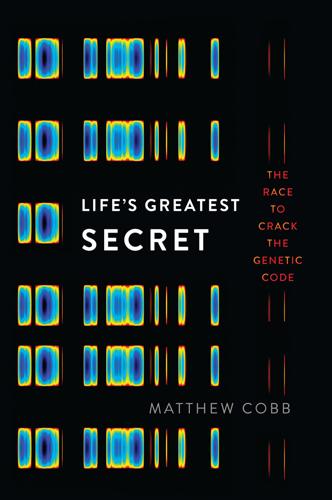
Life's Greatest Secret: The Race to Crack the Genetic Code
by
Matthew Cobb
Published 6 Jul 2015
Crick later said that those who were studying the genetic code had ‘a boundless optimism that the basic concepts involved were rather simple and probably much the same in all living things.’2 Within ten years of the final word in the genetic code being read, it became obvious that such boundless optimism was unfounded, as the assumptions of colinearity and the universality of the genetic code were proved to be wrong. * In autumn 1977, several linked papers appeared in Proceedings of the National Academy of Sciences and in the new journal Cell, which had been set up three years earlier with the ambitious aim of being ‘a journal of exciting biology’.3 For once, the reality lived up to the hype, as the articles announced that, in viruses, genes were not necessarily continuous stretches of DNA but instead could be spread out along a sequence, split into several pieces.4 What Watson called the bombshell discovery of split genes had first been announced at the Cold Spring Harbor meeting in the summer of 1977, and the scientific community was abuzz with the implications.
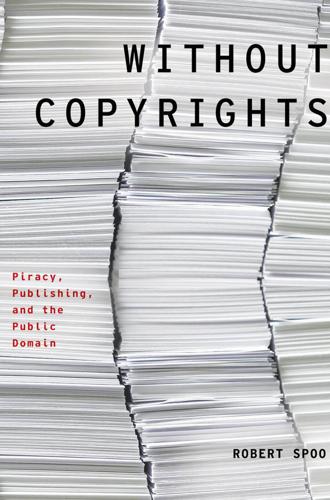
Without Copyrights: Piracy, Publishing, and the Public Domain (Modernist Literature and Culture)
by
Robert Spoo
Published 1 Aug 2013
In an unpublished and undated typescript entitled “The Joyce Incident” (SR), Roth stated that at the time he was negotiating to publish an anthology of American poetry, with Pound as collaborator, Pound “suggested that perhaps I was the very one to carry on, as editor, from where Jane Heap and Margaret Anderson had left off.” This would place Pound’s suggestion in the spring or early summer of 1921. 93. Kugel states that Pound in July 1922 “supported Roth’s proposal to feature a serialization of Ulysses in the new journal,” but she offers no documentary evidence other than Roth’s own assertions (“‘Wroth Wracked Joyce,’” 243). Gertzman notes the slim support for her claim (“Not Quite Honest,” 36, 43). 94. Pound to Roth, 7/4/1922, SR. Pound’s carbon copy of the letter is in WB–EP. Pound’s July 4 letter refers to one he wrote Roth the previous day in which he also made suggestions for Two Worlds.
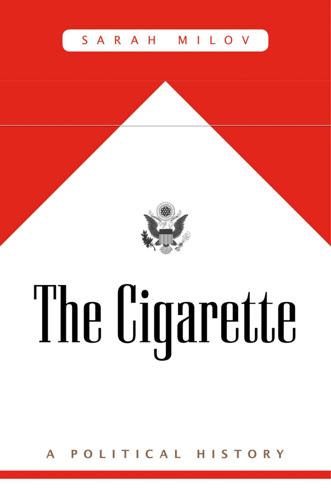
The Cigarette: A Political History
by
Sarah Milov
Published 1 Oct 2019
“North Carolina Policies and Recommendations to the American Farm Bureau Federation, Charlotte, North Carolina, November 21, 1956,” Folder 3, Box 16, NCFB Records, NCSU. 143. “1959 Policies, Resolutions, and Recommendations: North Carolina Farm Bureau Federation, Greensboro, N.C.,” Folder 3, Box 16, NCFB Records, NCSU. 144. Ibid. 145. “N.C. Lawmaker’s ‘Jokes’ Offend, Listeners Walk-Out,” New Journal and Guide, May 26, 1951. 146. Ibid. A handful of letters sent to the congressman, presumably written by African Americans (either present at the talk, or having read the coverage in the black media), reveal the depth of outrage at his comments. 147. David Westfall, “Agricultural Allotments as Property,” Harvard Law Review 79, No. 6 (April 1966): 1181. 148.

Consumed: How Markets Corrupt Children, Infantilize Adults, and Swallow Citizens Whole
by
Benjamin R. Barber
Published 1 Jan 2007
David Chandler approaches what he calls the “imagined concept” of global civil society critically, arguing that it is more attuned to state power and elite economic interests than to the normative interests of international governance about which Mary Kaldor, David Held, and other ardent advocates of global civil society write. See David Chandler, Constructing Global Civil Society: Morality and Power in International Relations (Basingstoke, U.K.: Palgrave Macmillan, 2004). For those wishing to follow the academic debate on these matters, the new journal Globalizations headquartered at Newcastle upon Tyne in England is extremely useful. 56. Emphasis added. This is the definition of political scientist Anne-Marie Slaughter in her A New World Order (Princeton, N.J.: Princeton University Press, 2004), p. 18. See also the enthusiastic account of John Keane in his Global Civil Society?

Track Changes
by
Matthew G. Kirschenbaum
Published 1 May 2016
The editors took this unusual step, as they wrote, “in the conviction that few of us have yet comprehended the all but incredible destructive power of this weapon, and that everyone might well take time to consider the terrible implications of its use.”50 Hiroshima was published in book form by Knopf later that same year, and it has remained in print ever since, widely lauded as one of the most significant nonfiction books of the twentieth century. Notable for its unsparing descriptions of the blast effects and the wounds suffered by the bomb’s victims, it has also frequently been identified with the rise of the New Journalism, a label Hersey himself sought to resist. Hersey was also by then an accomplished fiction writer, and his 1944 novel A Bell for Adano (set in Italy during the war) had won him a Pulitzer Prize. By 1965, however, after two decades of global travel, writing, and reporting, he was ready to put down roots with his second wife, Barbara, and so accepted the unexpected offer of the position of master at Pierson (the first nonacademic ever to hold the post).

The Matter of the Heart: A History of the Heart in Eleven Operations
by
Thomas Morris
Published 31 May 2017
Blades, op. cit., 172 31. ibid. 32. Fred A. Crawford, ‘Horace Smithy: pioneer heart surgeon’, Annals of Thoracic Surgery 89, no. 6 (2010), 2067–71 33. H. G. Smithy and E. F. Parker, ‘Experimental aortic valvulotomy; a preliminary report’, Surgery, Gynecology & Obstetrics 84, 4–A (1947), 625–8 34. ‘Operation saves girl’, News-Journal, (Mansfield, OH), 16 February 1948 35. H. G. Smithy, J. A. Boone and J. M. Stallworth, ‘Surgical treatment of constrictive valvular disease of the heart’, Surgery, Gynecology & Obstetrics 90, no. 2 (1950), 175 36. Crawford, op. cit. 37. ‘Surgeon dies, too weak for own cure’, Salt Lake Tribune, 29 October 1948 38.

12 Strong: The Declassified True Story of the Horse Soldiers
by
Doug Stanton
Published 16 Apr 2009
[Gives] family, friends, and anyone interested in Special Forces a glimpse of the world of the SF operator living and fighting behind enemy lines.” —J.R. Seeger, Studies in Intelligence: Journal of the American Intelligence Professional “Buy and read 12 Strong. Stanton tells this story so well that I would find myself nearly 160 pages along before I needed a coffee refill.” —Mansfield News Journal “An amazing story. The pacing is like [that of] Stanton’s In Harm’s Way. We give it the highest recommendation.” —Ward Carroll, Military.com “Stanton has captured the inner workings of . . . Special Forces operations. A thorough recounting of the events told from the soldiers’ point of view.”
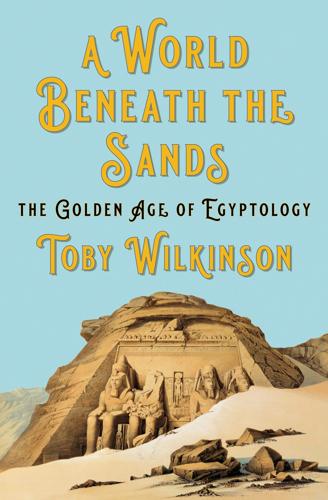
A World Beneath the Sands: The Golden Age of Egyptology
by
Toby Wilkinson
Published 19 Oct 2020
He tried to use his scientific renown to persuade Muhammad Ali of the need for preservation, arguing that: ‘all of Europe will take notice [if] … His Highness would … assure the conservation of temples, palaces, tombs, and all kinds of monuments which still attest to the power and grandeur of ancient Egypt, and which are at the same time the most beautiful ornaments of Modern Egypt.’41 In a nod to this sentiment, Muhammad Ali chose a pyramid as the masthead of his new journal, Al-Ahram (The Pyramids), which remains the official organ of the Egyptian government to this day. But the ruler of Modern Egypt was much more interested in European technology than in lectures about conservation, much more focussed on Egypt’s industrial potential than on the sentimental value of a bunch of old ruins.
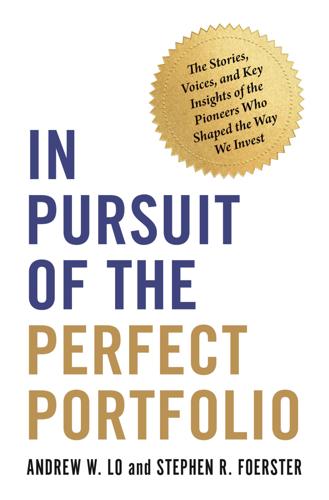
In Pursuit of the Perfect Portfolio: The Stories, Voices, and Key Insights of the Pioneers Who Shaped the Way We Invest
by
Andrew W. Lo
and
Stephen R. Foerster
Published 16 Aug 2021
Bob gave us that argument. It should probably be called ‘The Black-Merton-Scholes’ paper.”41 After Merton had completed and polished his working paper, “Theory of Rational Option Pricing,”42 he searched for a possible outlet for its publication.43 His colleague Paul MacAvoy had recently become editor of a relatively new journal, Bell Journal of Economics and Management Science, published by Bell Laboratories. MacAvoy expressed interest in publishing the work, despite its length, and even offered $500 for the manuscript—quite tempting, as his yearly salary at the time was only $11,500. Merton graciously asked MacAvoy to delay its publication until Black and Scholes’s paper appeared, since his paper referred to theirs.
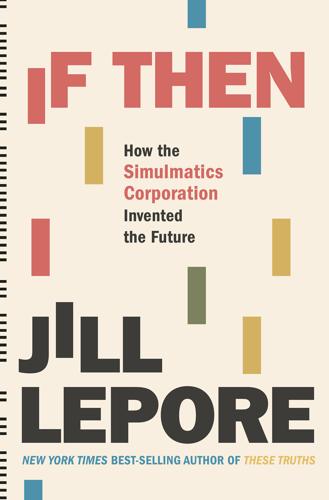
If Then: How Simulmatics Corporation Invented the Future
by
Jill Lepore
Published 14 Sep 2020
TBM, “The People-Machine.” TBM, Self-Creations: 13 Impersonalities (New York: Holt, Rinehart & Winston, 1965), 3. Ibid., 1. TBM, “Madly for Adlai.” TBM, Self-Creations, 3–15. Kate Tarlow Morgan, interview with the author, July 2, 2018. Marc Weingarten, Who’s Afraid of Tom Wolfe? How New Journalism Rewrote the World (London: Aurum, 2005), 44–46. Douglas Martin, “Thomas B. Morgan, Writer, Editor and Lindsay Press Aide, Dies at 87,” NYT, June 18, 2014. TBM, “The People-Machine.” James E. Doyle to NM, May 6, 1959, Stevenson Papers, Box 38, Folder 7. Wisconsin lawyer James E. Doyle served as the executive director of the 1960 National Stevenson for President Committee.

Blood in the Machine: The Origins of the Rebellion Against Big Tech
by
Brian Merchant
Published 25 Sep 2023
Dismissed by Byron, a depressed Polidori collected gambling debts, saw his manuscript of The Vampyre published against his will, under Byron’s name, and died by suicide a few years later at the age of twenty-five. In 1822, Percy Shelley, whose stature rose as more of his works were published, sailed to meet Byron and the publisher Leigh Hunt in Livorno, Italy, to begin preparations for a new journal, The Liberal. On his return voyage, a storm swallowed his ship and he drowned at twenty-nine. Byron had been living in Italy for years when, tired of the idle aristocratic life there, he traveled to Greece to assist in its campaign for independence from the Ottoman Empire. While supporting the rebel army and helping to plan an attack on the Turks, he fell ill, was treated with bloodletting, contracted sepsis, and died at thirty-six.

The Rise and Fall of the Neoliberal Order: America and the World in the Free Market Era
by
Gary Gerstle
Published 14 Oct 2022
This was the moment when the New Deal transitioned from political movement to political order, when all meaningful players in the political arena felt compelled to abide by its principles. There were, of course, dissenters. The brilliant and iconoclastic Yale graduate William F. Buckley was, at this very moment, assembling a fiercely anti–New Deal group around a new journal, National Review.65 The actor and former New Deal enthusiast Ronald Reagan had become an evangelist for America’s free enterprise system, speaking on TV in spots sponsored by General Electric to audiences across the country.66 Henry Hazlitt, an economics columnist for the popular magazine Newsweek was another figure who, like Reagan, had migrated from the center-left (he had once been literary editor of the Nation) to the right, entering Hayek’s orbit as a member of the Mont Pelerin Society along the way.
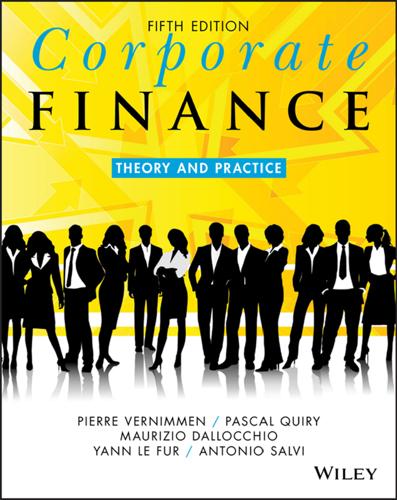
Corporate Finance: Theory and Practice
by
Pierre Vernimmen
,
Pascal Quiry
,
Maurizio Dallocchio
,
Yann le Fur
and
Antonio Salvi
Published 16 Oct 2017
Guthrie, Real Options in Theory and Practice, Oxford University Press, 2009. C. Krychowski, B. Quelin, Real options and strategic decisions: Can they be of use to scholars?, Academy of Management Perspectives, 24(2), 65–78, May 2010. S. Myers, S. Turnbull, Capital budgeting and the capital asset pricing model: Good news and bad news, Journal of Finance, 32(2), 321–333, May 1997. L. Trigeorgis, A conceptual options framework for capital budgeting, Advances in Futures and Options Research, 3, 145–167, 1998. L. Trigeorgis, E. Schwartz, Real Options and Investment under Uncertainty: Classical Readings and Recent Contributions, MIT Press, September 2004.
…
Finally, it is a source of risk: the risk that customers will pay late or will only pay partially or not at all because they have gone bankrupt, which could in turn create problems for the company and create a series of domino-like bankruptcies. It is to alleviate this risk that the European authorities have introduced statutory provisions to reduce payment periods to 45 days end of month or 60 days after the invoice is issued. There is also the risk of the loss of value for obsolescence of certain goods (news journals, cut flowers, yoghurt, etc.). From a more economic point of view, working capital can be: A tool for helping customers or suppliers who are already experiencing problems as a result of a liquidity crisis. For example, in late 2008/early 2009, Peugeot and Renault, who had received cash support from the government, in turn helped their main subcontractors, who were experiencing a liquidity crisis, by reducing their payment periods.

Frommer's San Diego 2011
by
Mark Hiss
Published 2 Jan 2007
Geisel later skewered his uppity neighbors in The Sneetches. 14 05_626214-ch02.indd 1405_626214-ch02.indd 14 7/23/10 11:16 PM7/23/10 11:16 PM 2 SAN DIEGO IN DEPTH San Diego in Pop Culture In the 1960s, Tom Wolfe showed a different side of La Jolla in The Pump House Gang. Written in Wolfe’s “New Journalism” style, the piece offered a portrait of the surf scene centered at Windansea Beach. MUSIC San Diego’s musical tradition was greatly enriched by the closing of New Orleans’s red-light district Storyville in 1917; that brought many Big Easy jazz cats out west, including composer and pianist Jelly Roll Morton, who had a regular gig at the US Grant hotel until he quit upon learning his group was being paid less than the house white band.
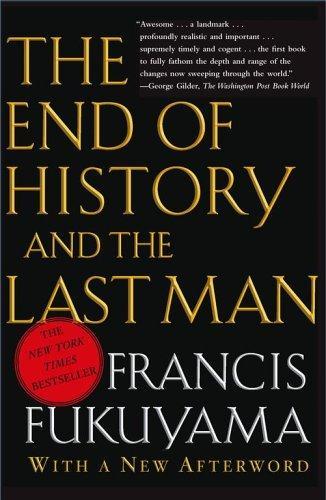
The end of history and the last man
by
Francis Fukuyama
Published 28 Feb 2006
And it turned out that there was only one consistent set of standards by which the old system was measured and found a failure: those of liberal democracy, that is, the productivity of market-oriented economics and the freedom of democratic politics.13 The Soviet people, humiliated by their rulers and despised not only by the rest of Europe but by their own intellectuals as passive accomplices of authoritarianism, proved everyone wrong. After 1989, civil society began reconstituting itself from the clear-cut ground of totalitarianism, through the formation of tens of thousands of new associations—political parties, labor unions, new journals and newspapers, ecology clubs, literary societies, churches, nationalist groups, and the like. The Soviet people’s supposed acceptance of the legitimacy of the old authoritarian social contract was belied by the enormous majorities that voted against representatives of the old communist apparatus at every available opportunity.
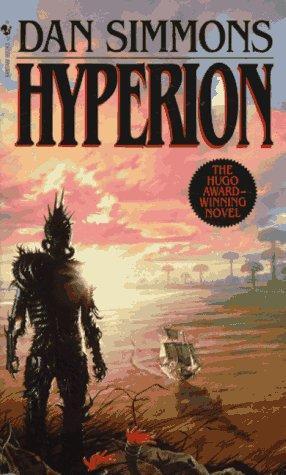
Hyperion
by
Dan Simmons
Published 15 Sep 1990
The effect was to plunge the dining platform and the curved canopy of leaves beneath it into night, but instead of a few thousand stars dotting the sky, as would have been the case from a planet’s surface, literally a million suns blazed above, beside, and beneath the group at the table. Hyperion was a distinct sphere now, hurtling directly at them like some deadly missile. ‘Read,’ said Martin Silenus. FROM THE JOURNAL OF FATHER PAUL DURÉ: Day 1: So begins my exile. I am somewhat at a loss as to how to date my new journal. By the monastic calendar on Pacem, it is the seventeenth day of Thomas-month in the Year of Our Lord 2732. By Hegemony Standard, it is October 12, 589 P.C. By Hyperion reckoning, or so I am told by the wizened little clerk in the old hotel where I am staying, it is the twenty-third day of Lycius (the last of their seven forty-day months), either 426 A.D.C.
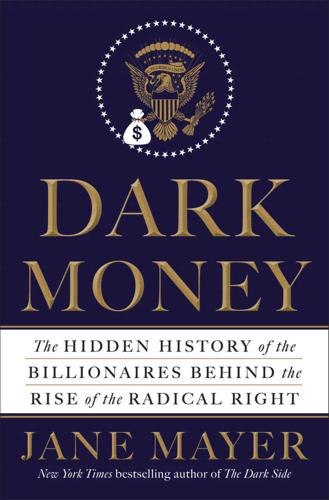
Dark Money: The Hidden History of the Billionaires Behind the Rise of the Radical Right
by
Jane Mayer
Published 19 Jan 2016
According to one 2006 report: Public Citizen and United for a Fair Economy, Spending Millions to Save Billions: The Campaign of the Super Wealthy to Kill the Estate Tax, April 2006, http://www.citizen.org/documents/EstateTaxFinal.pdf. One member of their network: Cris Barrish, “Judge Shuts Down Heiress’ Effort to Alter Trust with Adoption Plot,” Wilmington News Journal, Aug. 2, 2011. “It used to be”: Corn, Showdown, 76. “failed to withstand”: Barry Ritholtz, “What Caused the Financial Crisis? The Big Lie Goes Viral,” Washington Post, Nov. 5, 2011. “right-wing lunacy”: Noam Scheiber, The Escape Artists: How Obama’s Team Fumbled the Recovery (Simon & Schuster, 2011).
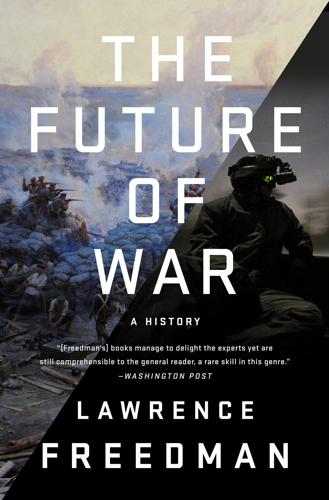
The Future of War
by
Lawrence Freedman
Published 9 Oct 2017
He was concerned that the intellectual chassis of the broad movement for the abolition of war has not been adequate to support the powerful moral engine which drives it and that the frequent breakdowns which interrupt the progress of the movement are due essentially to a deficiency in its social theory.11 In 1955 he became involved with a group based at Michigan, influenced by Richardson (whose writings had just become available although not yet published). They concluded that quantitative methods could generate a new field of peace research. In a ‘race between knowledge and disaster’, the ‘longer disaster is staved off, the better chance we have of acquiring the knowledge to prevent it altogether.’ A new Journal of Conflict Resolution was established to devise, as Boulding put it in an editorial, ‘an intellectual engine of sufficient power to move the greatest problem of our time—the prevention of war.’ The second major centre of peace research was set up in Oslo in 1959 by Johan Galtung. Its Journal of Peace Research was first published in 1964.12 This scientific approach was by no means confined to those with a peace agenda.
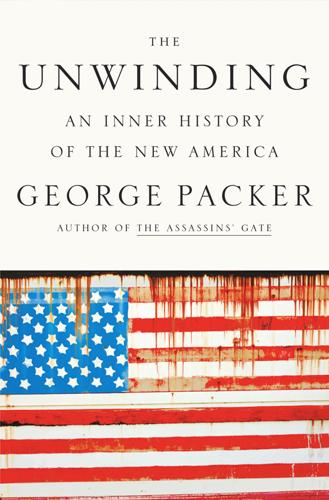
The Unwinding: An Inner History of the New America
by
George Packer
Published 4 Mar 2014
There was a pale version of the Volcker Rule, weak regulation of derivatives, and no clear lines about how much liability banks could sustain. Connaughton and Kaufman drafted a biting critique. “This is really going to piss off Dodd and the administration,” Connaughton warned him. “I’m speaking to the ages,” Kaufman said. The speeches began to be noticed. The News Journal in Wilmington covered them on its front page and quoted them favorably in its editorials, Time magazine profiled Kaufman, and Huffington praised him. Dodd was sufficiently annoyed to call from Central America, where he was leading a congressional delegation, and tell Kaufman, “Stop saying bad things about my bill.”

Red Plenty
by
Francis Spufford
Published 1 Jan 2007
‘Yes; and the Academy’s managed to get a special decree authorising release from any job – any job at all, I believe – if you’re someone the Siberian Division wants to employ. Might be worth looking into, if you’re really interested.’ ‘Quite a nice package,’ said Nemchinov. ‘Mimeo reports to be circulated without pre-approval; new journals if you want to start one; decent company to work in. Economics, maths, biology, geology, automation research, physics. A cyclotron or two for the physicists to play with; a computer centre for everyone else. Machine time on demand, apparently. Apartments half a hectare wide, to compensate for life on the banks of the Ob.
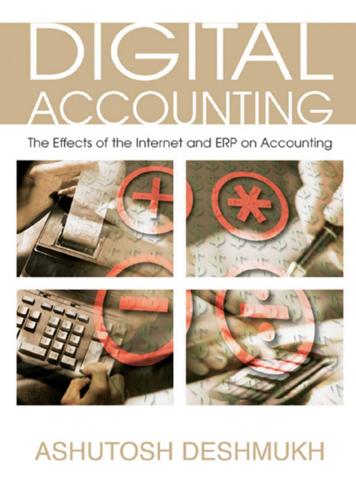
Digital Accounting: The Effects of the Internet and Erp on Accounting
by
Ashutosh Deshmukh
Published 13 Dec 2005
Who has finished and submitted the forms? Who has not opened the forms? E-mails can be automated and sent to laggard users at periodic intervals. User activity is logged and a detailed record of users, forms, changes and approvals is kept. Illustrative additional controls are as follows: First, when files change or new journals are created, the process is flagged and details of the events are recorded. Second, data can be managed by setting up batch processes with stringent controls. Third, users can define their own data validation procedures for incoming or imported data. Fourth, if the budget form is not approved, it cannot be used in budget consolidations.
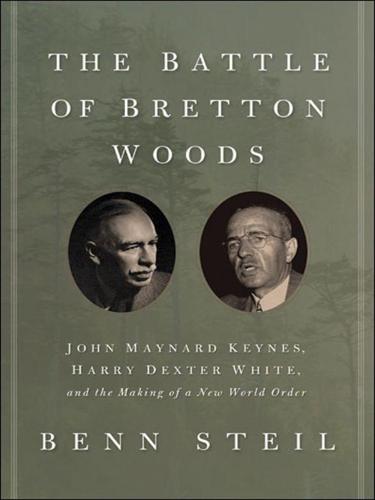
The Battle of Bretton Woods: John Maynard Keynes, Harry Dexter White, and the Making of a New World Order
by
Benn Steil
Published 14 May 2013
Treasury and, 295–96, 298, 323; Venona Project and, 291, 324–29, 358, 366, 368, 375n67, 399n87, 403n93; White and, 35–39, 45–46, 293–97, 318–29, 374n65, 403n93 Ethiopia, 47 Eton College, 62 European Union, 315 exchange rates: anchors and, 33, 76, 138, 252, 340; bancor and, 81, 143–49, 160–63, 173–74, 185, 258, 335, 344, 404n16; benchmarks and, 1; Britain and, 26, 31, 72–73, 77, 84, 109, 193, 254, 257, 260; British pound and, 67, 74, 109, 257, 359; Catto clause and, 217; China and, 235–36, 342–43; Clearing Union and, 142, 158–65, 168, 170, 177–78, 183, 185, 190, 192, 247, 303, 356, 361, 365; convertibility issues and, 69, 77, 84, 147, 150, 177, 181, 195, 215, 218, 225, 251–52, 258, 282, 288, 309–11, 330–33, 364, 392n52; devaluations and, 25, 30–34, 84, 86, 125, 134–35, 144, 147, 166, 178, 225, 253, 289, 331, 334, 338; Eccles and, 235–36; fixed, 134, 136, 143, 194, 258, 274, 330, 338–40, 366, 369; floating, 33, 76, 136, 140, 257, 336–37, 339–40, 343, 360, 404n28; gold standard and, 24, 77 (see also gold standard); intensified swings of, 340; IMF and, 2 (see also International Monetary Fund (IMF)); International Exchange Union and, 170; Keynes and, 73, 76, 139–41, 143, 150, 162, 166–67, 171, 173, 193–94, 196, 217, 289, 331; parity and, 74–77, 178, 230, 256–57, 331, 338–39; pegging and, 7, 33, 48–49, 67–68, 342–43, 376n82, 386n25; Roosevelt and, 26; Rueff and, 335; Russia and, 235–36, 274; Schweitzer on, 338; stabilization of, 256 (see also stabilization); unitas and, 147–49, 173, 176, 185, 258; U.S. dollar and, 24, 67, 74, 109, 136, 342, 359, 376n82; White and, 20, 22, 24, 128, 133–34, 150, 171, 173, 198, 257, 274 Export-Import Bank, Canada, 289 exports: Britain and, 14, 30–31, 85, 115–17, 138, 141, 143, 149, 153, 187, 191–92, 210, 217–18, 230, 256, 261–63, 269, 281, 309, 335; China and, 165; Export-Import Bank, Canada and, 289; Germany and, 72; gold standard and, 384n12; ICB accounts and, 143–44; Latin America and, 230, 341; Lend-Lease effects and, 261–62; Russia and, 236–37; subsidies and, 135, 143, 153; Triffin model and, 334–35; United States and, 21, 23–25, 48, 50, 72, 97, 132, 135–36, 149, 153, 165, 171, 192, 208, 212, 257, 263, 289, 332, 341, 346–47 Faith, Reason, and Civilization (Laski), 43 Farm Credit Administration, 26 Farm Security Administration, 295 fascism, 13, 55, 85, 97, 99, 295 Faussig, Frank, 20 Federal Bureau of Investigation (FBI): Chambers and, 293–97; espionage and, 55, 249, 293–99, 318–19, 323, 325, 327, 329, 351–53, 368, 376, 400n10, 402n78; Hoover and, 297–99, 325, 361–62, 368, 400n13; “Text of Address by Truman Explaining to Nation His Actions in the White Case” and, 352–53; White investigation and, 297–99, 318–19, 352–53, 400n10 Federal Deposit Insurance Corporation, 206 Federation of British Industries, 260 Feis, Herbert, 156, 162, 360 Feltus, Randolph, 255 Financial News journal, 166 First National Bank of Chicago, 207 First United States Army Group, 201 fiscal stimulus, 29, 91, 380n63 Fisher, Irving, 75 floating currencies, 33, 76, 136, 140, 257, 336–40, 343, 360, 404n28 Foley, Edward, 105–6, 360 Foreign Affairs magazine, 347–48 Foreign Economic Administration, 206 Fort Knox, 208 Fourteen Points, 71 franc, 32–33, 72, 346 France: Blum and, 32, 264; Clayton’s European integration plan and, 311–12, 314–15; Clemenceau and, 71; congressional obstruction issues and, 32; de Gaulle and, 334, 359; devaluations and, 32–33; Dunkirk evacuation and, 100–1, 285, 371n2; The Economic Consequences of the Peace and, 71, 73, 77, 369; franc and, 32–33, 72, 346; gold standard and, 25; internationalism and, 99; Italy’s attack on, 101; Munich Agreement and, 50, 100; Operation Overlord and, 201, 215; Popular Front and, 32; postwar setbacks of, 332; quotas and, 237, 242; Rueff and, 73, 91–93, 335, 339–40, 342, 366, 381n95, 404nn13, 16; Schweitzer removal and, 339; Suez Crisis and, 332; surrender of, 101; Treaty of Versailles and, 71, 363; Tripartite Agreement and, 32–33, 37, 49, 110, 256; undervalued currencies and, 25–26 Frankfurter, Felix, 105 Freemasons, 207 free trade, 265; Acheson and, 278; Beaverbrook and, 181; China and, 343; Clayton and, 314, 358; Hull and, 109, 116, 146, 160, 278, 311, 362; Keynes and, 65–66, 74, 82–83, 141, 160, 278; Robbins and, 365; White and, 133, 135, 278; White Plan and, 135 Friedman, Milton, 22, 75, 339–40, 360, 368, 404n28 Fund Commission, 215, 220 Funk, Walther, 234, 360 Geithner, Timothy, 144, 343 General Agreement on Tariffs and Trade (GATT), 314, 383n7 George III, King of England, 10 George VI, King of England, 96 German Army, 172, 272 Germany: American supply line and, 67; armistice and, 19, 71; Atlantic Charter and, 127; beginnings of World War II and, 96–97; Channel dash of, 126; Czechoslovakia and, 94; deception operation against, 201; destruction of Sixth Army of, 172; deutsche mark and, 209, 274, 336–38, 346; exports and, 72; as fifth-rate power, 268; floating mark and, 336–37; hegemony and, 268; Hitler and, 12, 34, 43, 49–50, 94–95, 100–1, 105–8, 244, 247, 264, 267, 271; invasion of Russia by, 58, 118, 295; Marshall Plan and, 315; Molotov-Ribbentrop Pact and, 95; Morgenthau Plan and, 177, 266–74, 315, 322, 360; Munich Agreement and, 50, 100; murder of civilians by, 100; naval aspirations of, 347; Nazis and, 56–57, 95, 100, 102, 108, 112, 201, 226, 234, 271–72, 288, 293, 307, 324–25, 356; Nazi-Soviet Pact and, 56–57, 293, 324–25; pastoralization of, 270; postwar setbacks of, 332; “Program to Prevent Germany from Starting a World War III” and, 267–68; redemption of marks and, 209; reparation payments and, 72–73; Ruhr and, 266; Saar and, 266; siege of Leningrad and, 118; submarine warfare and, 67; surrender of Berlin and, 264; Upper Silesia and, 266; von Rundstedt and, 12; White’s hard line against, 50–52; Wilson’s declaration of war on, 18 Glasser, Harold, 38, 294–95, 298, 318, 321, 326, 360 global trade imbalances, 165, 342 Gold, Sonia, 295, 298, 326 Goldenweiser, Emanuel, 211, 219, 360, 372n12 Gold Reserve Act, 28, 33–34 gold standard, 1, 20, 23, 65, 92, 345, 385n21; Britain and, 24–25, 31, 80, 84–85, 115, 138, 284, 346; Churchill and, 76–77; collapse of, 24–25; diminution of, 64–65; exports and, 384n12; France and, 25; imports and, 24, 384n12; India and, 64; International Clearing Bank (ICB) and, 143–48, 150–53; Keynes and, 75–76, 129, 131, 133, 137–53, 161, 163, 165, 167–69, 172, 187, 195, 252; laissez-faire and, 287; Lend-Lease and, 180; lingering Bretton Woods issues and, 251–52, 256–59, 262, 265, 277, 281, 284, 287, 290; public confidence in, 25; purchasing power and, 384n12; return to, 31–33, 76–77, 184, 256–57, 335, 339–40, 345–46; revival of, 340; Roosevelt and, 25, 27, 33; Rueff and, 92; Special Drawing Right (SDR) and, 335–36, 344–45, 404n18; stabilization and, 20; Triffin and, 335, 339–40; Tripartite Agreement and, 32–33, 37, 49, 110, 256; U.S. abandonment of, 25; U.S. dollar and, 25–27, 33–34, 43, 84, 112, 132, 177, 195, 215, 251–52, 258, 331–38, 341, 364, 385n21, 392n52, 393n53; vital role of, 130; White and, 128–34, 128–35, 129–37, 147–54, 148–49, 149–53, 159–60, 160–61, 166–67, 172, 195, 204, 387n62 Golos, Jacob, 295, 298, 360 Graham, Lindsey, 343 Grant, Duncan, 66, 361 Great Depression, 1, 11, 20, 39, 79, 89, 145 Great Moderation, 341 Great Society, 258 Greece, 231, 235, 308–9 Greenspan, Alan, 341 Gregory, T.

The Enemy Within
by
Seumas Milne
Published 1 Dec 1994
It has it all … But the most disturbing aspect of The Enemy Within is that this is no work of fiction, but a meticulously researched piece of journalism.’ Bolton Evening News ‘The Enemy Within is compulsive reading and I recommend it wholeheartedly. Read it, analyse it and then tell your friends to read it.’ Camden New Journal ‘This book is a must.’ Scottish Trade Union Review ‘Dogged research and incontrovertible evidence.’ Stoke Evening Sentinel ‘Seumas Milne has written an important book, and a brave one.’ Socialist Review ‘The Enemy Within is a tribute to every NUM member and Women Against Pit Closures activist who has fought over the past decade to save pits and miners’ jobs and to sustain mining communities.’ 1995 NUM Annual Report ‘Part detective thriller and part political primer, The Enemy Within … should be read by every trade unionist.’
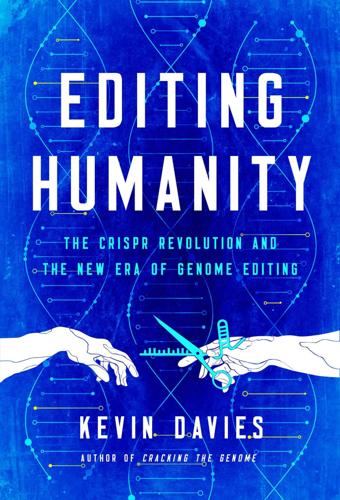
Editing Humanity: The CRISPR Revolution and the New Era of Genome Editing
by
Kevin Davies
Published 5 Oct 2020
And you’d better be able to say that society made a choice to do this—that unless there’s broad agreement, it is not going to happen.”23 * * * Editing Humanity is the story of one of the most remarkable scientific revolutions we have ever seen—the CRISPR revolution. My original intent in this book, supported by a science writing fellowship from the Guggenheim Foundation, was to focus on CRISPR—the science and the scientists. In 2017, I conceived the launch of a new journal called The CRISPR Journal, and began meeting the scientists leading this exciting research. Our journey begins with the stories of a band of unheralded microbiologists and biochemists—the true “heroes of CRISPR”—trying to fathom the function of obscure lines of genetic code in bacterial DNA. CRISPR demonstrates emphatically the immense value of funding basic academic and investigator-driven research.

The Rise of the Israeli Right: From Odessa to Hebron
by
Colin Shindler
Published 29 Jul 2015
In part, he believed that the revolutionary path of the IRA would damage his diplomatic initiatives with the British and validate the philosophy of the biryonim. In contrast, Ahimeir lauded it at every opportunity. Instead, Jabotinsky reclaimed the proposal of Mickiewicz, the Polish national hero, during the mid-nineteenth century to establish a Jewish legion.30 Jabotinsky also made a point of writing in Hazit Ha’am, the new journal of Ahimeir, Greenberg and Yeivin, which had started publication in January 1932 in order to reach those who espoused a Maximalist Revisionism. Significantly Jabotinsky argued that if Jewish youth had responded in 1917 to the announcement in a British government paper, calling for the establishment of a Jewish legion, then Jewish communal leaders would have been unable to play a role.

Stranger Than Fiction: Lives of the Twentieth-Century Novel
by
Edwin Frank
Published 19 Nov 2024
Privately, however, she continued to feel that his writing, however beautiful it could be, failed to compensate for the self-centered and self-consciously shocking character of the book. Then, in 1922, after Jacob’s Room was finished and she had started work on a story that Eliot had gratifyingly said he might like to publish in The Criterion, the new journal he was editing, she decided to give Ulysses another go. The whole book had at last been published in permissive Paris, and though she begrudged the priceyness of the volume, she bought a copy and set out to read it through. She didn’t have mixed feelings this time. She hated it: I should be reading Ulysses, and fabricating my case for & against.

From eternity to here: the quest for the ultimate theory of time
by
Sean M. Carroll
Published 15 Jan 2010
He did not solve it, but submitted an essay that seemed to demonstrate a crucial feature: that the orbits of the planets would be stable. Even without knowing the exact solutions, we could be confident that the planets would at least behave predictably. Poincaré’s method was so ingenious that he was awarded the prize, and his paper was prepared for publication in Mittag-Leffler’s new journal, Acta Mathematica.169 Figure 52: Henri Poincaré, pioneer of topology, relativity, and chaos theory, and later president of the Bureau of Longitude. But there was a slight problem: Poincaré had made a mistake. Edvard Phragmén, one of the journal editors, had some questions about the paper, and in the course of answering them Poincaré realized that he had left out an important case in constructing his proof.
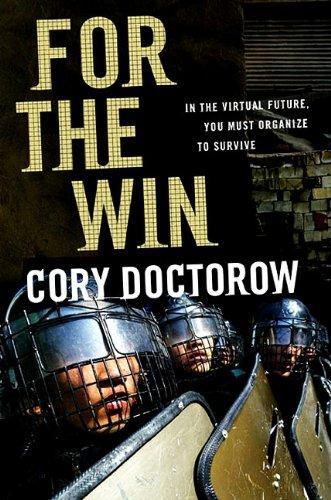
For the Win
by
Cory Doctorow
Published 11 May 2010
Maybe you just call up San Francisco and brief them on what to expect from this guy and take it from there.” Once they were off the line, Lester came up behind her and hugged her at the waist, squeezing the little love-handles there, reminding her of how long it had been since she’d made it to yoga. “You think that’ll work?” “Maybe. I’ve been talking to the New Journalism Review about writing a piece on moral responsibility and paid journalism, and if I can bang it out this aft, I bet they’ll publish it tomorrow.” “What’s that going to do?” “Well, it’ll distract him from Perry, maybe. It might get his employer to take a hard look at what he’s writing—I mean that piece is just lies, mischaracterizations, and editorial masquerading as reportage.”
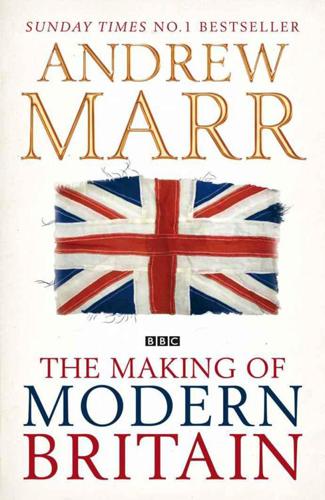
The Making of Modern Britain
by
Andrew Marr
Published 16 May 2007
Harmsworth was called the enemy of the human race and the man who was ruining the Empire. In turn, he shunned the establishment, though he accepted a peerage in 1905, at the time the youngest person to get one. The Edwardian political elite did not know quite how to respond to Northcliffe and the ‘new journalism’ which he represented. It was possible to demonize the man, but it was not possible to brush aside his readership, because it was identical to the newly enfranchised rising classes. He represented a fresh force in Britain, unpredictable and crude but rising, while the aristocracy and ‘country-house government’ was falling.
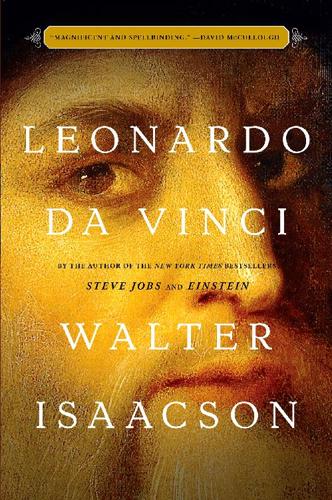
Leonardo Da Vinci
by
Walter Isaacson
Published 16 Oct 2017
Another of the poems portrayed “Leonardo da Vinci, a most noble sculptor and painter,” in humanist terms as an “admirer of the Ancients and their grateful disciple.”7 Leonardo was successful in hanging on to the commission. “On the 23rd of April 1490, I began this notebook and recommenced the horse,” he wrote at the beginning of a new journal.8 On his trip to Pavia with Francesco di Giorgio two months later, Leonardo studied one of the few remaining ancient Roman equestrian sculptures. He was struck by how a statue could convey the impression of motion. “The movement is more praiseworthy than anything else,” he wrote in his notebook.
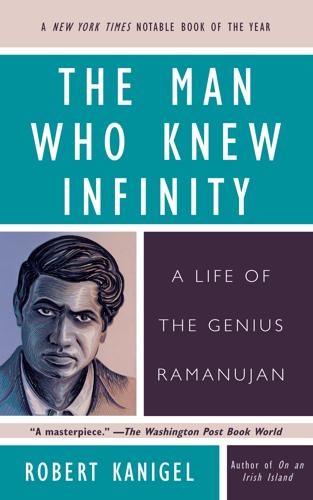
The Man Who Knew Infinity: A Life of the Genius Ramanujan
by
Robert Kanigel
Published 25 Apr 2016
But its founders—hungry to connect with the West, proud of their country’s heritage yet soberly aware that reverence for the past was no substitute for present achievement—surely hoped it did. It was into this nascent new world that Ramanujan “came out,” as it were, as a mathematician in 1911. He had met Ramaswami Iyer, the society’s founder, the previous year when, in search of a job, he had traveled to Tirukoilur. Now Ramanujan’s work was appearing in volume 3 of Ramaswami Iyer’s new Journal—which, like most mathematics publications, opened its pages to provocative or entertaining problems from its readers. One of two problems Ramanujan posed, as question 289, simply asked the reader to evaluate Seemingly straightforward arithmetic, with not so much as an x or y to complicate it?
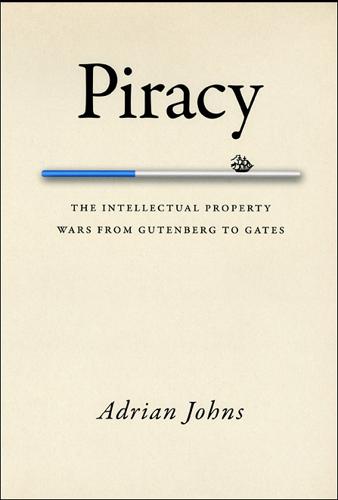
Piracy : The Intellectual Property Wars from Gutenberg to Gates
by
Adrian Johns
Published 5 Jan 2010
There was no great precedent for using print to circulate learned claims periodically in this way, although several Continental groups and individuals had advanced ideas along comparable lines. Periodical publication itself was far more widely, and justly, associated with newsbooks and the like – organs as renowned for their claims to truth and accuracy as for their actual peddling of lies and errors. And sure enough, the new journal’s footing remained precarious, not least because Oldenburg never managed to produce the Latin version on which his plans for economic independence had depended. At first it often missed its intended monthly appearance (it did not help that the first two years of its life happened to be those of the plague and the Great Fire).

The Innovators: How a Group of Inventors, Hackers, Geniuses and Geeks Created the Digital Revolution
by
Walter Isaacson
Published 6 Oct 2014
The next night was kicked off by Kesey, who had been busted for drugs a few days earlier on Brand’s North Beach roof but was out on bail and orchestrating the event from a command scaffold. Featured were the Merry Pranksters and their Psychedelic Symphony, Big Brother and the Holding Company, the Grateful Dead, and members of the Hells Angels motorcycle gang. The writer Tom Wolfe tried to recapture the technodelic essence in his seminal work of New Journalism, The Electric Kool-Aid Acid Test: Lights and movies sweeping around the hall; five movie projectors going and God knows how many light machines, interferrometrics, the intergalactic science-fiction seas all over the walls, loudspeakers studding the hall all the way around like flaming chandeliers, strobes exploding, black lights with Day-Glo objects under them and Day-Glo paint to play with, street lights at every entrance flashing red and yellow, and a troop of weird girls in leotards, leaping around the edges blowing dog whistles.

Like Dreamers: The Story of the Israeli Paratroopers Who Reunited Jerusalem and Divided a Nation
by
Yossi Klein Halevi
Published 4 Nov 2014
By coming to demonstrate here, another settler shouted, you’re telling the Arabs that it’s permitted to spill our blood. Avital and his friends ignored the settlers’ taunts. Faith and memory versus art and peace: sacrament against sacrament. Avital laid his calves’ heads on the street and set them on fire. NEW JOURNALISM, OFRA STYLE MORNINGS, YISRAEL HAREL drove from his home near Ramallah to the Tel Aviv offices of the newspaper Yediot Aharonot. Professionally, personally, he had every reason to feel satisfied. He had fulfilled his lifelong dream of becoming a pioneer, and had managed to preserve his journalism career despite moving to Ofra.
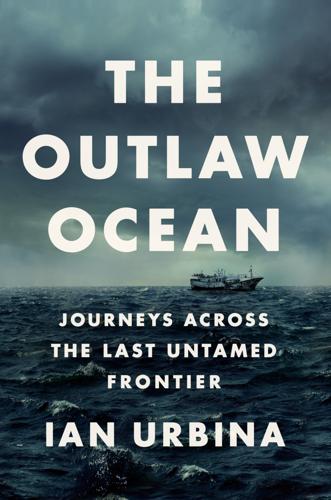
The Outlaw Ocean: Journeys Across the Last Untamed Frontier
by
Ian Urbina
Published 19 Aug 2019
Treasure Hunting Enthusiasts Weigh In on Origins of Couple’s $10 Million Find,” Mail Online, Feb. 27, 2014; David McCormack, “Couple Who Found $10 Million Haul of Gold Coins Can Expect to Give Half of Their New Found Fortune to the Taxman,” Mail Online, Feb. 28, 2014; Maureen Milford, “A Tale of Lost Treasure,” News Journal, March 16, 2014; Karla Zabludovsky, “Sunken Ship Laden with Gold Lures Treasure Hunters—Again,” Newsweek, March 28, 2014; Kim Victoria Browne, “Trafficking in Pacific World War II Sunken Vessels: The ‘Ghost Fleet’ of Chuuk Lagoon, Micronesia,” GSTF Journal of Law and Social Sciences, April 1, 2014; Eric Russell, “Treasure Hunter Attracts Scrutiny: The Maine Office of Securities Says It Is Seeking Information from Potential Investors About Greg Brooks of Gorham,” Portland Press Herald, April 15, 2014; Eric Russell, “Testimony in Suit Calls into Question Salvager’s ‘Plan B’; Did a Treasure Hunter Mislead Investors?

The Pentagon: A History
by
Steve Vogel
Published 26 May 2008
Symbol, Latino Muscle,” WP, 4 Apr. 2002; Fredrick Kunkle, “At Pentagon, Healing and Rebuilding,” WP, 22 Jan. 2002; Carter, author interview; Catlow, author interview; Evey, author interview, 2002; Stephen Ludden, author interview, 3 Apr. 2006. Everyone worked with purpose Fredrick Kunkle, “On the Job With Pride and Pain,” WP, 18 Feb. 2002; Travis Fox, “Rebuilding a Fortress, Rebuilding a Life,” 16 Aug. 2002, washingtonpost.com; “The Early Show,” CBS, 11 Mar. 2002; Wilmington News-Journal, 11 Apr. 2002. The odd couple Evey and Kilsheimer Kilsheimer, author interview; Vogel, “From Ruins, Pentagon Rises Renewed.” Working seven days a week Ibid.; Evey e-mail about Kilsheimer, 28 Nov. 2001, Evey papers; Ori Nir, “A Son of Survivors Raises the Pentagon from the Ashes,” Forward, 20 Sept. 2002; Kilsheimer, OSD interview; Kilsheimer Fairfax remarks.
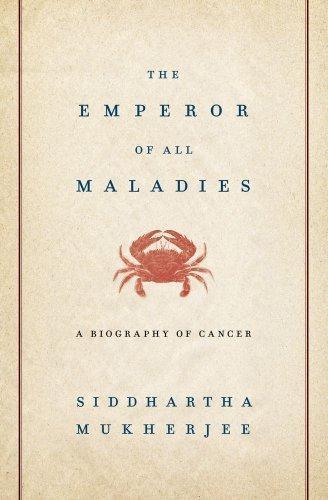
The Emperor of All Maladies: A Biography of Cancer
by
Siddhartha Mukherjee
Published 16 Nov 2010
“Remote sympathy” 55 In treating of cancer: Samuel Cooper, A Dictionary of Practical Surgery vol. 1 (New York: Harper & Brothers, 1836), 49. 55 “If a tumor is not only movable”: John Hunter, Lectures on the Principles of Surgery (Philadelphia: Haswell, Barrington, and Haswell, 1839). 56 “I did not experience pain”: See a history of ether at http://www.anesthesia-nursing.com/ether.html (accessed January 5, 2010). 56 “It must be some subtle principle”: M. Percy, “On the Dangers of Dissection,” New Journal of Medicine and Surgery, and Collateral Branches of Science 8, no. 2 (1819): 192–96. 57 It “occurred to me”: Joseph Lister, “On the Antiseptic Principle in the Practice of Surgery,” British Medical Journal 2, no. 351 (1867): 246. 57 In August 1867, a thirteen-year-old: Ibid., 247. 58 In 1869, Lister removed a breast tumor: James S.
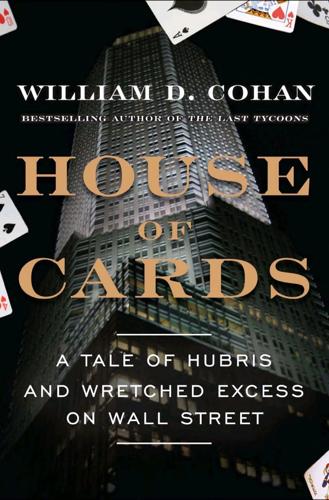
House of Cards: A Tale of Hubris and Wretched Excess on Wall Street
by
William D. Cohan
Published 15 Nov 2009
Sherman had also called Schwartz, as had Barrow, and told him: “You guys better do something because I'm hearing rumblings. You've got to take over or your good people are going to leave.” Schwartz did his best to deflect the shareholders' calls. Then Cayne called Sherman when he heard about the new Journal and Times articles. Sherman had been a longtime Bear shareholder, unlike both Lewis and Barrow, and had been euphoric in his praise of Cayne when the stock was steaming toward its all-time high a year earlier. Sherman's sentiment had changed. Cayne said he had decided, on January 4, the time had come.
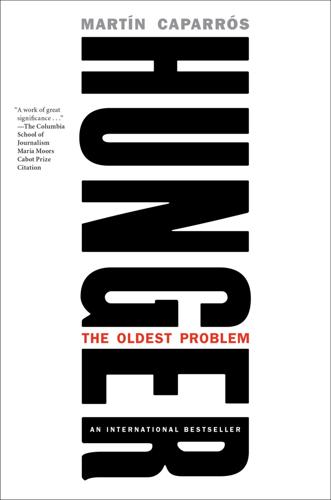
Hunger: The Oldest Problem
by
Martin Caparros
Published 14 Jan 2020
The series increased the circulation of the newspaper to 120,000 copies; as a direct result, Parliament increased the age of sexual consent from thirteen to sixteen years of age. But at the same time, Stead was tried and convicted to three months in prison for buying a minor. Stead called this New Journalism, in which, among other things, the journalist becomes the protagonist they still, often, intend to be. Ten years later, in the United States, Jacob Riis published How the Other Half Lives: Studies among the Tenements of New York.10 This book of photojournalism, thanks to the recent invention of magnesium flash powder, could enter the hovels and tenement houses where the poorest took refuge—and show them to the rest of the horrified city that claimed ignorance.

Accessory to War: The Unspoken Alliance Between Astrophysics and the Military
by
Neil Degrasse Tyson
and
Avis Lang
Published 10 Sep 2018
As one hidebound nineteenth-century astrophysicist wrote, “The new astronomy, unlike the old astronomy to which we are indebted for skill in the navigation of the seas, the calculation of the tides, and the daily regulation of time, can lay no claim to afford us material help in the routine of daily life.”107 The new astronomy needed a new journal and a new organization. In 1895 The Astrophysical Journal, an International Review of Spectroscopy and Astronomical Physics published its first issue. Four years later, the various subspecies of skywatchers came together to form the Astronomical and Astrophysical Society of America. Under truncated titles—The Astrophysical Journal and the American Astronomical Society—both the journal and the organization still thrive.
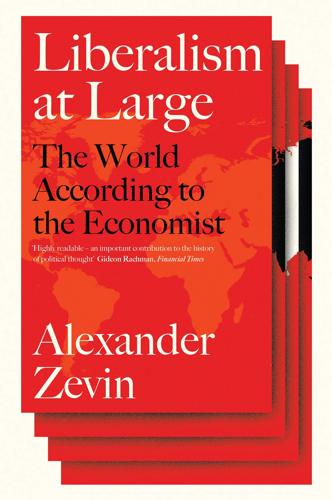
Liberalism at Large: The World According to the Economist
by
Alex Zevin
Published 12 Nov 2019
III, pp. 609–10. 68.Forgetting itself for a moment, the Economist deplored ‘the disturbing, revolutionary effect caused by the sudden growth of an enormously aggressive capitalism in a heretofore stagnant and conservative community’, ‘the evolution of giant monopolies’, which had left ‘society, all institutions … hypnotised’: ‘England and the Transvaal’, 10 June 1899. 69.‘Chamberlain is supposed to be an adherent of what is called the new diplomacy, which, like the new journalism, the new women, and many other novelties, is not altogether an improvement on the old.’ ‘The Transvaal and the New Diplomacy’, 2 September 1899. 70.‘Just as the British and Dutch were fused in the earlier history of New York’: ‘Mr Chamberlain’s Deliverance’, 3 April 1897. Boers were white, an economic and cultural argument against fighting them, since they were capable of instituting the proper kind of political economy.
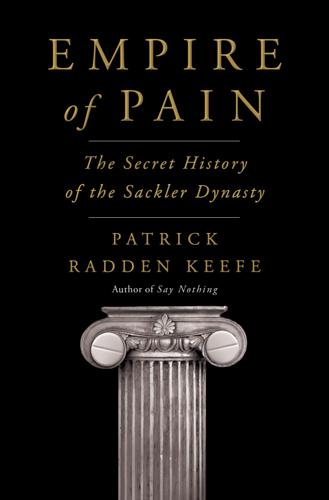
Empire of Pain: The Secret History of the Sackler Dynasty
by
Patrick Radden Keefe
Published 12 Apr 2021
They are letters between Henry Welch and Arthur Sackler. “Dear Dr. Sackler,” Welch wrote on February 23, 1956, “I was very glad to have the opportunity to talk with you by phone and sorry that we could not get together on my recent trip to New York.” Welch proceeds to ask Sackler for “a little outside help” in funding a new journal. “I would very much like to meet you and get to know you better,” Sackler wrote back, five days later. Three years after that, when Welch’s troubles started, Arthur wrote to him again. “I would like to tell you at a time of trial that you have many friends, who…stand shoulder to shoulder with you.
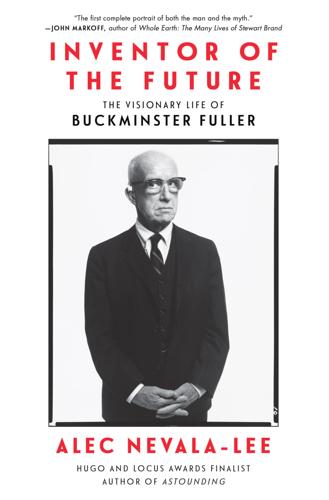
Inventor of the Future: The Visionary Life of Buckminster Fuller
by
Alec Nevala-Lee
Published 1 Aug 2022
twenty feet across: RBF, “Later Development of My Work,” in BFR, 83–84. “first of his subsequently multiannual circuits”: RBF, CP, 389. Toward the end of his life, RBF claimed that he had traveled more than 3.5 million miles and gone around the world forty-seven times (ibid., 131). Spitz Laboratories: “50 to Visit Planetarium,” News Journal (Wilmington, DE), July 12, 1957, 6, and Marks, 192. Berger Brothers: Marks, 202. “moon hut”: Advertisement for American Legion and Swift & Company Space Show, Boston Globe, June 10, 1958. domed shopping district: Wong, 399–400. panels kept shattering: Wigley, Buckminster Fuller Inc., 206. “Now, I’ve been talking”: Edgar W.
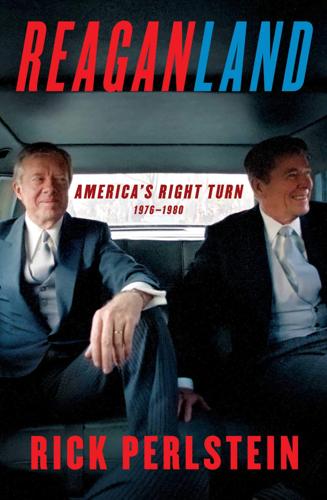
Reaganland: America's Right Turn 1976-1980
by
Rick Perlstein
Published 17 Aug 2020
holding celebrities liable UPI, June 12, 1981. funeral homes Pertschuk, Revolt Against Regulation, 60, 98; Washington Post Service, February 20, 1977; UPI, February 28, 1979; AP, March 23, 1979; James J. Kilpatrick column, November 28, 1978. feet of shelf space “Thousands Protest Against Children’s Advertising,” Longview News-Journal, January 7, 1979. A war chest “Foes of Child Ads Curbs Devised Strategy Here,” Washington Star, March 7, 1979. opened in San Francisco “Thousands Protest Against Children’s Advertising”; AP, January 16, 1979; UPI, January 16, 1979; Los Angeles Times Service, January 16, 1979; “Saturday Morning Hard Sell: FTC Maintains TV Advertising Exploits Children,” Jackson Sun, January 28, 1979.
…
awful TV commercial Curson interview, Fresh Air, WHYY, 1980; Kathleen Hall Jamieson, Packaging the Presidency: A History and Criticism of Presidential Advertising (New York: Oxford University Press, 1988), 388. surprise Kennedy endorser Ibid., 386. next-door Delaware Branko Marcitec, Yesterday’s Man: The Case Against Joe Biden (New York: Verso, 2020), 47; “Biden Heeds Carter Call to Go to Pennsylvania,” Wilmington News Journal, April 20, 1980. Chrysler said “1980 in Michigan,” Wikipedia.org. Open Markets Committee Schreft, “Credit Controls: 1980”; for April 22 minutes see Fraser.StLouisFed.org, April 24, 1980. The score stood White, America In Search of Itself, 301. Democrat in West Allis “Reagan’s Crossovers,” Newsweek, April 14, 1980.
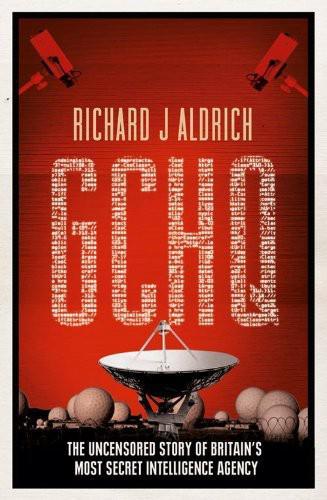
GCHQ
by
Richard Aldrich
Published 10 Jun 2010
Although they were ‘very friendly’, they said they had no choice but to keep to the ‘party line’, and told Welchman that he must not give away the ‘methodological secrets’ of code-breaking.83 Welchman went ahead regardless. When he finally ‘sprung’ his book on GCHQ in 1982, it was horrified. Entitled The Hut Six Story, it first appeared in the United States in order to evade censorship. Welchman continued to publish on code-breaking history, and in 1985 he wrote an article in a new journal founded by the historians Christopher Andrew and Michael Handel which would soon become the premier outlet for the new field of intelligence history. Welchman followed proper procedure and submitted his article to the D-Notice Committee, which requested no deletions. However, a few days later he received a stiff letter from the new Director of GCHQ that spoke of the ‘great shock’ his book had caused at GCHQ, and claimed his writings had done ‘direct damage to security’ and had ‘let us down’.
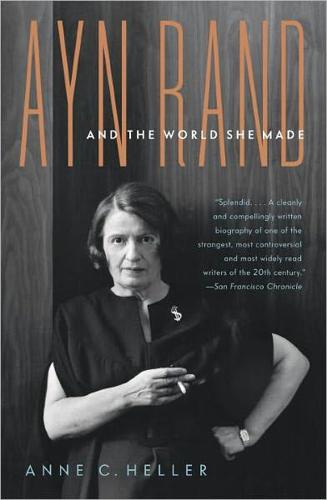
Ayn Rand and the World She Made
by
Anne C. Heller
Published 27 Oct 2009
chronicles of the period bear her out: An especially interesting view is provided by Kai Bird and Martin J. Sherwin in American Prometheus: The Triumph and Tragedy of J. Robert Oppenheimer (New York: Random House, 2005). “practically in every line”: Letter to DeWitt Emery, May 17, 1943 (LOAR, pp. 72–77). other publications gradually took it up: For example, Mansfield [Ohio] News-Journal, July 8, 1943, p. 8. “individualism” would re-enter the language: BBTBI. Ogden lacked the power: BBTBI. The public mood “is going our way”: Letter to DeWitt Emory, May 17, 1943 (LOAR, pp. 72–77); letter to Lorine Pruette, May 18, 1943 (LOAR, p. 75). wait to collect any royalties: BBTBI. she estimated the ten thousand dollars she needed: Letter to Monroe Shakespeare, November 16, 1943 (LOAR, p. 100).
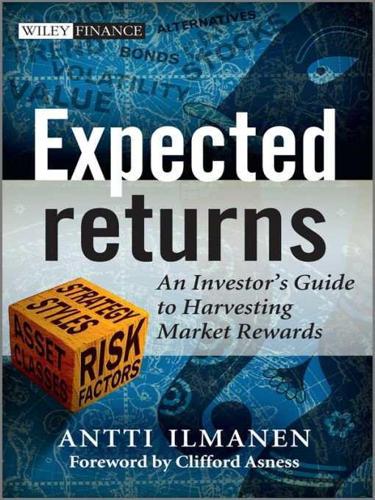
Expected Returns: An Investor's Guide to Harvesting Market Rewards
by
Antti Ilmanen
Published 4 Apr 2011
Ibbotson (2009), “Contrasting real estate with comparable investments, 1978 to 2008,” Journal of Portfolio Management 36(1), 141–155. Franzoni, Francesco A.; Eric Nowak; and Ludovic Phalippou (2010), “Private equity and liquidity risk,” Swiss Finance Institute working paper. Frazzini, Andrea (2006), “The disposition effect and underreaction to news,” Journal of Finance 61(4), 2017–2046. Frazzini, Andrea; and Owen A. Lamont (2008), “Dumb money: Mutual fund flows and the cross-section of stock returns,” Journal of Financial Economics 88, 299–322. Frazzini, Andrea; and Lasse H. Pedersen (2010), “Betting against beta,” AQR Capital Management working paper.
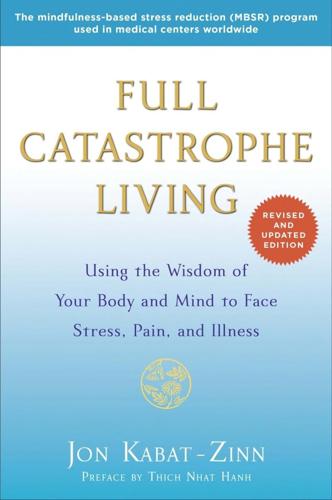
Full Catastrophe Living (Revised Edition): Using the Wisdom of Your Body and Mind to Face Stress, Pain, and Illness
by
Jon Kabat-Zinn
Published 23 Sep 2013
They did so expressing a virtually unanimous hope that their personal experiences with the meditation practice and the MBSR curriculum might help inspire others who suffer from similar life challenges to find wellbeing, peace, and relief in their lives. * Jim interviewed me and several physician colleagues who teach mindfulness for the inaugural issue of a new journal, The Medical Round Table. Dalen J; Kabat-Zinn, J; Krasner M; and Sibinga E. Guidance clinicians can give their patients for identifying and reducing stress. The Medical Round Table 2012, 1: 7-16. Appendix Awareness Calendars Reading List Resources Guided Mindfulness Meditation Practice CDs with Jon Kabat-Zinn: Ordering Information Awareness of Pleasant or Unpleasant Events Calendar Instructions: One week, be aware of one pleasant event or occurrence each day while it is happening.
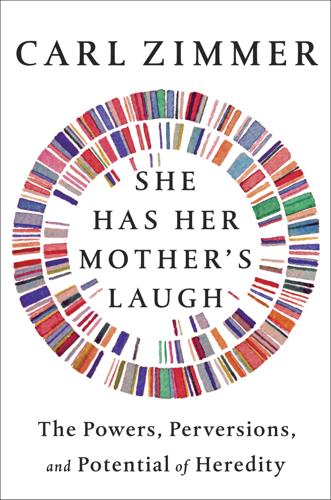
She Has Her Mother's Laugh
by
Carl Zimmer
Published 29 May 2018
Internet memes get knocked out of the spotlight by the next amusement, the next horror. The Nastyass Honey Badger never taught anyone how to eat nardoo. Dawkins had broader ambitions for memes, to explain everything from technology to religion. But those ambitions have mostly gone unmet. The Journal of Memetics shut down in 2005, and no new journal took its place. Many researchers who study culture decided memes were too superficial to help them dig deeper. In 2003, the Stanford scientists Paul Ehrlich and Marcus Feldman went so far as to declare memes ready for their scientific funeral. “Identifying the basic mechanisms by which our culture evolves will be difficult,” they said.
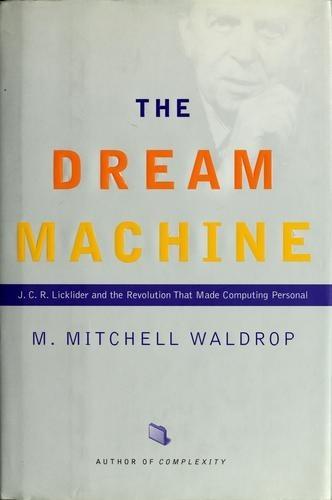
The Dream Machine: J.C.R. Licklider and the Revolution That Made Computing Personal
by
M. Mitchell Waldrop
Published 14 Apr 2001
But it did make him the integrator and synthesizer, the one who was doing as much as or more than any of the others to envision what a fully computerized world might be like, to imagine what interactivity might mean in human terms, to articulate where computers were going and what researchers would have to do to get there. In short, Lick was the one who provided the road map. The paper was basically written as a favor, remembers Jerry Elkind. In the fall of 1959, about the same time DEC was setting up its prototype PDP-1 in the lobby, Elkind had agreed to edit a new journal called IRE Transactions on Human Factors in Electronics (IRE was the Institute for Radio Engineers, a professional as- 176 THE DREAM MACHINE sociation that has since been renamed the Institute for Electrical and Electronics Engineers, or IEEE). "So for the first issue I wanted a lead article that would speak to the future of human factors, not to the past," he explains.
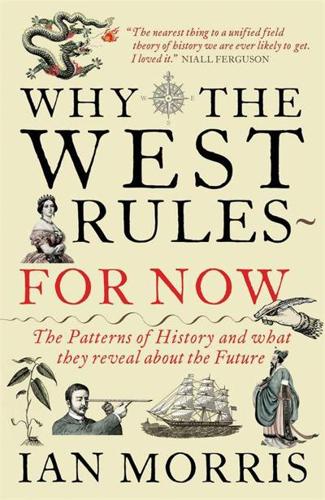
Why the West Rules--For Now: The Patterns of History, and What They Reveal About the Future
by
Ian Morris
Published 11 Oct 2010
First in Paris, then more widely, wealthy women sponsored salons where scholars rubbed shoulders with the mighty and new thinking moved back and forth. Amateurs established discussion clubs, inviting lecturers to explain new ideas and demonstrate experiments. Cheaper printing, better distribution, and rising literacy allowed new journals, combining reporting with social criticism and readers’ letters, to spread the ferment to tens of thousands of readers. Three centuries before Starbucks, enterprising coffeehouse owners realized that if they provided free newspapers and comfortable chairs, patrons would sit there—reading, arguing, and buying coffee—all day long.
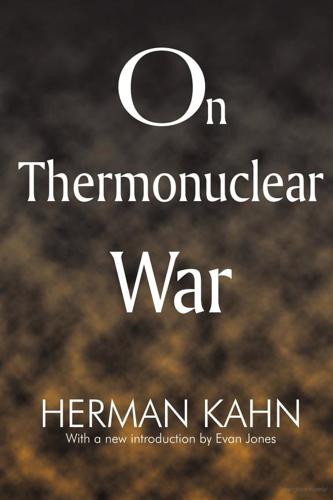
On Thermonuclear War
by
Herman Kahn
Published 16 Jul 2007
In discussing this problem, I will assume that in 1957 the Strategic Air Command was normally stationed on about twenty-five bases.1 The Russians announced in August 1957 that they had tested an intercontinental ballistic missile, and in October 1957 they launched their first Sputnik. At the same time there were many stories in United States news journals and magazines to the effect that the Russians had had a very vigorous ballistic missile program for many years and had developed reliable intermediate and short-range missiles. This indicated to many people that the Russians might possess a rather advanced missile technology and that it might only be a few years, if the Russians went into a crash program, before they might have quite a large number of reliable ICBM's in their operational force.
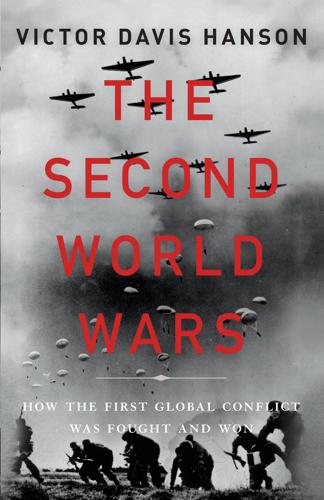
The Second World Wars: How the First Global Conflict Was Fought and Won
by
Victor Davis Hanson
Published 16 Oct 2017
His genius at domestic politics, again comparable to that of Hitler and Stalin, was in appreciating the power of propaganda, especially ideologically driven journalism, and the opportunities for mass manipulation, given the general social chaos unleashed by the aftermath of World War I and the economic downturn of the late 1920s and early 1930s. Truth and falsity were not the touchstones of the new journalism; mass dissemination and sensationalism were.38 Like Stalin and Hitler, as a veteran of war Mussolini saw raw violence not just as a necessary but also as a welcome tool of political advancement, both at home and abroad, although again to be applied against weak countries without anticipation that stronger ones might intervene.

Presidents of War
by
Michael Beschloss
Published 8 Oct 2018
CHAPTER FOURTEEN: “I AM GOING TO LET THEM HAVE IT” Kenneth Shadrick and his death, and family reaction: Time, July 17, 1950; NYT, July 6, 1950, and June 21, 1951; Clarksburg Exponent-Telegram (WV), July 4, 2004; Beckley Post-Herald (WV), July 7, 1950; Cumberland Evening Times (MD), June 25, 1951; Portsmouth Herald (NH) and Morning Herald (Hagerstown, MD), July 7, 1950; Berkshire Eagle, July 7, 1950; Mansfield News-Journal (OH), Jan. 25, 1951; Wright, pp. 133–134, 138. Leroy Shadrick: Port Angeles Evening News (WA) and Gadsden Times, Jan. 6, 1957; Alexandria Times-Tribune, Jan. 4, 1957; Raleigh Register (Beckley, WV), Oct. 21, 1957. “Ban on women correspondents”: Brands, General, p. 127. “If any nut tries”: NYT and Los Angeles Times, Dec. 28, 1952.
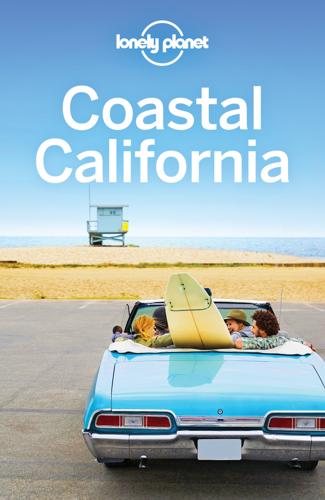
Coastal California Travel Guide
by
Lonely Planet
But no author has captured California culture with such unflinching clarity as Joan Didion, whose prose burns through the page like sun on a misty California morning. Her collection of literary nonfiction essays Slouching Towards Bethlehem captures 1960s flower power at the exact moment it blooms and wilts. Didion pioneered immersive first-person New Journalism with fellow ’60s California chroniclers Hunter S Thompson (Hells Angels: A Strange and Terrible Saga) and Tom Wolfe (The Electric Kool-Aid Acid Test). In the 1970s, Charles Bukowski’s semiautobiographical novel Post Office captured down-and-out Downtown LA, while Richard Vasquez’ Chicano took a dramatic look at LA’s Latino barrio.
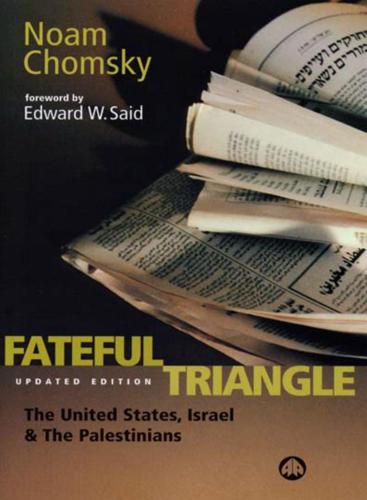
Fateful Triangle: The United States, Israel, and the Palestinians (Updated Edition) (South End Press Classics Series)
by
Noam Chomsky
Published 1 Apr 1999
Knesset Member Amnon Rubinstein brought up in the Knesset the issue of “terrifying incidents in Ansar,” alleging that “intolerable conditions that are a stain on Israel’s reputation” prevail in the camp: “Prisoners walk about barefoot in the severe cold and there have been many incidents of assaults against them.”156 In the United States, little has been said about the topic. We return to the Israeli response to an Amnesty International appeal on the matter. Israeli soldiers returning from duty in Lebanon in the reserves add more to the picture. One, a student at Tel Aviv University, reports what he saw in Koteret Rashit (a new journal with Labor support, including many Labor doves). In 1978, he had been arrested in Argentina on suspicion of spying and had spent ten days in an Argentine prison, but had seen nothing there to compare with what he found in the IDF headquarters in Sidon in January 1983, where he spent a month. At Classics in Politics: The Fateful Triangle Noam Chomsky Peace for Galilee 411 least 10 people were arrested each day and forced to perform menial labor for the IDF and the Israeli Border Guards, cleaning latrines and private quarters, washing floors, etc.
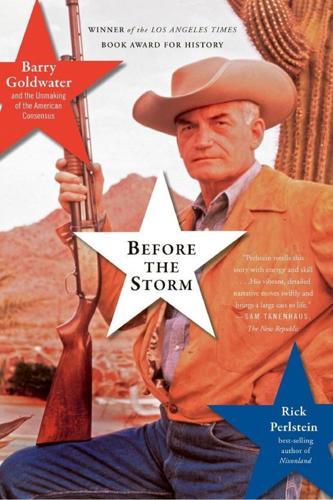
Before the Storm: Barry Goldwater and the Unmaking of the American Consensus
by
Rick Perlstein
Published 17 Mar 2009
Meanwhile Willi Schlamm, a brilliant ex-Communist expatriate of the Luce empire, was witnessing at close range the crackup of an earlier attempt at a mass-circulation conservative magazine, The Freeman, for which he served as literary editor. One faction of editors sought to remain aloof from unseemly day-to-day political battles in Washington, while another—Schlamm’s—yearned to engage them. The magazine folded from the strain. Schlamm was all ready to settle into his next job, editing a new journal of high-minded reflection on current events for Henry Luce, when Luce got cold feet during the 1954 recession. Schlamm, left at the altar, and Buckley, all dressed up with no place to go, discovered one another, and National Review was born. Or at least a business plan was born. It offered two classes of stock.
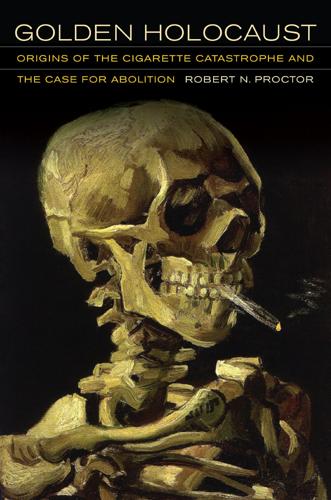
Golden Holocaust: Origins of the Cigarette Catastrophe and the Case for Abolition
by
Robert N. Proctor
Published 28 Feb 2012
German tobacco magnates also tried to capture a kind of scientific high ground by establishing journals, research bodies, and honorific academies dedicated to glorifying tobacco. An industry-friendly Institute for Tobacco Research in Forchheim had existed since the 1920s, along with two prominent tobacco trade journals, the Deutsche Tabakzeitung and Süddeutsche Zeitung. Nazi health fears prompted the creation in 1937 of a new journal devoted principally to defending the golden weed, Der Tabak, redubbed Chronica Nicotiana in 1940 with aspirations to be “the global journal of tobacco.” An International Association for Scientific Tobacco Research was established in Bremen in 1938 to coordinate the industry’s counterpunch, which included sponsorship of an international tobacco congress and an annual Prize for Progress in Tobacco Research.
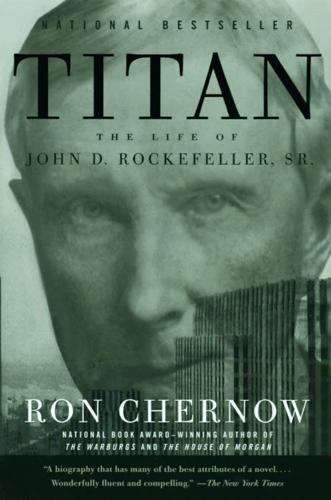
Titan: The Life of John D. Rockefeller, Sr.
by
Ron Chernow
Published 1 Jan 1997
According to Gates, Harper flouted several clear understandings with Rockefeller: that the university would never be indebted; would never use endowment funds for university buildings; and would never form an alliance with any medical college in Chicago. When Gates put these points in writing and asked Harper to circulate them to board members, they mysteriously disappeared. When he remonstrated with Harper for hiring more expensive professors and launching new journals, the university president simply ignored him. Soon after Gates insisted that he forgo new buildings, Harper appealed to Chicago’s citizens to support a new building campaign. Just as Rockefeller feared, Harper had rashly leaped straight from a small college to a big university. As Harper rolled up deficits, his patron kept adding millions to the endowment, but he could only be pushed so far.
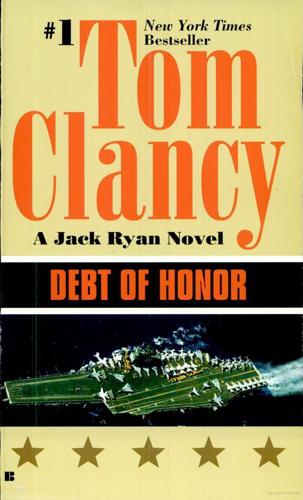
Debt of Honor
by
Tom Clancy
Published 2 Jan 1994
The sky-news radio channel had held his interest for the forty minutes required to update him on the happenings of the world, but after that it became repetitive, and his memory was too finely trained to need that. The KAL magazine was only good for thirty minutes—even that was a stretch—and he was current on the American news journals. What remained was crushing boredom. At least Ding had his course material to divert him. He was currently reading through the Masseys' classic Dreadnought, about how international relations had broken down a century earlier because the various European nations—more properly their leaders—had failed to make the leap of imagination required to keep the peace.
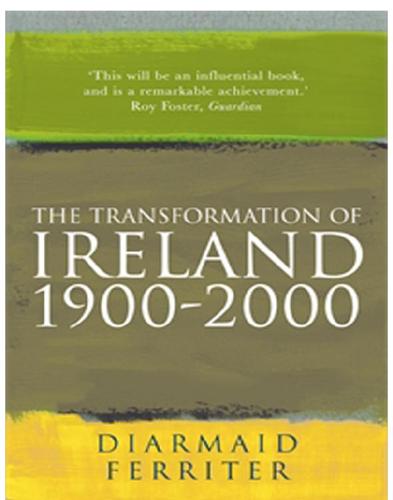
The Transformation Of Ireland 1900-2000
by
Diarmaid Ferriter
Published 15 Jul 2009
If regeneration was the philosophy at work at this stage, this too could be divisive, perhaps because the perpetration of the idea that, in order to proclaim an ancient ‘organic’ Gaelic society, serious criticisms of the shortcomings of contemporary society were necessary. Thus Daniel Corkery rounded on the ‘Ascendancy’ perspective of professional historians who were, he felt, utterly removed from the ‘hidden’ (and thus real) Ireland. Likewise, D. P. Moran could be both creative as a pioneer of ‘new journalism’ in developing a framework for Ireland’s new Gaelic obsessions and obnoxious in his ridicule of those who did not do enough to match the demise of the Ascendancy class with a significantly robust assertion of a culture based on Catholic and Gaelic lives. The revival was a mass of contradictions, as indeed were those who sponsored and promoted it.
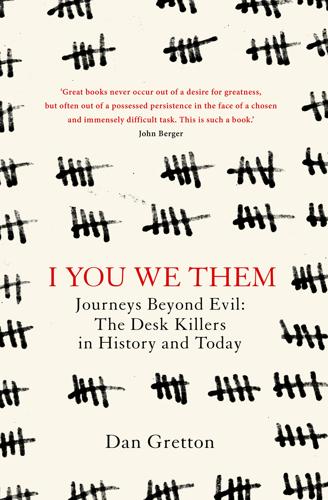
I You We Them
by
Dan Gretton
We know from Hannah Arendt that Eichmann and Heydrich also ‘expected the greatest difficulties’ in getting the agreement of some of the senior civil servants to the new proposal for the ‘Final Solution’. There are wide differences in the ideological backgrounds of the permanent secretaries and undersecretaries. While Heydrich felt that some – such as Klopfer and Stuckart, who only a few months before Wannsee had founded the new journal, Reich-Volksordnung-Lebensraum (‘Reich, Population Control, Living Space’) – could be relied upon, others were less trustworthy. He feels concerned that the general culture of the ministries is still not sufficiently ideologically committed to Nazism; it is known that some of the undersecretaries and legal experts had joined the party relatively late – after Hitler’s accession to power in 1933.
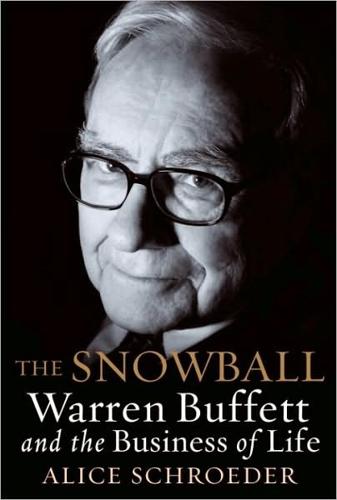
The Snowball: Warren Buffett and the Business of Life
by
Alice Schroeder
Published 1 Sep 2008
He grabbed stock in Booth Newspapers, Scripps Howard, and Harte-Hanks Communications, a San Antonio–based chain. The Sun’s elevated status as a Pulitzer Prize winner enabled him to network his way through the newspaper world, talking with publishers as one of their peers. He chatted up the owners of the Wilmington News Journal, hoping to buy the paper. Alas, while newspaper stocks were cheap because investors failed to see their value, newspaper owners were not so blind. Competing with them, Buffett and Munger’s efforts to buy whole newspapers had all come to naught. Still, by late spring 1973 Buffett had accumulated more than five percent of the Washington Post stock.6 He now sent a letter to Graham.